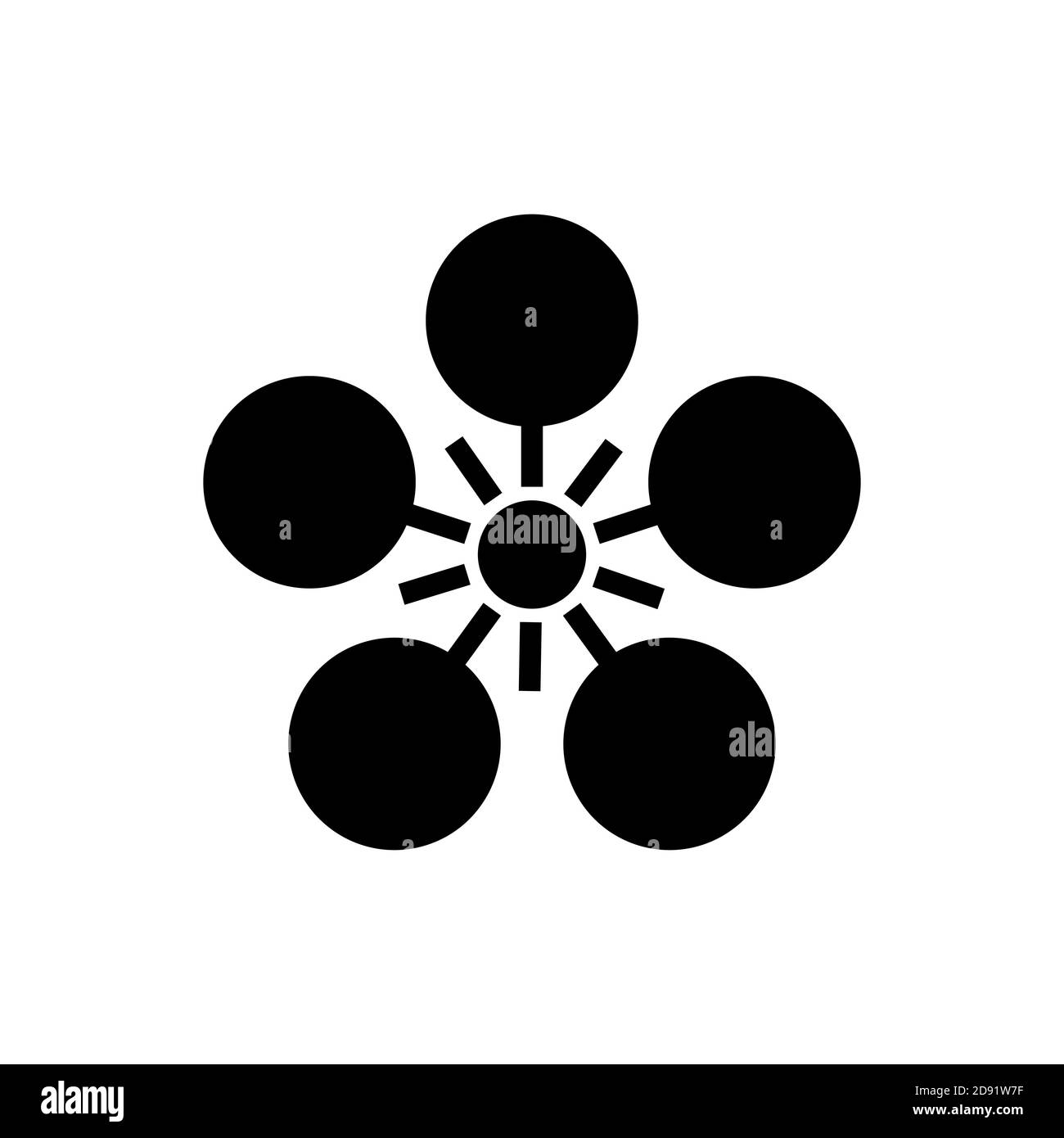Quick filters:
Tokugawa clan Stock Photos and Images
 Brief Account of the Rulers of the Tokugawa Clan, The ninth Shogun visited the newly build Shimizu's house by Toshimitsu. Stock Photohttps://www.alamy.com/image-license-details/?v=1https://www.alamy.com/brief-account-of-the-rulers-of-the-tokugawa-clan-the-ninth-shogun-visited-the-newly-build-shimizus-house-by-toshimitsu-image220631062.html
Brief Account of the Rulers of the Tokugawa Clan, The ninth Shogun visited the newly build Shimizu's house by Toshimitsu. Stock Photohttps://www.alamy.com/image-license-details/?v=1https://www.alamy.com/brief-account-of-the-rulers-of-the-tokugawa-clan-the-ninth-shogun-visited-the-newly-build-shimizus-house-by-toshimitsu-image220631062.htmlRMPPXH4P–Brief Account of the Rulers of the Tokugawa Clan, The ninth Shogun visited the newly build Shimizu's house by Toshimitsu.
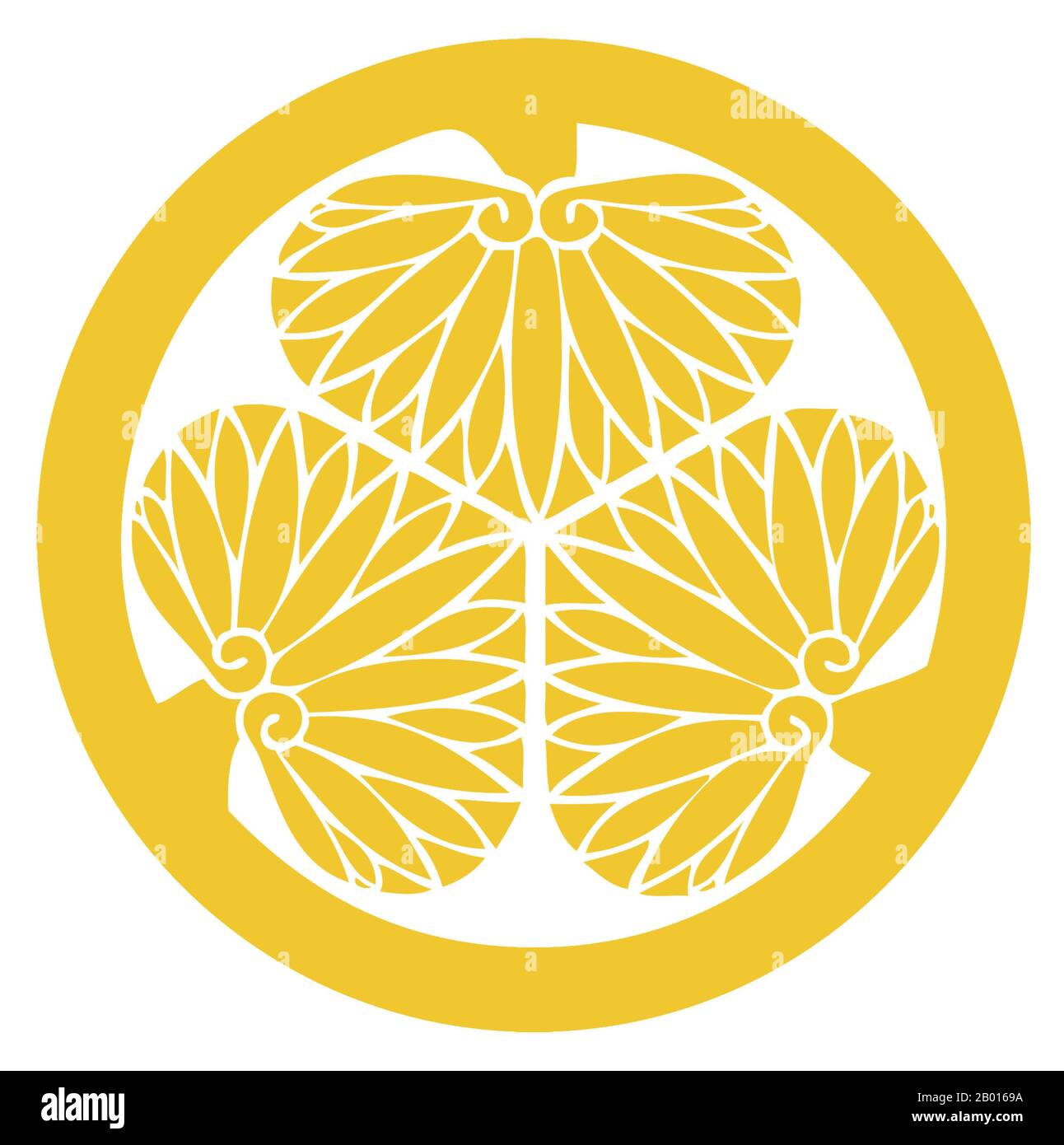 Japan: Crest of the Tokugawa Clan, rulers of the Tokugawa Shogunate (1600-1868). The Tokugawa clan was a powerful daimyo family. They are nominally descended from Emperor Seiwa (850–880) and were a branch of the Minamoto clan by the Nitta clan. The clan rose to power at the end of the Sengoku period, and to the end of the Edo period they ruled Japan as shoguns. In all, there were fifteen Tokugawa shoguns. Their dominance was so strong that some history books use the term 'Tokugawa era' instead of 'Edo period'. The clan's crest, known in Japanese as a mon, is the triple asarum or wild ginger. Stock Photohttps://www.alamy.com/image-license-details/?v=1https://www.alamy.com/japan-crest-of-the-tokugawa-clan-rulers-of-the-tokugawa-shogunate-1600-1868-the-tokugawa-clan-was-a-powerful-daimyo-family-they-are-nominally-descended-from-emperor-seiwa-850880-and-were-a-branch-of-the-minamoto-clan-by-the-nitta-clan-the-clan-rose-to-power-at-the-end-of-the-sengoku-period-and-to-the-end-of-the-edo-period-they-ruled-japan-as-shoguns-in-all-there-were-fifteen-tokugawa-shoguns-their-dominance-was-so-strong-that-some-history-books-use-the-term-tokugawa-era-instead-of-edo-period-the-clans-crest-known-in-japanese-as-a-mon-is-the-triple-asarum-or-wild-ginger-image344234278.html
Japan: Crest of the Tokugawa Clan, rulers of the Tokugawa Shogunate (1600-1868). The Tokugawa clan was a powerful daimyo family. They are nominally descended from Emperor Seiwa (850–880) and were a branch of the Minamoto clan by the Nitta clan. The clan rose to power at the end of the Sengoku period, and to the end of the Edo period they ruled Japan as shoguns. In all, there were fifteen Tokugawa shoguns. Their dominance was so strong that some history books use the term 'Tokugawa era' instead of 'Edo period'. The clan's crest, known in Japanese as a mon, is the triple asarum or wild ginger. Stock Photohttps://www.alamy.com/image-license-details/?v=1https://www.alamy.com/japan-crest-of-the-tokugawa-clan-rulers-of-the-tokugawa-shogunate-1600-1868-the-tokugawa-clan-was-a-powerful-daimyo-family-they-are-nominally-descended-from-emperor-seiwa-850880-and-were-a-branch-of-the-minamoto-clan-by-the-nitta-clan-the-clan-rose-to-power-at-the-end-of-the-sengoku-period-and-to-the-end-of-the-edo-period-they-ruled-japan-as-shoguns-in-all-there-were-fifteen-tokugawa-shoguns-their-dominance-was-so-strong-that-some-history-books-use-the-term-tokugawa-era-instead-of-edo-period-the-clans-crest-known-in-japanese-as-a-mon-is-the-triple-asarum-or-wild-ginger-image344234278.htmlRM2B0169A–Japan: Crest of the Tokugawa Clan, rulers of the Tokugawa Shogunate (1600-1868). The Tokugawa clan was a powerful daimyo family. They are nominally descended from Emperor Seiwa (850–880) and were a branch of the Minamoto clan by the Nitta clan. The clan rose to power at the end of the Sengoku period, and to the end of the Edo period they ruled Japan as shoguns. In all, there were fifteen Tokugawa shoguns. Their dominance was so strong that some history books use the term 'Tokugawa era' instead of 'Edo period'. The clan's crest, known in Japanese as a mon, is the triple asarum or wild ginger.
 Prince Tokugawa, Photograph shows Tokugawa lemasa (lyemosa) (1884-1963), the head of the Tokugawa clan in Japan., between ca. 1915 and ca. 1920, Glass negatives, 1 negative: glass Stock Photohttps://www.alamy.com/image-license-details/?v=1https://www.alamy.com/prince-tokugawa-photograph-shows-tokugawa-lemasa-lyemosa-1884-1963-the-head-of-the-tokugawa-clan-in-japan-between-ca-1915-and-ca-1920-glass-negatives-1-negative-glass-image599561679.html
Prince Tokugawa, Photograph shows Tokugawa lemasa (lyemosa) (1884-1963), the head of the Tokugawa clan in Japan., between ca. 1915 and ca. 1920, Glass negatives, 1 negative: glass Stock Photohttps://www.alamy.com/image-license-details/?v=1https://www.alamy.com/prince-tokugawa-photograph-shows-tokugawa-lemasa-lyemosa-1884-1963-the-head-of-the-tokugawa-clan-in-japan-between-ca-1915-and-ca-1920-glass-negatives-1-negative-glass-image599561679.htmlRM2WRCB13–Prince Tokugawa, Photograph shows Tokugawa lemasa (lyemosa) (1884-1963), the head of the Tokugawa clan in Japan., between ca. 1915 and ca. 1920, Glass negatives, 1 negative: glass
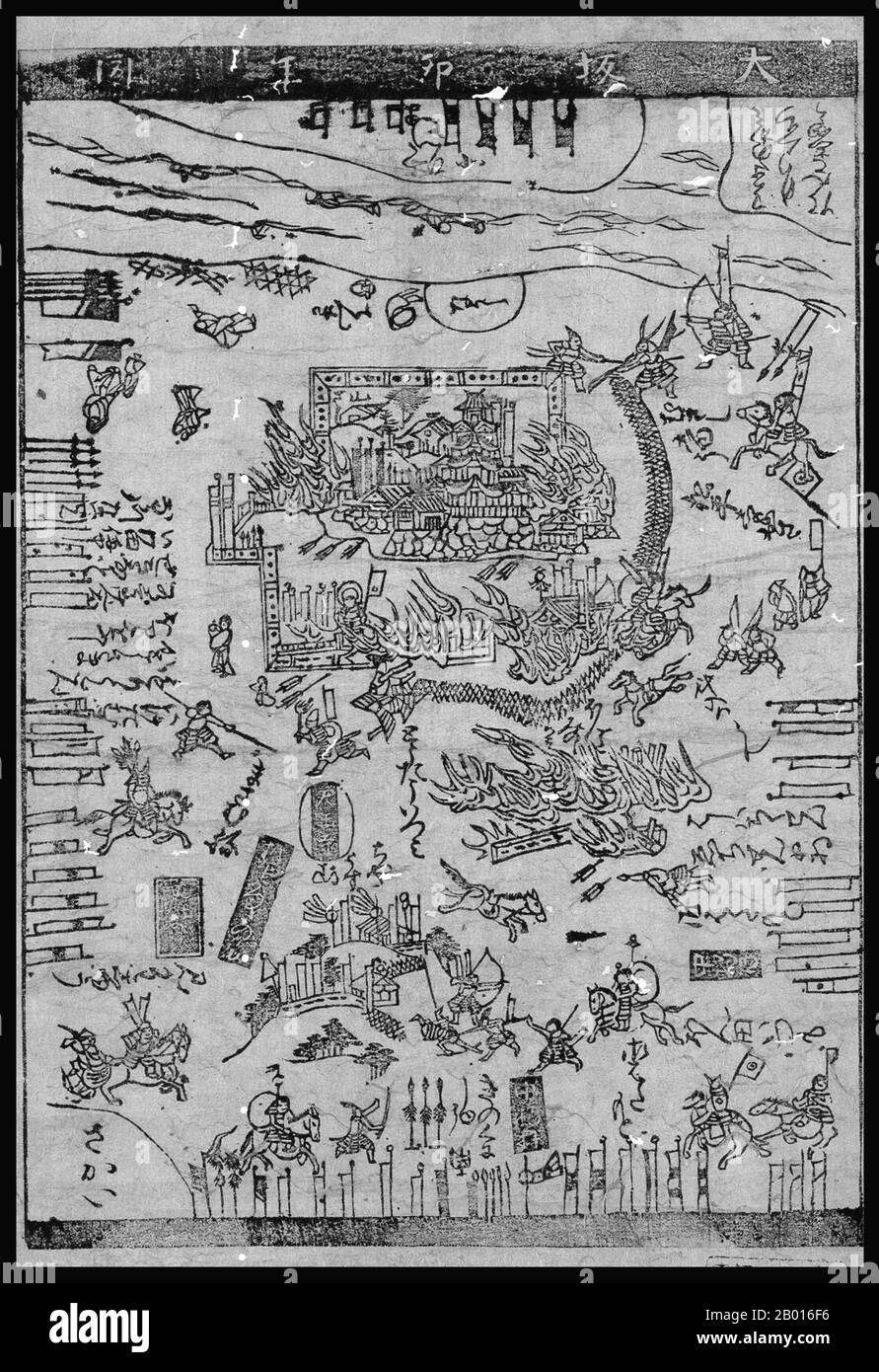 Japan: The siege of Osaka Castle (1615). A commercial newssheet of the Edo period reporting the fall of Osaka Castle, early 17th century. The Siege of Osaka was a series of battles undertaken by the Tokugawa shogunate against the Toyotomi clan, ending in that clan's destruction. Divided into two stages (Winter Campaign and Summer Campaign), and lasting from 1614 to 1615, the siege put an end to the last major armed opposition to the shogunate's establishment. The end of the conflict is sometimes called the Genna Armistice (Genna Enbu), because the era name was changed from Keichō to Genna. Stock Photohttps://www.alamy.com/image-license-details/?v=1https://www.alamy.com/japan-the-siege-of-osaka-castle-1615-a-commercial-newssheet-of-the-edo-period-reporting-the-fall-of-osaka-castle-early-17th-century-the-siege-of-osaka-was-a-series-of-battles-undertaken-by-the-tokugawa-shogunate-against-the-toyotomi-clan-ending-in-that-clans-destruction-divided-into-two-stages-winter-campaign-and-summer-campaign-and-lasting-from-1614-to-1615-the-siege-put-an-end-to-the-last-major-armed-opposition-to-the-shogunates-establishment-the-end-of-the-conflict-is-sometimes-called-the-genna-armistice-genna-enbu-because-the-era-name-was-changed-from-keich-to-genna-image344234442.html
Japan: The siege of Osaka Castle (1615). A commercial newssheet of the Edo period reporting the fall of Osaka Castle, early 17th century. The Siege of Osaka was a series of battles undertaken by the Tokugawa shogunate against the Toyotomi clan, ending in that clan's destruction. Divided into two stages (Winter Campaign and Summer Campaign), and lasting from 1614 to 1615, the siege put an end to the last major armed opposition to the shogunate's establishment. The end of the conflict is sometimes called the Genna Armistice (Genna Enbu), because the era name was changed from Keichō to Genna. Stock Photohttps://www.alamy.com/image-license-details/?v=1https://www.alamy.com/japan-the-siege-of-osaka-castle-1615-a-commercial-newssheet-of-the-edo-period-reporting-the-fall-of-osaka-castle-early-17th-century-the-siege-of-osaka-was-a-series-of-battles-undertaken-by-the-tokugawa-shogunate-against-the-toyotomi-clan-ending-in-that-clans-destruction-divided-into-two-stages-winter-campaign-and-summer-campaign-and-lasting-from-1614-to-1615-the-siege-put-an-end-to-the-last-major-armed-opposition-to-the-shogunates-establishment-the-end-of-the-conflict-is-sometimes-called-the-genna-armistice-genna-enbu-because-the-era-name-was-changed-from-keich-to-genna-image344234442.htmlRM2B016F6–Japan: The siege of Osaka Castle (1615). A commercial newssheet of the Edo period reporting the fall of Osaka Castle, early 17th century. The Siege of Osaka was a series of battles undertaken by the Tokugawa shogunate against the Toyotomi clan, ending in that clan's destruction. Divided into two stages (Winter Campaign and Summer Campaign), and lasting from 1614 to 1615, the siege put an end to the last major armed opposition to the shogunate's establishment. The end of the conflict is sometimes called the Genna Armistice (Genna Enbu), because the era name was changed from Keichō to Genna.
![[ 1890s Japan - Nagoya Castle ] — The honmaru (main enclosure) and the small tower of Nagoya Castle in Nagoya, Aichi Prefecture. The castle was the home base of the Owari Tokugawa clan, which ruled Japan during the Edo period (1603-1868). The castle was built between 1610 and 1619. It was destroyed by a US bombing raid in 1945. In 1959, a replica made of concrete was built. 19th century vintage albumen photograph. Stock Photo [ 1890s Japan - Nagoya Castle ] — The honmaru (main enclosure) and the small tower of Nagoya Castle in Nagoya, Aichi Prefecture. The castle was the home base of the Owari Tokugawa clan, which ruled Japan during the Edo period (1603-1868). The castle was built between 1610 and 1619. It was destroyed by a US bombing raid in 1945. In 1959, a replica made of concrete was built. 19th century vintage albumen photograph. Stock Photo](https://c8.alamy.com/comp/PH0ERG/1890s-japan-nagoya-castle-the-honmaru-main-enclosure-and-the-small-tower-of-nagoya-castle-in-nagoya-aichi-prefecture-the-castle-was-the-home-base-of-the-owari-tokugawa-clan-which-ruled-japan-during-the-edo-period-1603-1868-the-castle-was-built-between-1610-and-1619-it-was-destroyed-by-a-us-bombing-raid-in-1945-in-1959-a-replica-made-of-concrete-was-built-19th-century-vintage-albumen-photograph-PH0ERG.jpg) [ 1890s Japan - Nagoya Castle ] — The honmaru (main enclosure) and the small tower of Nagoya Castle in Nagoya, Aichi Prefecture. The castle was the home base of the Owari Tokugawa clan, which ruled Japan during the Edo period (1603-1868). The castle was built between 1610 and 1619. It was destroyed by a US bombing raid in 1945. In 1959, a replica made of concrete was built. 19th century vintage albumen photograph. Stock Photohttps://www.alamy.com/image-license-details/?v=1https://www.alamy.com/1890s-japan-nagoya-castle-the-honmaru-main-enclosure-and-the-small-tower-of-nagoya-castle-in-nagoya-aichi-prefecture-the-castle-was-the-home-base-of-the-owari-tokugawa-clan-which-ruled-japan-during-the-edo-period-1603-1868-the-castle-was-built-between-1610-and-1619-it-was-destroyed-by-a-us-bombing-raid-in-1945-in-1959-a-replica-made-of-concrete-was-built-19th-century-vintage-albumen-photograph-image216985204.html
[ 1890s Japan - Nagoya Castle ] — The honmaru (main enclosure) and the small tower of Nagoya Castle in Nagoya, Aichi Prefecture. The castle was the home base of the Owari Tokugawa clan, which ruled Japan during the Edo period (1603-1868). The castle was built between 1610 and 1619. It was destroyed by a US bombing raid in 1945. In 1959, a replica made of concrete was built. 19th century vintage albumen photograph. Stock Photohttps://www.alamy.com/image-license-details/?v=1https://www.alamy.com/1890s-japan-nagoya-castle-the-honmaru-main-enclosure-and-the-small-tower-of-nagoya-castle-in-nagoya-aichi-prefecture-the-castle-was-the-home-base-of-the-owari-tokugawa-clan-which-ruled-japan-during-the-edo-period-1603-1868-the-castle-was-built-between-1610-and-1619-it-was-destroyed-by-a-us-bombing-raid-in-1945-in-1959-a-replica-made-of-concrete-was-built-19th-century-vintage-albumen-photograph-image216985204.htmlRMPH0ERG–[ 1890s Japan - Nagoya Castle ] — The honmaru (main enclosure) and the small tower of Nagoya Castle in Nagoya, Aichi Prefecture. The castle was the home base of the Owari Tokugawa clan, which ruled Japan during the Edo period (1603-1868). The castle was built between 1610 and 1619. It was destroyed by a US bombing raid in 1945. In 1959, a replica made of concrete was built. 19th century vintage albumen photograph.
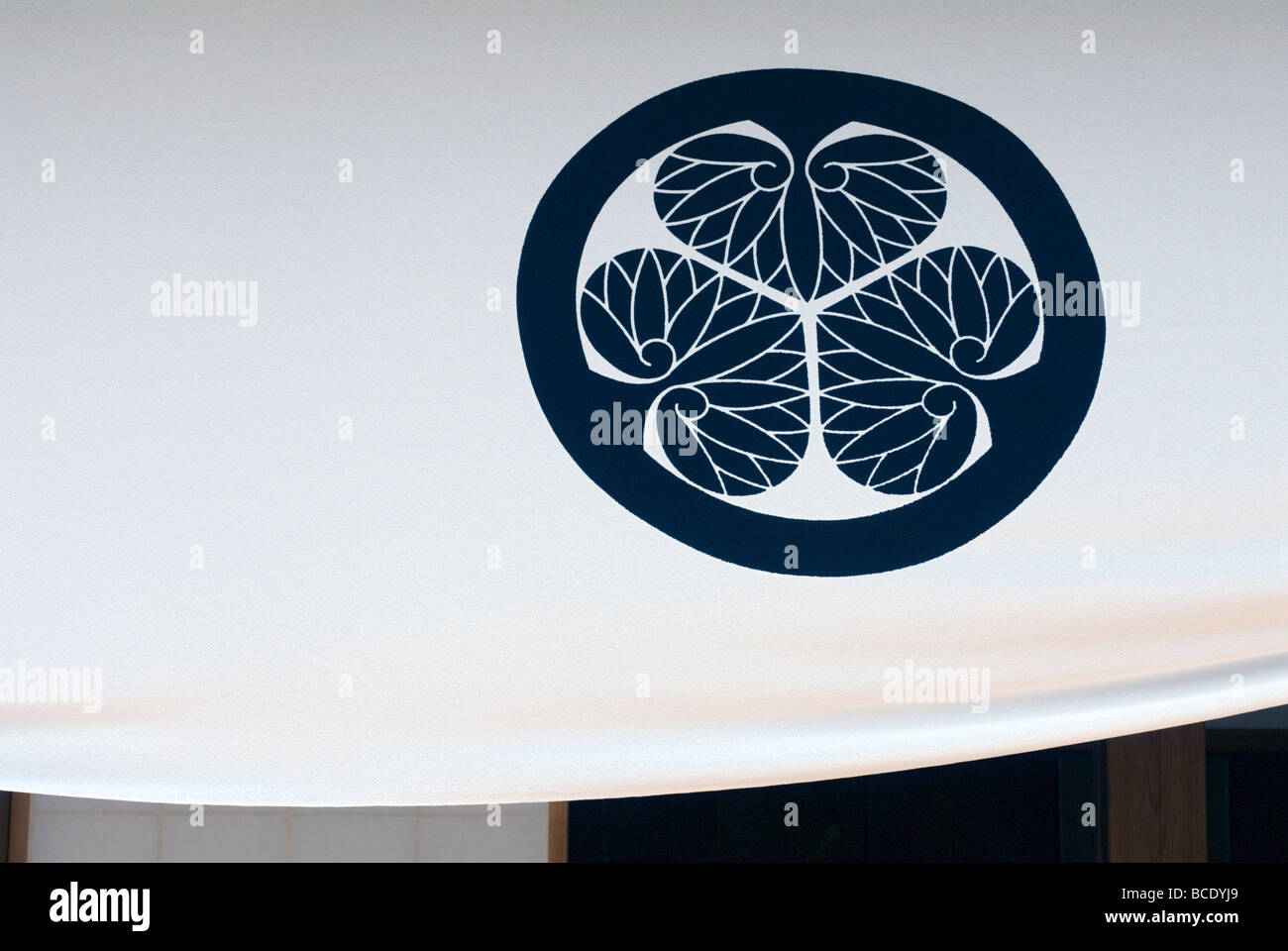 The Mitsuba Aoi or triple hollyhock family crest of the famous Tokugawa clan the powerful daimyo and last shogun of Japan Stock Photohttps://www.alamy.com/image-license-details/?v=1https://www.alamy.com/stock-photo-the-mitsuba-aoi-or-triple-hollyhock-family-crest-of-the-famous-tokugawa-24893297.html
The Mitsuba Aoi or triple hollyhock family crest of the famous Tokugawa clan the powerful daimyo and last shogun of Japan Stock Photohttps://www.alamy.com/image-license-details/?v=1https://www.alamy.com/stock-photo-the-mitsuba-aoi-or-triple-hollyhock-family-crest-of-the-famous-tokugawa-24893297.htmlRMBCDYJ9–The Mitsuba Aoi or triple hollyhock family crest of the famous Tokugawa clan the powerful daimyo and last shogun of Japan
![[ 1890s Japan - Nagoya Castle ] — The honmaru (main enclosure) of Nagoya Castle in Nagoya, Aichi Prefecture. The castle was the home base of the Owari Tokugawa clan, which ruled Japan during the Edo period (1603-1868). The castle was built between 1610 and 1619. It was destroyed by a US bombing raid in 1945. In 1959, a replica made of concrete was built. 19th century vintage glass slide. Stock Photo [ 1890s Japan - Nagoya Castle ] — The honmaru (main enclosure) of Nagoya Castle in Nagoya, Aichi Prefecture. The castle was the home base of the Owari Tokugawa clan, which ruled Japan during the Edo period (1603-1868). The castle was built between 1610 and 1619. It was destroyed by a US bombing raid in 1945. In 1959, a replica made of concrete was built. 19th century vintage glass slide. Stock Photo](https://c8.alamy.com/comp/W33E4J/1890s-japan-nagoya-castle-the-honmaru-main-enclosure-of-nagoya-castle-in-nagoya-aichi-prefecture-the-castle-was-the-home-base-of-the-owari-tokugawa-clan-which-ruled-japan-during-the-edo-period-1603-1868-the-castle-was-built-between-1610-and-1619-it-was-destroyed-by-a-us-bombing-raid-in-1945-in-1959-a-replica-made-of-concrete-was-built-19th-century-vintage-glass-slide-W33E4J.jpg) [ 1890s Japan - Nagoya Castle ] — The honmaru (main enclosure) of Nagoya Castle in Nagoya, Aichi Prefecture. The castle was the home base of the Owari Tokugawa clan, which ruled Japan during the Edo period (1603-1868). The castle was built between 1610 and 1619. It was destroyed by a US bombing raid in 1945. In 1959, a replica made of concrete was built. 19th century vintage glass slide. Stock Photohttps://www.alamy.com/image-license-details/?v=1https://www.alamy.com/1890s-japan-nagoya-castle-the-honmaru-main-enclosure-of-nagoya-castle-in-nagoya-aichi-prefecture-the-castle-was-the-home-base-of-the-owari-tokugawa-clan-which-ruled-japan-during-the-edo-period-1603-1868-the-castle-was-built-between-1610-and-1619-it-was-destroyed-by-a-us-bombing-raid-in-1945-in-1959-a-replica-made-of-concrete-was-built-19th-century-vintage-glass-slide-image260076450.html
[ 1890s Japan - Nagoya Castle ] — The honmaru (main enclosure) of Nagoya Castle in Nagoya, Aichi Prefecture. The castle was the home base of the Owari Tokugawa clan, which ruled Japan during the Edo period (1603-1868). The castle was built between 1610 and 1619. It was destroyed by a US bombing raid in 1945. In 1959, a replica made of concrete was built. 19th century vintage glass slide. Stock Photohttps://www.alamy.com/image-license-details/?v=1https://www.alamy.com/1890s-japan-nagoya-castle-the-honmaru-main-enclosure-of-nagoya-castle-in-nagoya-aichi-prefecture-the-castle-was-the-home-base-of-the-owari-tokugawa-clan-which-ruled-japan-during-the-edo-period-1603-1868-the-castle-was-built-between-1610-and-1619-it-was-destroyed-by-a-us-bombing-raid-in-1945-in-1959-a-replica-made-of-concrete-was-built-19th-century-vintage-glass-slide-image260076450.htmlRMW33E4J–[ 1890s Japan - Nagoya Castle ] — The honmaru (main enclosure) of Nagoya Castle in Nagoya, Aichi Prefecture. The castle was the home base of the Owari Tokugawa clan, which ruled Japan during the Edo period (1603-1868). The castle was built between 1610 and 1619. It was destroyed by a US bombing raid in 1945. In 1959, a replica made of concrete was built. 19th century vintage glass slide.
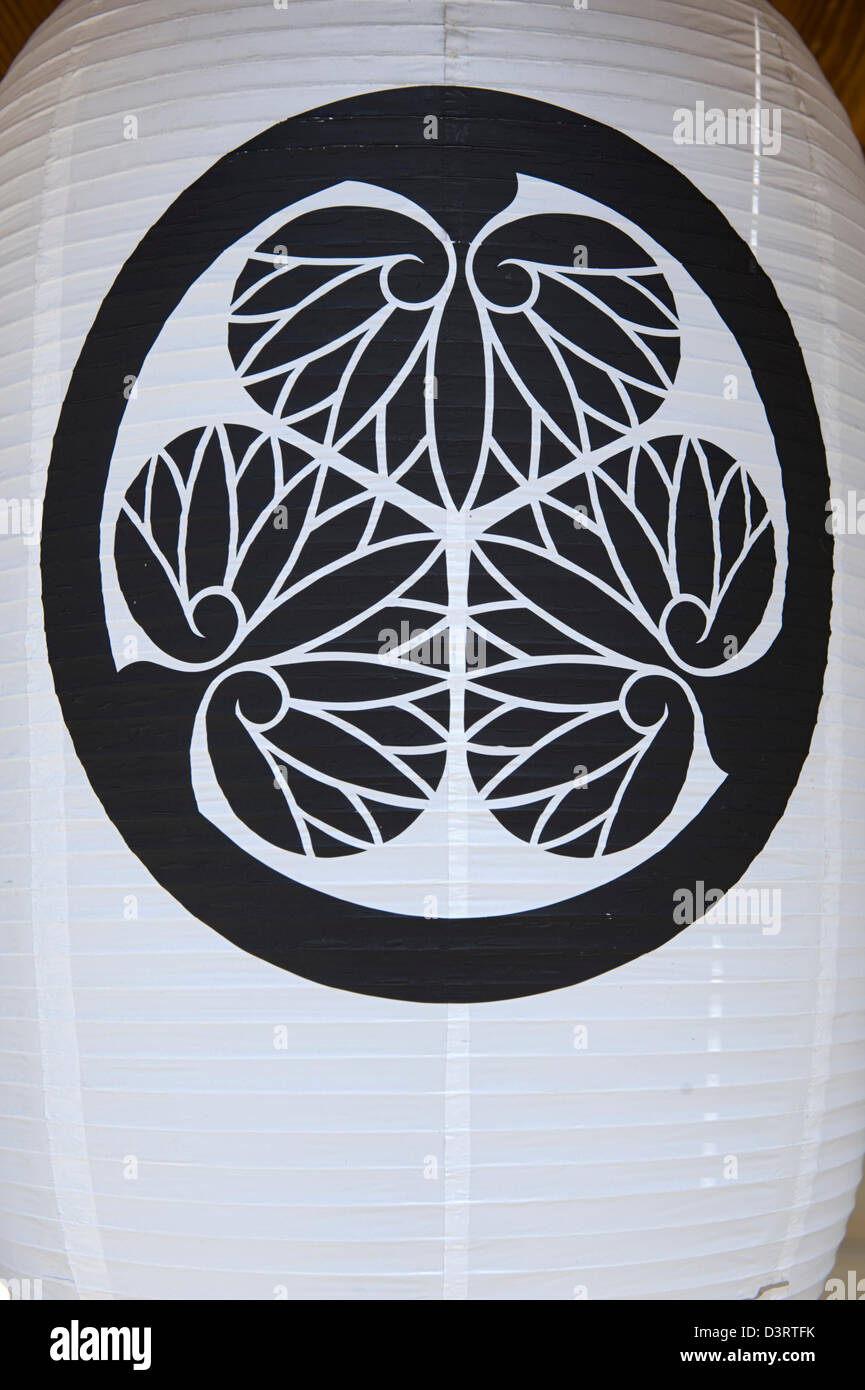 White paper chochin lantern with Tokugawa clan family crest 'mitsuba aoi' or 'maruni mitsu aoi' (three-leaf hollyhock in circle) Stock Photohttps://www.alamy.com/image-license-details/?v=1https://www.alamy.com/stock-photo-white-paper-chochin-lantern-with-tokugawa-clan-family-crest-mitsuba-53999223.html
White paper chochin lantern with Tokugawa clan family crest 'mitsuba aoi' or 'maruni mitsu aoi' (three-leaf hollyhock in circle) Stock Photohttps://www.alamy.com/image-license-details/?v=1https://www.alamy.com/stock-photo-white-paper-chochin-lantern-with-tokugawa-clan-family-crest-mitsuba-53999223.htmlRMD3RTFK–White paper chochin lantern with Tokugawa clan family crest 'mitsuba aoi' or 'maruni mitsu aoi' (three-leaf hollyhock in circle)
![[ 1890s Japan - Nagoya Castle ] — Nagoya Castle in Nagoya, Aichi Prefecture. The castle was the home base of the Owari Tokugawa clan, which ruled Japan during the Edo period (1603-1868). The castle was built between 1610 and 1619. It was destroyed by a US bombing raid in 1945 (Showa 20). In 1959 (Showa 34), a replica made of concrete was built. 19th century vintage albumen photograph. Stock Photo [ 1890s Japan - Nagoya Castle ] — Nagoya Castle in Nagoya, Aichi Prefecture. The castle was the home base of the Owari Tokugawa clan, which ruled Japan during the Edo period (1603-1868). The castle was built between 1610 and 1619. It was destroyed by a US bombing raid in 1945 (Showa 20). In 1959 (Showa 34), a replica made of concrete was built. 19th century vintage albumen photograph. Stock Photo](https://c8.alamy.com/comp/W48YP3/1890s-japan-nagoya-castle-nagoya-castle-in-nagoya-aichi-prefecture-the-castle-was-the-home-base-of-the-owari-tokugawa-clan-which-ruled-japan-during-the-edo-period-1603-1868-the-castle-was-built-between-1610-and-1619-it-was-destroyed-by-a-us-bombing-raid-in-1945-showa-20-in-1959-showa-34-a-replica-made-of-concrete-was-built-19th-century-vintage-albumen-photograph-W48YP3.jpg) [ 1890s Japan - Nagoya Castle ] — Nagoya Castle in Nagoya, Aichi Prefecture. The castle was the home base of the Owari Tokugawa clan, which ruled Japan during the Edo period (1603-1868). The castle was built between 1610 and 1619. It was destroyed by a US bombing raid in 1945 (Showa 20). In 1959 (Showa 34), a replica made of concrete was built. 19th century vintage albumen photograph. Stock Photohttps://www.alamy.com/image-license-details/?v=1https://www.alamy.com/1890s-japan-nagoya-castle-nagoya-castle-in-nagoya-aichi-prefecture-the-castle-was-the-home-base-of-the-owari-tokugawa-clan-which-ruled-japan-during-the-edo-period-1603-1868-the-castle-was-built-between-1610-and-1619-it-was-destroyed-by-a-us-bombing-raid-in-1945-showa-20-in-1959-showa-34-a-replica-made-of-concrete-was-built-19th-century-vintage-albumen-photograph-image260811547.html
[ 1890s Japan - Nagoya Castle ] — Nagoya Castle in Nagoya, Aichi Prefecture. The castle was the home base of the Owari Tokugawa clan, which ruled Japan during the Edo period (1603-1868). The castle was built between 1610 and 1619. It was destroyed by a US bombing raid in 1945 (Showa 20). In 1959 (Showa 34), a replica made of concrete was built. 19th century vintage albumen photograph. Stock Photohttps://www.alamy.com/image-license-details/?v=1https://www.alamy.com/1890s-japan-nagoya-castle-nagoya-castle-in-nagoya-aichi-prefecture-the-castle-was-the-home-base-of-the-owari-tokugawa-clan-which-ruled-japan-during-the-edo-period-1603-1868-the-castle-was-built-between-1610-and-1619-it-was-destroyed-by-a-us-bombing-raid-in-1945-showa-20-in-1959-showa-34-a-replica-made-of-concrete-was-built-19th-century-vintage-albumen-photograph-image260811547.htmlRMW48YP3–[ 1890s Japan - Nagoya Castle ] — Nagoya Castle in Nagoya, Aichi Prefecture. The castle was the home base of the Owari Tokugawa clan, which ruled Japan during the Edo period (1603-1868). The castle was built between 1610 and 1619. It was destroyed by a US bombing raid in 1945 (Showa 20). In 1959 (Showa 34), a replica made of concrete was built. 19th century vintage albumen photograph.
 Koyasan, Koya, Ito District, Wakayama, Japan, 2022/03/05 , Tokugawa Clan Mausoleum. From grandfather to son. Set apart from the other religious sites Stock Photohttps://www.alamy.com/image-license-details/?v=1https://www.alamy.com/koyasan-koya-ito-district-wakayama-japan-20220305-tokugawa-clan-mausoleum-from-grandfather-to-son-set-apart-from-the-other-religious-sites-image470620634.html
Koyasan, Koya, Ito District, Wakayama, Japan, 2022/03/05 , Tokugawa Clan Mausoleum. From grandfather to son. Set apart from the other religious sites Stock Photohttps://www.alamy.com/image-license-details/?v=1https://www.alamy.com/koyasan-koya-ito-district-wakayama-japan-20220305-tokugawa-clan-mausoleum-from-grandfather-to-son-set-apart-from-the-other-religious-sites-image470620634.htmlRF2J9JHBP–Koyasan, Koya, Ito District, Wakayama, Japan, 2022/03/05 , Tokugawa Clan Mausoleum. From grandfather to son. Set apart from the other religious sites
![[ 1890s Japan - Nagoya Castle ] — The honmaru (main enclosure) and the small tower of Nagoya Castle in Nagoya, Aichi Prefecture. The castle was the home base of the Owari Tokugawa clan, which ruled Japan during the Edo period (1603-1868). The castle was built between 1610 and 1619. It was destroyed by a US bombing raid in 1945. In 1959, a replica made of concrete was built. 19th century vintage albumen photograph. Stock Photo [ 1890s Japan - Nagoya Castle ] — The honmaru (main enclosure) and the small tower of Nagoya Castle in Nagoya, Aichi Prefecture. The castle was the home base of the Owari Tokugawa clan, which ruled Japan during the Edo period (1603-1868). The castle was built between 1610 and 1619. It was destroyed by a US bombing raid in 1945. In 1959, a replica made of concrete was built. 19th century vintage albumen photograph. Stock Photo](https://c8.alamy.com/comp/W13JH7/1890s-japan-nagoya-castle-the-honmaru-main-enclosure-and-the-small-tower-of-nagoya-castle-in-nagoya-aichi-prefecture-the-castle-was-the-home-base-of-the-owari-tokugawa-clan-which-ruled-japan-during-the-edo-period-1603-1868-the-castle-was-built-between-1610-and-1619-it-was-destroyed-by-a-us-bombing-raid-in-1945-in-1959-a-replica-made-of-concrete-was-built-19th-century-vintage-albumen-photograph-W13JH7.jpg) [ 1890s Japan - Nagoya Castle ] — The honmaru (main enclosure) and the small tower of Nagoya Castle in Nagoya, Aichi Prefecture. The castle was the home base of the Owari Tokugawa clan, which ruled Japan during the Edo period (1603-1868). The castle was built between 1610 and 1619. It was destroyed by a US bombing raid in 1945. In 1959, a replica made of concrete was built. 19th century vintage albumen photograph. Stock Photohttps://www.alamy.com/image-license-details/?v=1https://www.alamy.com/1890s-japan-nagoya-castle-the-honmaru-main-enclosure-and-the-small-tower-of-nagoya-castle-in-nagoya-aichi-prefecture-the-castle-was-the-home-base-of-the-owari-tokugawa-clan-which-ruled-japan-during-the-edo-period-1603-1868-the-castle-was-built-between-1610-and-1619-it-was-destroyed-by-a-us-bombing-raid-in-1945-in-1959-a-replica-made-of-concrete-was-built-19th-century-vintage-albumen-photograph-image258850627.html
[ 1890s Japan - Nagoya Castle ] — The honmaru (main enclosure) and the small tower of Nagoya Castle in Nagoya, Aichi Prefecture. The castle was the home base of the Owari Tokugawa clan, which ruled Japan during the Edo period (1603-1868). The castle was built between 1610 and 1619. It was destroyed by a US bombing raid in 1945. In 1959, a replica made of concrete was built. 19th century vintage albumen photograph. Stock Photohttps://www.alamy.com/image-license-details/?v=1https://www.alamy.com/1890s-japan-nagoya-castle-the-honmaru-main-enclosure-and-the-small-tower-of-nagoya-castle-in-nagoya-aichi-prefecture-the-castle-was-the-home-base-of-the-owari-tokugawa-clan-which-ruled-japan-during-the-edo-period-1603-1868-the-castle-was-built-between-1610-and-1619-it-was-destroyed-by-a-us-bombing-raid-in-1945-in-1959-a-replica-made-of-concrete-was-built-19th-century-vintage-albumen-photograph-image258850627.htmlRMW13JH7–[ 1890s Japan - Nagoya Castle ] — The honmaru (main enclosure) and the small tower of Nagoya Castle in Nagoya, Aichi Prefecture. The castle was the home base of the Owari Tokugawa clan, which ruled Japan during the Edo period (1603-1868). The castle was built between 1610 and 1619. It was destroyed by a US bombing raid in 1945. In 1959, a replica made of concrete was built. 19th century vintage albumen photograph.
 Tokugawa Family Crest Stock Photohttps://www.alamy.com/image-license-details/?v=1https://www.alamy.com/tokugawa-family-crest-image593627163.html
Tokugawa Family Crest Stock Photohttps://www.alamy.com/image-license-details/?v=1https://www.alamy.com/tokugawa-family-crest-image593627163.htmlRM2WDP1E3–Tokugawa Family Crest
![[ 1890s Japan - Nagoya Castle ] — The honmaru (main enclosure) and the small tower of Nagoya Castle in Nagoya, Aichi Prefecture. The castle was the home base of the Owari Tokugawa clan, which ruled Japan during the Edo period (1603-1868), and was built between 1610 and 1619. From a series of glass slides published (but not photographed) by Scottish photographer George Washington Wilson (1823–1893). Wilson’s firm was one of the largest publishers of photographic prints in the world. 19th century vintage glass slide. Stock Photo [ 1890s Japan - Nagoya Castle ] — The honmaru (main enclosure) and the small tower of Nagoya Castle in Nagoya, Aichi Prefecture. The castle was the home base of the Owari Tokugawa clan, which ruled Japan during the Edo period (1603-1868), and was built between 1610 and 1619. From a series of glass slides published (but not photographed) by Scottish photographer George Washington Wilson (1823–1893). Wilson’s firm was one of the largest publishers of photographic prints in the world. 19th century vintage glass slide. Stock Photo](https://c8.alamy.com/comp/2BMYDHN/1890s-japan-nagoya-castle-the-honmaru-main-enclosure-and-the-small-tower-of-nagoya-castle-in-nagoya-aichi-prefecture-the-castle-was-the-home-base-of-the-owari-tokugawa-clan-which-ruled-japan-during-the-edo-period-1603-1868-and-was-built-between-1610-and-1619-from-a-series-of-glass-slides-published-but-not-photographed-by-scottish-photographer-george-washington-wilson-18231893-wilsons-firm-was-one-of-the-largest-publishers-of-photographic-prints-in-the-world-19th-century-vintage-glass-slide-2BMYDHN.jpg) [ 1890s Japan - Nagoya Castle ] — The honmaru (main enclosure) and the small tower of Nagoya Castle in Nagoya, Aichi Prefecture. The castle was the home base of the Owari Tokugawa clan, which ruled Japan during the Edo period (1603-1868), and was built between 1610 and 1619. From a series of glass slides published (but not photographed) by Scottish photographer George Washington Wilson (1823–1893). Wilson’s firm was one of the largest publishers of photographic prints in the world. 19th century vintage glass slide. Stock Photohttps://www.alamy.com/image-license-details/?v=1https://www.alamy.com/1890s-japan-nagoya-castle-the-honmaru-main-enclosure-and-the-small-tower-of-nagoya-castle-in-nagoya-aichi-prefecture-the-castle-was-the-home-base-of-the-owari-tokugawa-clan-which-ruled-japan-during-the-edo-period-1603-1868-and-was-built-between-1610-and-1619-from-a-series-of-glass-slides-published-but-not-photographed-by-scottish-photographer-george-washington-wilson-18231893-wilsons-firm-was-one-of-the-largest-publishers-of-photographic-prints-in-the-world-19th-century-vintage-glass-slide-image357103873.html
[ 1890s Japan - Nagoya Castle ] — The honmaru (main enclosure) and the small tower of Nagoya Castle in Nagoya, Aichi Prefecture. The castle was the home base of the Owari Tokugawa clan, which ruled Japan during the Edo period (1603-1868), and was built between 1610 and 1619. From a series of glass slides published (but not photographed) by Scottish photographer George Washington Wilson (1823–1893). Wilson’s firm was one of the largest publishers of photographic prints in the world. 19th century vintage glass slide. Stock Photohttps://www.alamy.com/image-license-details/?v=1https://www.alamy.com/1890s-japan-nagoya-castle-the-honmaru-main-enclosure-and-the-small-tower-of-nagoya-castle-in-nagoya-aichi-prefecture-the-castle-was-the-home-base-of-the-owari-tokugawa-clan-which-ruled-japan-during-the-edo-period-1603-1868-and-was-built-between-1610-and-1619-from-a-series-of-glass-slides-published-but-not-photographed-by-scottish-photographer-george-washington-wilson-18231893-wilsons-firm-was-one-of-the-largest-publishers-of-photographic-prints-in-the-world-19th-century-vintage-glass-slide-image357103873.htmlRM2BMYDHN–[ 1890s Japan - Nagoya Castle ] — The honmaru (main enclosure) and the small tower of Nagoya Castle in Nagoya, Aichi Prefecture. The castle was the home base of the Owari Tokugawa clan, which ruled Japan during the Edo period (1603-1868), and was built between 1610 and 1619. From a series of glass slides published (but not photographed) by Scottish photographer George Washington Wilson (1823–1893). Wilson’s firm was one of the largest publishers of photographic prints in the world. 19th century vintage glass slide.
 Torii Kyoemon (or Yaemon) Katsutaga Standing by a Moat, 1875. Series: Exploits of the Tokugawa Clan. Stock Photohttps://www.alamy.com/image-license-details/?v=1https://www.alamy.com/torii-kyoemon-or-yaemon-katsutaga-standing-by-a-moat-1875-series-exploits-of-the-tokugawa-clan-image571913226.html
Torii Kyoemon (or Yaemon) Katsutaga Standing by a Moat, 1875. Series: Exploits of the Tokugawa Clan. Stock Photohttps://www.alamy.com/image-license-details/?v=1https://www.alamy.com/torii-kyoemon-or-yaemon-katsutaga-standing-by-a-moat-1875-series-exploits-of-the-tokugawa-clan-image571913226.htmlRM2T6CW4A–Torii Kyoemon (or Yaemon) Katsutaga Standing by a Moat, 1875. Series: Exploits of the Tokugawa Clan.
 Samurai helmet (kabuto) decorated with curls, owned by the Owari Tokugawa clan, Edo period, 17th century Stock Photohttps://www.alamy.com/image-license-details/?v=1https://www.alamy.com/samurai-helmet-kabuto-decorated-with-curls-owned-by-the-owari-tokugawa-clan-edo-period-17th-century-image327645417.html
Samurai helmet (kabuto) decorated with curls, owned by the Owari Tokugawa clan, Edo period, 17th century Stock Photohttps://www.alamy.com/image-license-details/?v=1https://www.alamy.com/samurai-helmet-kabuto-decorated-with-curls-owned-by-the-owari-tokugawa-clan-edo-period-17th-century-image327645417.htmlRF2A11F21–Samurai helmet (kabuto) decorated with curls, owned by the Owari Tokugawa clan, Edo period, 17th century
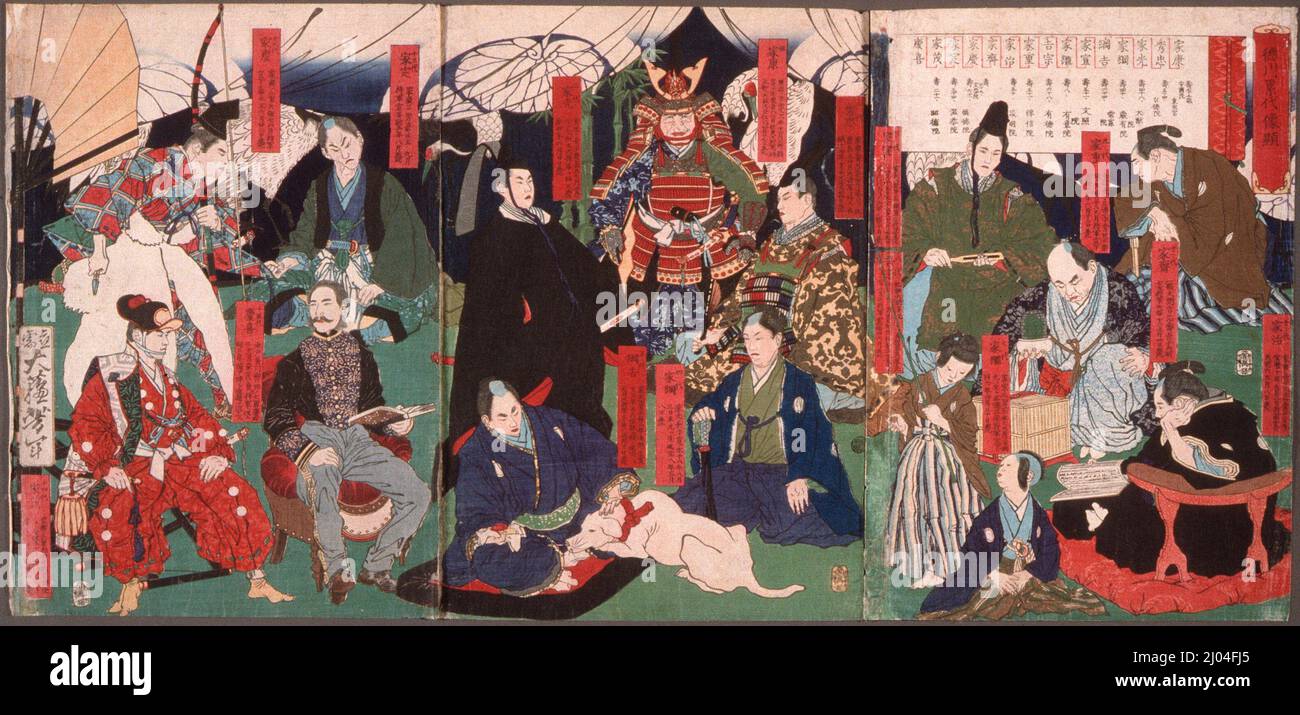 Portraits of the generations of the Tokugawa clan. Tsukioka Yoshitoshi (Japan, 1839-1892). Japan, circa 1878. Prints; woodblocks. Triptych; color woodblock prints Stock Photohttps://www.alamy.com/image-license-details/?v=1https://www.alamy.com/portraits-of-the-generations-of-the-tokugawa-clan-tsukioka-yoshitoshi-japan-1839-1892-japan-circa-1878-prints-woodblocks-triptych-color-woodblock-prints-image464780013.html
Portraits of the generations of the Tokugawa clan. Tsukioka Yoshitoshi (Japan, 1839-1892). Japan, circa 1878. Prints; woodblocks. Triptych; color woodblock prints Stock Photohttps://www.alamy.com/image-license-details/?v=1https://www.alamy.com/portraits-of-the-generations-of-the-tokugawa-clan-tsukioka-yoshitoshi-japan-1839-1892-japan-circa-1878-prints-woodblocks-triptych-color-woodblock-prints-image464780013.htmlRM2J04FJ5–Portraits of the generations of the Tokugawa clan. Tsukioka Yoshitoshi (Japan, 1839-1892). Japan, circa 1878. Prints; woodblocks. Triptych; color woodblock prints
 An antique paiting on wood of the Siege of Osaka Castle during the wars between the Tokugawa shogunate and the Toyotomi clan. The paiting shows 5071 people and 21 generals Stock Photohttps://www.alamy.com/image-license-details/?v=1https://www.alamy.com/an-antique-paiting-on-wood-of-the-siege-of-osaka-castle-during-the-wars-between-the-tokugawa-shogunate-and-the-toyotomi-clan-the-paiting-shows-5071-people-and-21-generals-image457574651.html
An antique paiting on wood of the Siege of Osaka Castle during the wars between the Tokugawa shogunate and the Toyotomi clan. The paiting shows 5071 people and 21 generals Stock Photohttps://www.alamy.com/image-license-details/?v=1https://www.alamy.com/an-antique-paiting-on-wood-of-the-siege-of-osaka-castle-during-the-wars-between-the-tokugawa-shogunate-and-the-toyotomi-clan-the-paiting-shows-5071-people-and-21-generals-image457574651.htmlRM2HGC93R–An antique paiting on wood of the Siege of Osaka Castle during the wars between the Tokugawa shogunate and the Toyotomi clan. The paiting shows 5071 people and 21 generals
 ESPADE de Samurai or Katana (1846). Espadda. Chounsai Tsuna Toshi is an important teacher of the Shinshinto Kouka San Nen Shi Gatsu Jitsu period (one day of the fourth month of the third year of the Kouka era, April 1846). The Aoi Gô Mon Heraldic emblem is a branch of the Tokugawa clan, founded by the Tokugawa shogún, Iyeyasu in the seventeenth century. Garrison formed by a wooden handle, covered with silver placites stamped with the emblem 'Ao Gô Mon'. This decoration is repeated in the 'saya' pod, performed in the same way. The guard, called 'Tsuba', is made in overdied silver, in which a wo Stock Photohttps://www.alamy.com/image-license-details/?v=1https://www.alamy.com/espade-de-samurai-or-katana-1846-espadda-chounsai-tsuna-toshi-is-an-important-teacher-of-the-shinshinto-kouka-san-nen-shi-gatsu-jitsu-period-one-day-of-the-fourth-month-of-the-third-year-of-the-kouka-era-april-1846-the-aoi-g-mon-heraldic-emblem-is-a-branch-of-the-tokugawa-clan-founded-by-the-tokugawa-shogn-iyeyasu-in-the-seventeenth-century-garrison-formed-by-a-wooden-handle-covered-with-silver-placites-stamped-with-the-emblem-ao-g-mon-this-decoration-is-repeated-in-the-saya-pod-performed-in-the-same-way-the-guard-called-tsuba-is-made-in-overdied-silver-in-which-a-wo-image474617639.html
ESPADE de Samurai or Katana (1846). Espadda. Chounsai Tsuna Toshi is an important teacher of the Shinshinto Kouka San Nen Shi Gatsu Jitsu period (one day of the fourth month of the third year of the Kouka era, April 1846). The Aoi Gô Mon Heraldic emblem is a branch of the Tokugawa clan, founded by the Tokugawa shogún, Iyeyasu in the seventeenth century. Garrison formed by a wooden handle, covered with silver placites stamped with the emblem 'Ao Gô Mon'. This decoration is repeated in the 'saya' pod, performed in the same way. The guard, called 'Tsuba', is made in overdied silver, in which a wo Stock Photohttps://www.alamy.com/image-license-details/?v=1https://www.alamy.com/espade-de-samurai-or-katana-1846-espadda-chounsai-tsuna-toshi-is-an-important-teacher-of-the-shinshinto-kouka-san-nen-shi-gatsu-jitsu-period-one-day-of-the-fourth-month-of-the-third-year-of-the-kouka-era-april-1846-the-aoi-g-mon-heraldic-emblem-is-a-branch-of-the-tokugawa-clan-founded-by-the-tokugawa-shogn-iyeyasu-in-the-seventeenth-century-garrison-formed-by-a-wooden-handle-covered-with-silver-placites-stamped-with-the-emblem-ao-g-mon-this-decoration-is-repeated-in-the-saya-pod-performed-in-the-same-way-the-guard-called-tsuba-is-made-in-overdied-silver-in-which-a-wo-image474617639.htmlRM2JG4KHY–ESPADE de Samurai or Katana (1846). Espadda. Chounsai Tsuna Toshi is an important teacher of the Shinshinto Kouka San Nen Shi Gatsu Jitsu period (one day of the fourth month of the third year of the Kouka era, April 1846). The Aoi Gô Mon Heraldic emblem is a branch of the Tokugawa clan, founded by the Tokugawa shogún, Iyeyasu in the seventeenth century. Garrison formed by a wooden handle, covered with silver placites stamped with the emblem 'Ao Gô Mon'. This decoration is repeated in the 'saya' pod, performed in the same way. The guard, called 'Tsuba', is made in overdied silver, in which a wo
 Tokugawas clan crest, the triple hollyhock or wild ginger as a golden emblem in the front tiles of roofs in Nikkos Tosho-gu, Japan October 2018 Stock Photohttps://www.alamy.com/image-license-details/?v=1https://www.alamy.com/tokugawas-clan-crest-the-triple-hollyhock-or-wild-ginger-as-a-golden-emblem-in-the-front-tiles-of-roofs-in-nikkos-tosho-gu-japan-october-2018-image261456890.html
Tokugawas clan crest, the triple hollyhock or wild ginger as a golden emblem in the front tiles of roofs in Nikkos Tosho-gu, Japan October 2018 Stock Photohttps://www.alamy.com/image-license-details/?v=1https://www.alamy.com/tokugawas-clan-crest-the-triple-hollyhock-or-wild-ginger-as-a-golden-emblem-in-the-front-tiles-of-roofs-in-nikkos-tosho-gu-japan-october-2018-image261456890.htmlRFW5AAX2–Tokugawas clan crest, the triple hollyhock or wild ginger as a golden emblem in the front tiles of roofs in Nikkos Tosho-gu, Japan October 2018
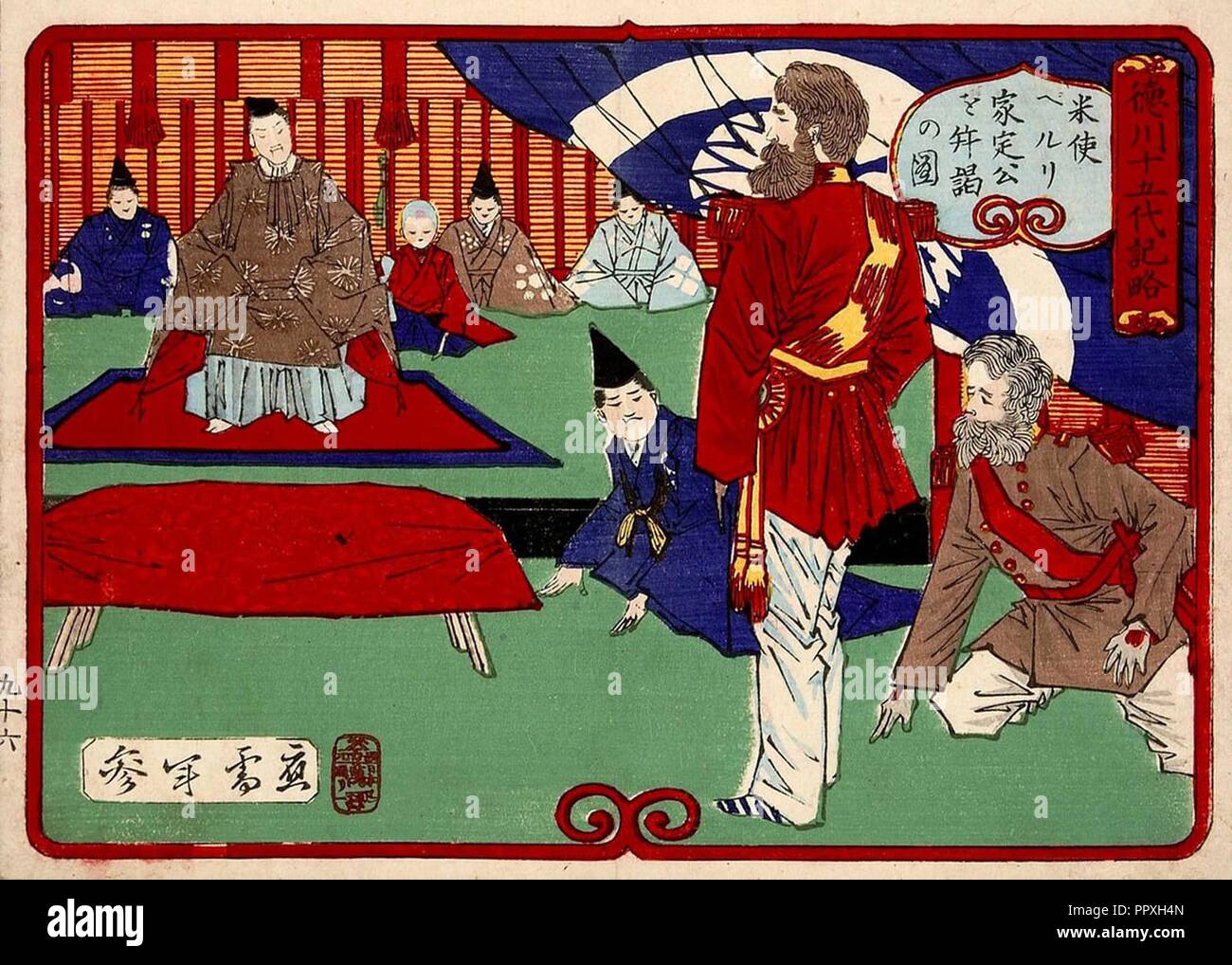 Brief Account of the Rulers of the Tokugawa Clan, Conference between Commodore Matthew C. Perry and Shogun Tokugawa Iesada by Toshimitsu. Stock Photohttps://www.alamy.com/image-license-details/?v=1https://www.alamy.com/brief-account-of-the-rulers-of-the-tokugawa-clan-conference-between-commodore-matthew-c-perry-and-shogun-tokugawa-iesada-by-toshimitsu-image220631061.html
Brief Account of the Rulers of the Tokugawa Clan, Conference between Commodore Matthew C. Perry and Shogun Tokugawa Iesada by Toshimitsu. Stock Photohttps://www.alamy.com/image-license-details/?v=1https://www.alamy.com/brief-account-of-the-rulers-of-the-tokugawa-clan-conference-between-commodore-matthew-c-perry-and-shogun-tokugawa-iesada-by-toshimitsu-image220631061.htmlRMPPXH4N–Brief Account of the Rulers of the Tokugawa Clan, Conference between Commodore Matthew C. Perry and Shogun Tokugawa Iesada by Toshimitsu.
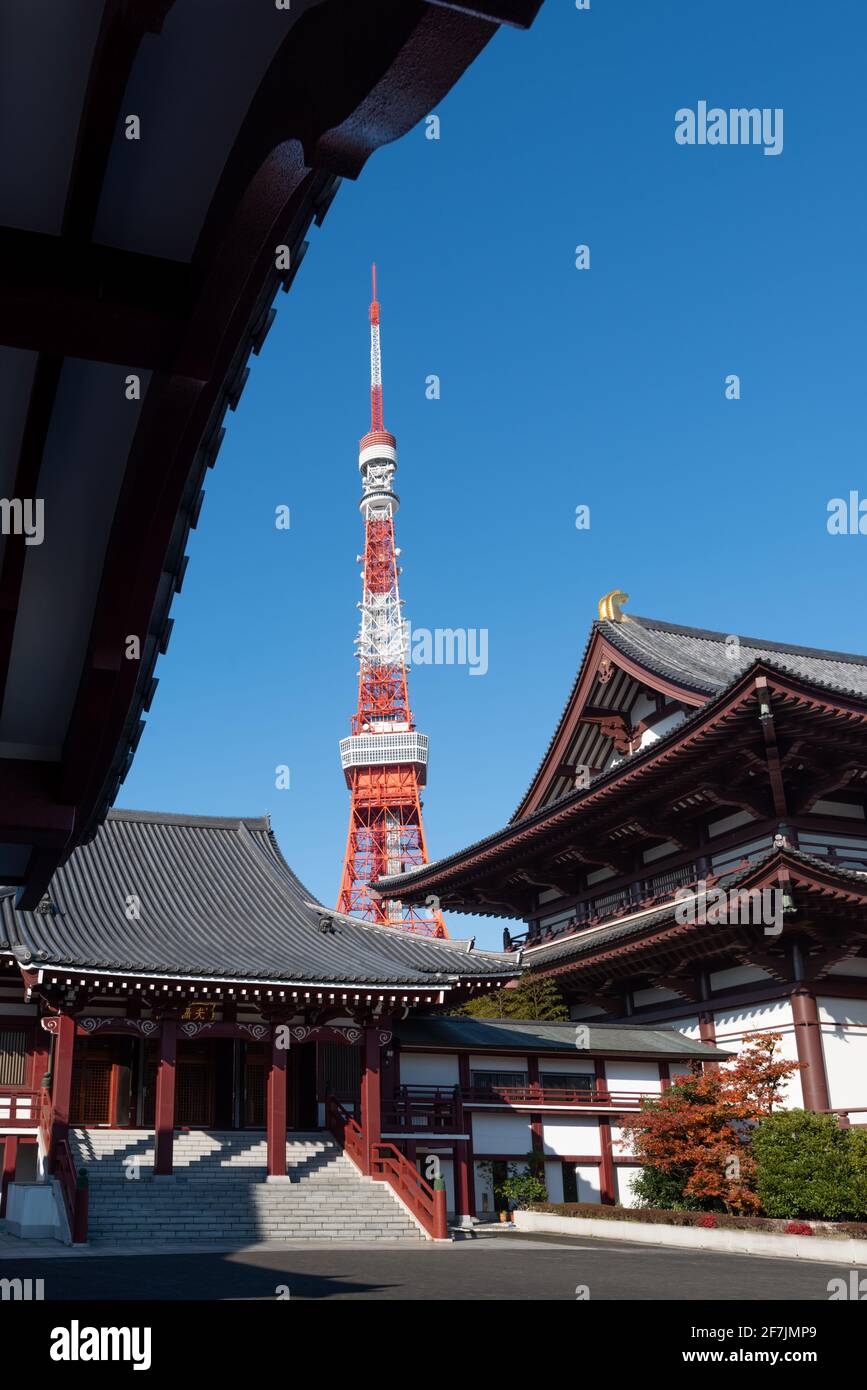 Tokyo, Japan - December 09, 2015: Japanese zojoji temple near the Tokyo tower . Zojo-ji is notable for its relationship with the Tokugawa clan, the ru Stock Photohttps://www.alamy.com/image-license-details/?v=1https://www.alamy.com/tokyo-japan-december-09-2015-japanese-zojoji-temple-near-the-tokyo-tower-zojo-ji-is-notable-for-its-relationship-with-the-tokugawa-clan-the-ru-image417762865.html
Tokyo, Japan - December 09, 2015: Japanese zojoji temple near the Tokyo tower . Zojo-ji is notable for its relationship with the Tokugawa clan, the ru Stock Photohttps://www.alamy.com/image-license-details/?v=1https://www.alamy.com/tokyo-japan-december-09-2015-japanese-zojoji-temple-near-the-tokyo-tower-zojo-ji-is-notable-for-its-relationship-with-the-tokugawa-clan-the-ru-image417762865.htmlRM2F7JMP9–Tokyo, Japan - December 09, 2015: Japanese zojoji temple near the Tokyo tower . Zojo-ji is notable for its relationship with the Tokugawa clan, the ru
 Prince Tokugawa, Photograph shows Tokugawa lemasa (lyemosa) (1884-1963), the head of the Tokugawa clan in Japan., between ca. 1915 and ca. 1920, Glass negatives, 1 negative: glass Stock Photohttps://www.alamy.com/image-license-details/?v=1https://www.alamy.com/prince-tokugawa-photograph-shows-tokugawa-lemasa-lyemosa-1884-1963-the-head-of-the-tokugawa-clan-in-japan-between-ca-1915-and-ca-1920-glass-negatives-1-negative-glass-image599557820.html
Prince Tokugawa, Photograph shows Tokugawa lemasa (lyemosa) (1884-1963), the head of the Tokugawa clan in Japan., between ca. 1915 and ca. 1920, Glass negatives, 1 negative: glass Stock Photohttps://www.alamy.com/image-license-details/?v=1https://www.alamy.com/prince-tokugawa-photograph-shows-tokugawa-lemasa-lyemosa-1884-1963-the-head-of-the-tokugawa-clan-in-japan-between-ca-1915-and-ca-1920-glass-negatives-1-negative-glass-image599557820.htmlRM2WRC638–Prince Tokugawa, Photograph shows Tokugawa lemasa (lyemosa) (1884-1963), the head of the Tokugawa clan in Japan., between ca. 1915 and ca. 1920, Glass negatives, 1 negative: glass
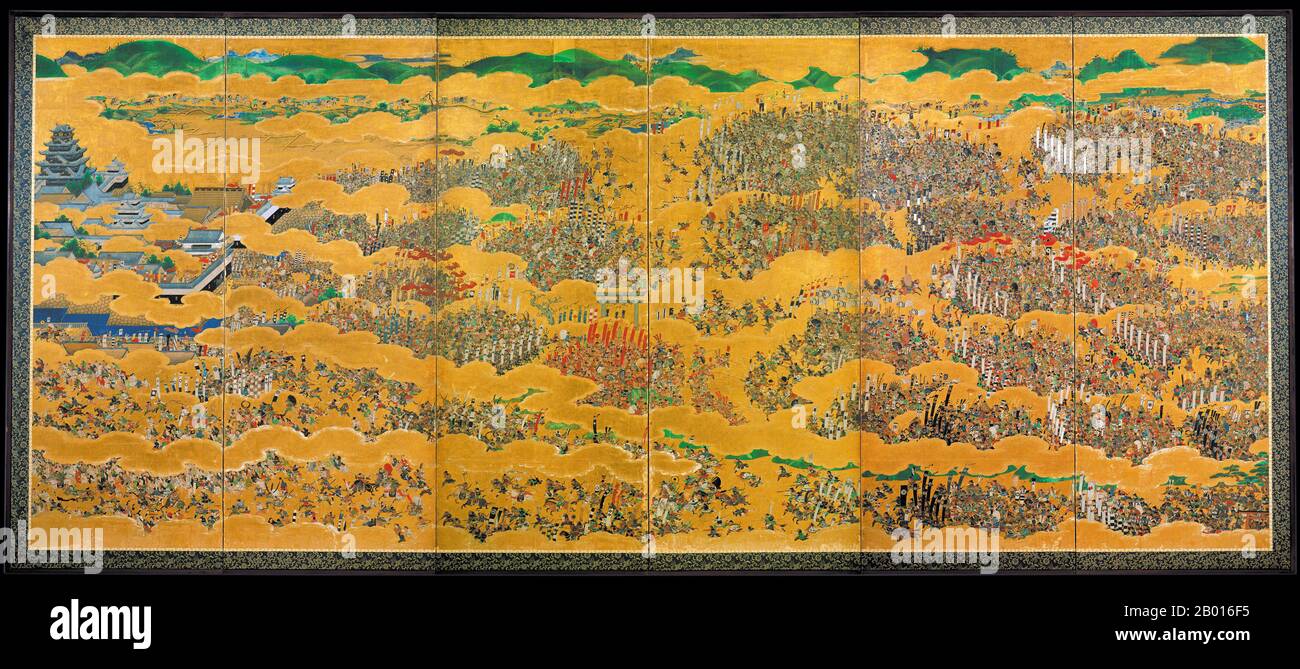 Japan: 'The Siege of Osaka Castle'. Folding screen painting, 17th century. The Siege of Osaka was a series of battles undertaken by the Tokugawa shogunate against the Toyotomi clan, ending in that clan's destruction. Divided into two stages (Winter Campaign and Summer Campaign), and lasting from 1614 to 1615, the siege put an end to the last major armed opposition to the shogunate's establishment. The end of the conflict is sometimes called the Genna Armistice (Genna Enbu), because the era name was changed from Keichō to Genna immediately following the siege. Stock Photohttps://www.alamy.com/image-license-details/?v=1https://www.alamy.com/japan-the-siege-of-osaka-castle-folding-screen-painting-17th-century-the-siege-of-osaka-was-a-series-of-battles-undertaken-by-the-tokugawa-shogunate-against-the-toyotomi-clan-ending-in-that-clans-destruction-divided-into-two-stages-winter-campaign-and-summer-campaign-and-lasting-from-1614-to-1615-the-siege-put-an-end-to-the-last-major-armed-opposition-to-the-shogunates-establishment-the-end-of-the-conflict-is-sometimes-called-the-genna-armistice-genna-enbu-because-the-era-name-was-changed-from-keich-to-genna-immediately-following-the-siege-image344234441.html
Japan: 'The Siege of Osaka Castle'. Folding screen painting, 17th century. The Siege of Osaka was a series of battles undertaken by the Tokugawa shogunate against the Toyotomi clan, ending in that clan's destruction. Divided into two stages (Winter Campaign and Summer Campaign), and lasting from 1614 to 1615, the siege put an end to the last major armed opposition to the shogunate's establishment. The end of the conflict is sometimes called the Genna Armistice (Genna Enbu), because the era name was changed from Keichō to Genna immediately following the siege. Stock Photohttps://www.alamy.com/image-license-details/?v=1https://www.alamy.com/japan-the-siege-of-osaka-castle-folding-screen-painting-17th-century-the-siege-of-osaka-was-a-series-of-battles-undertaken-by-the-tokugawa-shogunate-against-the-toyotomi-clan-ending-in-that-clans-destruction-divided-into-two-stages-winter-campaign-and-summer-campaign-and-lasting-from-1614-to-1615-the-siege-put-an-end-to-the-last-major-armed-opposition-to-the-shogunates-establishment-the-end-of-the-conflict-is-sometimes-called-the-genna-armistice-genna-enbu-because-the-era-name-was-changed-from-keich-to-genna-immediately-following-the-siege-image344234441.htmlRM2B016F5–Japan: 'The Siege of Osaka Castle'. Folding screen painting, 17th century. The Siege of Osaka was a series of battles undertaken by the Tokugawa shogunate against the Toyotomi clan, ending in that clan's destruction. Divided into two stages (Winter Campaign and Summer Campaign), and lasting from 1614 to 1615, the siege put an end to the last major armed opposition to the shogunate's establishment. The end of the conflict is sometimes called the Genna Armistice (Genna Enbu), because the era name was changed from Keichō to Genna immediately following the siege.
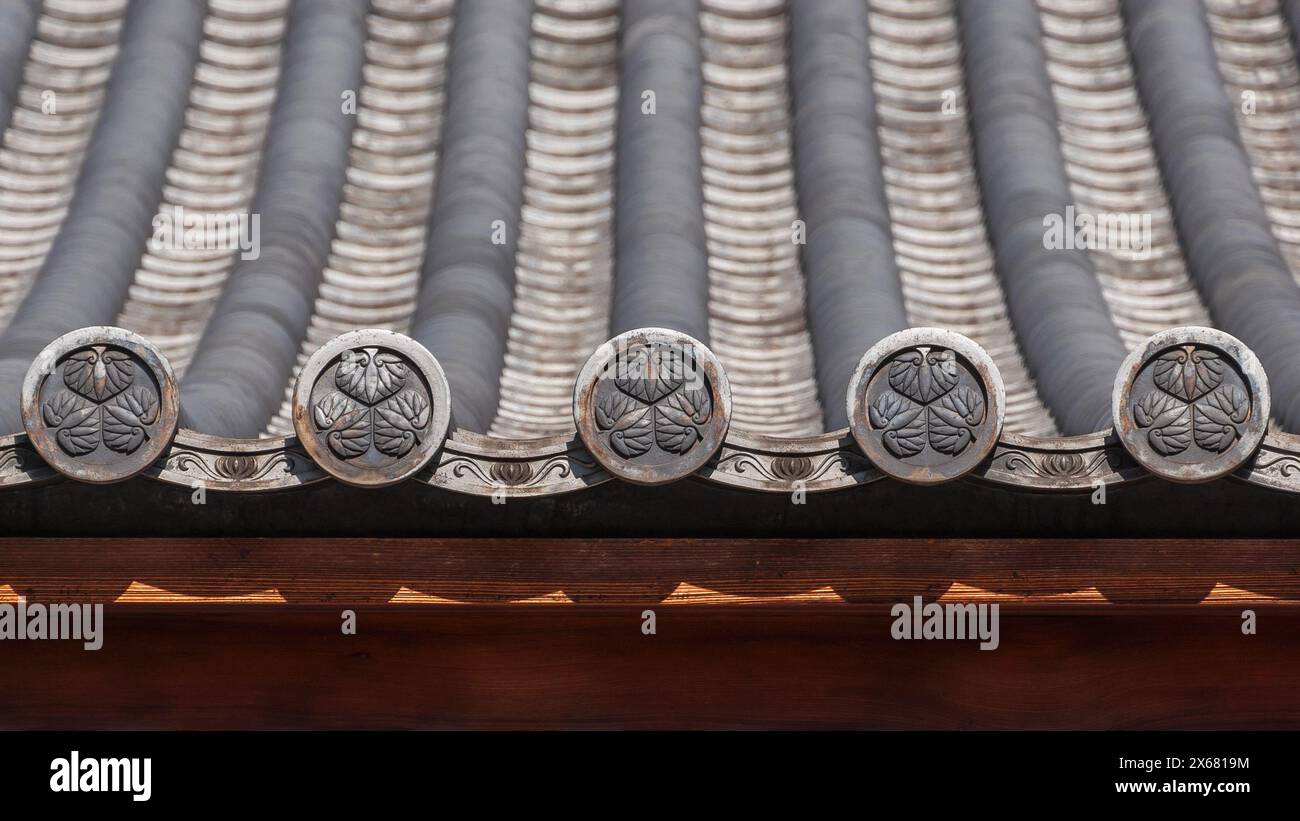 Japanese traditional grey roof tile as background with Tokugawa ancient clan symbol Stock Photohttps://www.alamy.com/image-license-details/?v=1https://www.alamy.com/japanese-traditional-grey-roof-tile-as-background-with-tokugawa-ancient-clan-symbol-image606227488.html
Japanese traditional grey roof tile as background with Tokugawa ancient clan symbol Stock Photohttps://www.alamy.com/image-license-details/?v=1https://www.alamy.com/japanese-traditional-grey-roof-tile-as-background-with-tokugawa-ancient-clan-symbol-image606227488.htmlRF2X6819M–Japanese traditional grey roof tile as background with Tokugawa ancient clan symbol
 Japan: Lady Ohatsu (1570 - 30 September 1633), wife of Kyogoku Takatsugu. Hanging scroll painting, 17th century. Ohatsu or Ohatsu-no-kata was a prominently placed figure in the late Sengoku period. In 1587 she married Kyōgoku Takatsugu, a daimyo in Omi province, holding Ōtsu castle for the Toyotomi clan. After her husband's death in 1609, Ohatsu remained abreast of the political intrigues of her day. Ohatsu's close family ties to both the Toyotomi clan and the Tokugawa clan uniquely positioned her to serve as an intermediary between the rivals until 1615, when the Toyotomi were wiped out. Stock Photohttps://www.alamy.com/image-license-details/?v=1https://www.alamy.com/japan-lady-ohatsu-1570-30-september-1633-wife-of-kyogoku-takatsugu-hanging-scroll-painting-17th-century-ohatsu-or-ohatsu-no-kata-was-a-prominently-placed-figure-in-the-late-sengoku-period-in-1587-she-married-kygoku-takatsugu-a-daimyo-in-omi-province-holding-tsu-castle-for-the-toyotomi-clan-after-her-husbands-death-in-1609-ohatsu-remained-abreast-of-the-political-intrigues-of-her-day-ohatsus-close-family-ties-to-both-the-toyotomi-clan-and-the-tokugawa-clan-uniquely-positioned-her-to-serve-as-an-intermediary-between-the-rivals-until-1615-when-the-toyotomi-were-wiped-out-image344234392.html
Japan: Lady Ohatsu (1570 - 30 September 1633), wife of Kyogoku Takatsugu. Hanging scroll painting, 17th century. Ohatsu or Ohatsu-no-kata was a prominently placed figure in the late Sengoku period. In 1587 she married Kyōgoku Takatsugu, a daimyo in Omi province, holding Ōtsu castle for the Toyotomi clan. After her husband's death in 1609, Ohatsu remained abreast of the political intrigues of her day. Ohatsu's close family ties to both the Toyotomi clan and the Tokugawa clan uniquely positioned her to serve as an intermediary between the rivals until 1615, when the Toyotomi were wiped out. Stock Photohttps://www.alamy.com/image-license-details/?v=1https://www.alamy.com/japan-lady-ohatsu-1570-30-september-1633-wife-of-kyogoku-takatsugu-hanging-scroll-painting-17th-century-ohatsu-or-ohatsu-no-kata-was-a-prominently-placed-figure-in-the-late-sengoku-period-in-1587-she-married-kygoku-takatsugu-a-daimyo-in-omi-province-holding-tsu-castle-for-the-toyotomi-clan-after-her-husbands-death-in-1609-ohatsu-remained-abreast-of-the-political-intrigues-of-her-day-ohatsus-close-family-ties-to-both-the-toyotomi-clan-and-the-tokugawa-clan-uniquely-positioned-her-to-serve-as-an-intermediary-between-the-rivals-until-1615-when-the-toyotomi-were-wiped-out-image344234392.htmlRM2B016DC–Japan: Lady Ohatsu (1570 - 30 September 1633), wife of Kyogoku Takatsugu. Hanging scroll painting, 17th century. Ohatsu or Ohatsu-no-kata was a prominently placed figure in the late Sengoku period. In 1587 she married Kyōgoku Takatsugu, a daimyo in Omi province, holding Ōtsu castle for the Toyotomi clan. After her husband's death in 1609, Ohatsu remained abreast of the political intrigues of her day. Ohatsu's close family ties to both the Toyotomi clan and the Tokugawa clan uniquely positioned her to serve as an intermediary between the rivals until 1615, when the Toyotomi were wiped out.
 Tokyo, Japan - Jizo Statues at Zojoji Temple in Tokyo, Japan. Zojoji Temple is notable for its relationship with the Tokugawa clan. Stock Photohttps://www.alamy.com/image-license-details/?v=1https://www.alamy.com/tokyo-japan-jizo-statues-at-zojoji-temple-in-tokyo-japan-zojoji-temple-is-notable-for-its-relationship-with-the-tokugawa-clan-image369151455.html
Tokyo, Japan - Jizo Statues at Zojoji Temple in Tokyo, Japan. Zojoji Temple is notable for its relationship with the Tokugawa clan. Stock Photohttps://www.alamy.com/image-license-details/?v=1https://www.alamy.com/tokyo-japan-jizo-statues-at-zojoji-temple-in-tokyo-japan-zojoji-temple-is-notable-for-its-relationship-with-the-tokugawa-clan-image369151455.htmlRF2CCG8CF–Tokyo, Japan - Jizo Statues at Zojoji Temple in Tokyo, Japan. Zojoji Temple is notable for its relationship with the Tokugawa clan.
 Fragment of a broadsheet sold in the streets of Yedo in 1615, announcing the fall of Osaka Castle. The siege of Osaka was a series of battles undertaken by the Japanese Tokugawa shogunate against the Toyotomi clan, and ending in that clan's destruction Stock Photohttps://www.alamy.com/image-license-details/?v=1https://www.alamy.com/fragment-of-a-broadsheet-sold-in-the-streets-of-yedo-in-1615-announcing-the-fall-of-osaka-castle-the-siege-of-osaka-was-a-series-of-battles-undertaken-by-the-japanese-tokugawa-shogunate-against-the-toyotomi-clan-and-ending-in-that-clans-destruction-image482075276.html
Fragment of a broadsheet sold in the streets of Yedo in 1615, announcing the fall of Osaka Castle. The siege of Osaka was a series of battles undertaken by the Japanese Tokugawa shogunate against the Toyotomi clan, and ending in that clan's destruction Stock Photohttps://www.alamy.com/image-license-details/?v=1https://www.alamy.com/fragment-of-a-broadsheet-sold-in-the-streets-of-yedo-in-1615-announcing-the-fall-of-osaka-castle-the-siege-of-osaka-was-a-series-of-battles-undertaken-by-the-japanese-tokugawa-shogunate-against-the-toyotomi-clan-and-ending-in-that-clans-destruction-image482075276.htmlRM2K08BX4–Fragment of a broadsheet sold in the streets of Yedo in 1615, announcing the fall of Osaka Castle. The siege of Osaka was a series of battles undertaken by the Japanese Tokugawa shogunate against the Toyotomi clan, and ending in that clan's destruction
 Umoregi-no-ya, where Naosuke Ii (1815-1860), the 13th load of Hikone domain and top official of Tokugawa Shogunate, spent his younger days in Hikone. Stock Photohttps://www.alamy.com/image-license-details/?v=1https://www.alamy.com/umoregi-no-ya-where-naosuke-ii-1815-1860-the-13th-load-of-hikone-domain-and-top-official-of-tokugawa-shogunate-spent-his-younger-days-in-hikone-image634573522.html
Umoregi-no-ya, where Naosuke Ii (1815-1860), the 13th load of Hikone domain and top official of Tokugawa Shogunate, spent his younger days in Hikone. Stock Photohttps://www.alamy.com/image-license-details/?v=1https://www.alamy.com/umoregi-no-ya-where-naosuke-ii-1815-1860-the-13th-load-of-hikone-domain-and-top-official-of-tokugawa-shogunate-spent-his-younger-days-in-hikone-image634573522.htmlRM2YTB902–Umoregi-no-ya, where Naosuke Ii (1815-1860), the 13th load of Hikone domain and top official of Tokugawa Shogunate, spent his younger days in Hikone.
 Koyasan, Koya, Ito District, Wakayama, Japan, 2022/03/05 , Tokugawa Clan Mausoleum. From grandfather to son. Set apart from the other religious sites Stock Photohttps://www.alamy.com/image-license-details/?v=1https://www.alamy.com/koyasan-koya-ito-district-wakayama-japan-20220305-tokugawa-clan-mausoleum-from-grandfather-to-son-set-apart-from-the-other-religious-sites-image470620444.html
Koyasan, Koya, Ito District, Wakayama, Japan, 2022/03/05 , Tokugawa Clan Mausoleum. From grandfather to son. Set apart from the other religious sites Stock Photohttps://www.alamy.com/image-license-details/?v=1https://www.alamy.com/koyasan-koya-ito-district-wakayama-japan-20220305-tokugawa-clan-mausoleum-from-grandfather-to-son-set-apart-from-the-other-religious-sites-image470620444.htmlRF2J9JH50–Koyasan, Koya, Ito District, Wakayama, Japan, 2022/03/05 , Tokugawa Clan Mausoleum. From grandfather to son. Set apart from the other religious sites
![. English: 'Tycoon's Palace, Osaka' [Japan] No. 12 of 51 (PAJ2051 - PAJ2101): inscribed by the artist on the album page, as title, and dated '1/68'. 'Tycoon' (great lord) was originally an alternative Japanese term for describing the shogun to foreigners. In 1615 the Castle of Osaka fell to assault by the founding father of the shogunate, Tokugawa Ieyasu, when the Toyotomi clan who began its construction in 1583 were extinguished as a political power. It was originally a stone structure: the outer walls, moat and a great deal else were substantially completed under Tokugawa rule in the 1620s, Stock Photo . English: 'Tycoon's Palace, Osaka' [Japan] No. 12 of 51 (PAJ2051 - PAJ2101): inscribed by the artist on the album page, as title, and dated '1/68'. 'Tycoon' (great lord) was originally an alternative Japanese term for describing the shogun to foreigners. In 1615 the Castle of Osaka fell to assault by the founding father of the shogunate, Tokugawa Ieyasu, when the Toyotomi clan who began its construction in 1583 were extinguished as a political power. It was originally a stone structure: the outer walls, moat and a great deal else were substantially completed under Tokugawa rule in the 1620s, Stock Photo](https://c8.alamy.com/comp/P036BN/english-tycoons-palace-osaka-japan-no-12-of-51-paj2051-paj2101-inscribed-by-the-artist-on-the-album-page-as-title-and-dated-168-tycoon-great-lord-was-originally-an-alternative-japanese-term-for-describing-the-shogun-to-foreigners-in-1615-the-castle-of-osaka-fell-to-assault-by-the-founding-father-of-the-shogunate-tokugawa-ieyasu-when-the-toyotomi-clan-who-began-its-construction-in-1583-were-extinguished-as-a-political-power-it-was-originally-a-stone-structure-the-outer-walls-moat-and-a-great-deal-else-were-substantially-completed-under-tokugawa-rule-in-the-1620s-P036BN.jpg) . English: 'Tycoon's Palace, Osaka' [Japan] No. 12 of 51 (PAJ2051 - PAJ2101): inscribed by the artist on the album page, as title, and dated '1/68'. 'Tycoon' (great lord) was originally an alternative Japanese term for describing the shogun to foreigners. In 1615 the Castle of Osaka fell to assault by the founding father of the shogunate, Tokugawa Ieyasu, when the Toyotomi clan who began its construction in 1583 were extinguished as a political power. It was originally a stone structure: the outer walls, moat and a great deal else were substantially completed under Tokugawa rule in the 1620s, Stock Photohttps://www.alamy.com/image-license-details/?v=1https://www.alamy.com/english-tycoons-palace-osaka-japan-no-12-of-51-paj2051-paj2101-inscribed-by-the-artist-on-the-album-page-as-title-and-dated-168-tycoon-great-lord-was-originally-an-alternative-japanese-term-for-describing-the-shogun-to-foreigners-in-1615-the-castle-of-osaka-fell-to-assault-by-the-founding-father-of-the-shogunate-tokugawa-ieyasu-when-the-toyotomi-clan-who-began-its-construction-in-1583-were-extinguished-as-a-political-power-it-was-originally-a-stone-structure-the-outer-walls-moat-and-a-great-deal-else-were-substantially-completed-under-tokugawa-rule-in-the-1620s-image206595305.html
. English: 'Tycoon's Palace, Osaka' [Japan] No. 12 of 51 (PAJ2051 - PAJ2101): inscribed by the artist on the album page, as title, and dated '1/68'. 'Tycoon' (great lord) was originally an alternative Japanese term for describing the shogun to foreigners. In 1615 the Castle of Osaka fell to assault by the founding father of the shogunate, Tokugawa Ieyasu, when the Toyotomi clan who began its construction in 1583 were extinguished as a political power. It was originally a stone structure: the outer walls, moat and a great deal else were substantially completed under Tokugawa rule in the 1620s, Stock Photohttps://www.alamy.com/image-license-details/?v=1https://www.alamy.com/english-tycoons-palace-osaka-japan-no-12-of-51-paj2051-paj2101-inscribed-by-the-artist-on-the-album-page-as-title-and-dated-168-tycoon-great-lord-was-originally-an-alternative-japanese-term-for-describing-the-shogun-to-foreigners-in-1615-the-castle-of-osaka-fell-to-assault-by-the-founding-father-of-the-shogunate-tokugawa-ieyasu-when-the-toyotomi-clan-who-began-its-construction-in-1583-were-extinguished-as-a-political-power-it-was-originally-a-stone-structure-the-outer-walls-moat-and-a-great-deal-else-were-substantially-completed-under-tokugawa-rule-in-the-1620s-image206595305.htmlRMP036BN–. English: 'Tycoon's Palace, Osaka' [Japan] No. 12 of 51 (PAJ2051 - PAJ2101): inscribed by the artist on the album page, as title, and dated '1/68'. 'Tycoon' (great lord) was originally an alternative Japanese term for describing the shogun to foreigners. In 1615 the Castle of Osaka fell to assault by the founding father of the shogunate, Tokugawa Ieyasu, when the Toyotomi clan who began its construction in 1583 were extinguished as a political power. It was originally a stone structure: the outer walls, moat and a great deal else were substantially completed under Tokugawa rule in the 1620s,
 The cemetery behind the Great Hall in Zojoji, where Tokugawa shoguns were buried, Tokyo, Minato ward, Japan. Stock Photohttps://www.alamy.com/image-license-details/?v=1https://www.alamy.com/the-cemetery-behind-the-great-hall-in-zojoji-where-tokugawa-shoguns-were-buried-tokyo-minato-ward-japan-image609915118.html
The cemetery behind the Great Hall in Zojoji, where Tokugawa shoguns were buried, Tokyo, Minato ward, Japan. Stock Photohttps://www.alamy.com/image-license-details/?v=1https://www.alamy.com/the-cemetery-behind-the-great-hall-in-zojoji-where-tokugawa-shoguns-were-buried-tokyo-minato-ward-japan-image609915118.htmlRF2XC80XP–The cemetery behind the Great Hall in Zojoji, where Tokugawa shoguns were buried, Tokyo, Minato ward, Japan.
 Inside the Shushoin Temple of the Hokkeshu sect decorated with gilded walls, gold chandeliers, curtains with the Tokugawa clan emblem and phoenix, lot Stock Photohttps://www.alamy.com/image-license-details/?v=1https://www.alamy.com/inside-the-shushoin-temple-of-the-hokkeshu-sect-decorated-with-gilded-walls-gold-chandeliers-curtains-with-the-tokugawa-clan-emblem-and-phoenix-lot-image332751814.html
Inside the Shushoin Temple of the Hokkeshu sect decorated with gilded walls, gold chandeliers, curtains with the Tokugawa clan emblem and phoenix, lot Stock Photohttps://www.alamy.com/image-license-details/?v=1https://www.alamy.com/inside-the-shushoin-temple-of-the-hokkeshu-sect-decorated-with-gilded-walls-gold-chandeliers-curtains-with-the-tokugawa-clan-emblem-and-phoenix-lot-image332751814.htmlRF2A9A49A–Inside the Shushoin Temple of the Hokkeshu sect decorated with gilded walls, gold chandeliers, curtains with the Tokugawa clan emblem and phoenix, lot
 Tokugawa Tsunayoshi Visiting Nikko Shrine, 1875. From Brief Account of the Rulers of the Tokugawa Clan. Stock Photohttps://www.alamy.com/image-license-details/?v=1https://www.alamy.com/tokugawa-tsunayoshi-visiting-nikko-shrine-1875-from-brief-account-of-the-rulers-of-the-tokugawa-clan-image568854380.html
Tokugawa Tsunayoshi Visiting Nikko Shrine, 1875. From Brief Account of the Rulers of the Tokugawa Clan. Stock Photohttps://www.alamy.com/image-license-details/?v=1https://www.alamy.com/tokugawa-tsunayoshi-visiting-nikko-shrine-1875-from-brief-account-of-the-rulers-of-the-tokugawa-clan-image568854380.htmlRM2T1DFFT–Tokugawa Tsunayoshi Visiting Nikko Shrine, 1875. From Brief Account of the Rulers of the Tokugawa Clan.
 Samurai armor with white lacing and helmet decorated with curls, owned by the Owari Tokugawa clan, Edo period, 17th century Stock Photohttps://www.alamy.com/image-license-details/?v=1https://www.alamy.com/samurai-armor-with-white-lacing-and-helmet-decorated-with-curls-owned-by-the-owari-tokugawa-clan-edo-period-17th-century-image327645231.html
Samurai armor with white lacing and helmet decorated with curls, owned by the Owari Tokugawa clan, Edo period, 17th century Stock Photohttps://www.alamy.com/image-license-details/?v=1https://www.alamy.com/samurai-armor-with-white-lacing-and-helmet-decorated-with-curls-owned-by-the-owari-tokugawa-clan-edo-period-17th-century-image327645231.htmlRF2A11ERB–Samurai armor with white lacing and helmet decorated with curls, owned by the Owari Tokugawa clan, Edo period, 17th century
 Japanese Prince Adept At Evading Reporters -- Prince Tokugawa, Japanese delegates to the Aris ***** has created more interest among the conference newspaper ***** than any other Foreign delegate largely because he is so silent. The reporters have tried in vain to get some statement which would be of news value but he is too much of a diplomat to say anything that he does not wise to. In fact he is a master in his line. November 30, 1921. Stock Photohttps://www.alamy.com/image-license-details/?v=1https://www.alamy.com/japanese-prince-adept-at-evading-reporters-prince-tokugawa-japanese-delegates-to-the-aris-has-created-more-interest-among-the-conference-newspaper-than-any-other-foreign-delegate-largely-because-he-is-so-silent-the-reporters-have-tried-in-vain-to-get-some-statement-which-would-be-of-news-value-but-he-is-too-much-of-a-diplomat-to-say-anything-that-he-does-not-wise-to-in-fact-he-is-a-master-in-his-line-november-30-1921-image463566695.html
Japanese Prince Adept At Evading Reporters -- Prince Tokugawa, Japanese delegates to the Aris ***** has created more interest among the conference newspaper ***** than any other Foreign delegate largely because he is so silent. The reporters have tried in vain to get some statement which would be of news value but he is too much of a diplomat to say anything that he does not wise to. In fact he is a master in his line. November 30, 1921. Stock Photohttps://www.alamy.com/image-license-details/?v=1https://www.alamy.com/japanese-prince-adept-at-evading-reporters-prince-tokugawa-japanese-delegates-to-the-aris-has-created-more-interest-among-the-conference-newspaper-than-any-other-foreign-delegate-largely-because-he-is-so-silent-the-reporters-have-tried-in-vain-to-get-some-statement-which-would-be-of-news-value-but-he-is-too-much-of-a-diplomat-to-say-anything-that-he-does-not-wise-to-in-fact-he-is-a-master-in-his-line-november-30-1921-image463566695.htmlRM2HX581B–Japanese Prince Adept At Evading Reporters -- Prince Tokugawa, Japanese delegates to the Aris ***** has created more interest among the conference newspaper ***** than any other Foreign delegate largely because he is so silent. The reporters have tried in vain to get some statement which would be of news value but he is too much of a diplomat to say anything that he does not wise to. In fact he is a master in his line. November 30, 1921.
 Memories . s ago ! Meantime, although there was no great outward show politically,the underground fires of revolution were silently gathering strength.The Tycoon had resigned his office—in fact abolished it—thoughhe still in some inconsistent way claimed to be conducting affairs,and of course remained at the head of the Tokugawa clan. TheDaimios, with Satsuma, Choshiu and Tosa at their head, were saidto be arming, and even to have established a camp at Osaka. TheTosa people asserted that the Tycoon, in his resignation, had onlyfollowed the advice contained in a memorial from their clan, datedi Stock Photohttps://www.alamy.com/image-license-details/?v=1https://www.alamy.com/memories-s-ago-!-meantime-although-there-was-no-great-outward-show-politicallythe-underground-fires-of-revolution-were-silently-gathering-strengththe-tycoon-had-resigned-his-officein-fact-abolished-itthoughhe-still-in-some-inconsistent-way-claimed-to-be-conducting-affairsand-of-course-remained-at-the-head-of-the-tokugawa-clan-thedaimios-with-satsuma-choshiu-and-tosa-at-their-head-were-saidto-be-arming-and-even-to-have-established-a-camp-at-osaka-thetosa-people-asserted-that-the-tycoon-in-his-resignation-had-onlyfollowed-the-advice-contained-in-a-memorial-from-their-clan-datedi-image343198702.html
Memories . s ago ! Meantime, although there was no great outward show politically,the underground fires of revolution were silently gathering strength.The Tycoon had resigned his office—in fact abolished it—thoughhe still in some inconsistent way claimed to be conducting affairs,and of course remained at the head of the Tokugawa clan. TheDaimios, with Satsuma, Choshiu and Tosa at their head, were saidto be arming, and even to have established a camp at Osaka. TheTosa people asserted that the Tycoon, in his resignation, had onlyfollowed the advice contained in a memorial from their clan, datedi Stock Photohttps://www.alamy.com/image-license-details/?v=1https://www.alamy.com/memories-s-ago-!-meantime-although-there-was-no-great-outward-show-politicallythe-underground-fires-of-revolution-were-silently-gathering-strengththe-tycoon-had-resigned-his-officein-fact-abolished-itthoughhe-still-in-some-inconsistent-way-claimed-to-be-conducting-affairsand-of-course-remained-at-the-head-of-the-tokugawa-clan-thedaimios-with-satsuma-choshiu-and-tosa-at-their-head-were-saidto-be-arming-and-even-to-have-established-a-camp-at-osaka-thetosa-people-asserted-that-the-tycoon-in-his-resignation-had-onlyfollowed-the-advice-contained-in-a-memorial-from-their-clan-datedi-image343198702.htmlRM2AXA1CE–Memories . s ago ! Meantime, although there was no great outward show politically,the underground fires of revolution were silently gathering strength.The Tycoon had resigned his office—in fact abolished it—thoughhe still in some inconsistent way claimed to be conducting affairs,and of course remained at the head of the Tokugawa clan. TheDaimios, with Satsuma, Choshiu and Tosa at their head, were saidto be arming, and even to have established a camp at Osaka. TheTosa people asserted that the Tycoon, in his resignation, had onlyfollowed the advice contained in a memorial from their clan, datedi
 Tokugawa Family Mausoleum on Koyasan (Mt. Koya), dedicated to the first Tokugawa shogun Ieyasu, Wakayama prefecture, Japan Stock Photohttps://www.alamy.com/image-license-details/?v=1https://www.alamy.com/tokugawa-family-mausoleum-on-koyasan-mt-koya-dedicated-to-the-first-tokugawa-shogun-ieyasu-wakayama-prefecture-japan-image369202611.html
Tokugawa Family Mausoleum on Koyasan (Mt. Koya), dedicated to the first Tokugawa shogun Ieyasu, Wakayama prefecture, Japan Stock Photohttps://www.alamy.com/image-license-details/?v=1https://www.alamy.com/tokugawa-family-mausoleum-on-koyasan-mt-koya-dedicated-to-the-first-tokugawa-shogun-ieyasu-wakayama-prefecture-japan-image369202611.htmlRF2CCJHKF–Tokugawa Family Mausoleum on Koyasan (Mt. Koya), dedicated to the first Tokugawa shogun Ieyasu, Wakayama prefecture, Japan
 Splendering tradtional artwork with rich details on bronze temple or shrine lanterns captured in a close up image, Tosho-gu Nikko Japan October 2018 Stock Photohttps://www.alamy.com/image-license-details/?v=1https://www.alamy.com/splendering-tradtional-artwork-with-rich-details-on-bronze-temple-or-shrine-lanterns-captured-in-a-close-up-image-tosho-gu-nikko-japan-october-2018-image261457120.html
Splendering tradtional artwork with rich details on bronze temple or shrine lanterns captured in a close up image, Tosho-gu Nikko Japan October 2018 Stock Photohttps://www.alamy.com/image-license-details/?v=1https://www.alamy.com/splendering-tradtional-artwork-with-rich-details-on-bronze-temple-or-shrine-lanterns-captured-in-a-close-up-image-tosho-gu-nikko-japan-october-2018-image261457120.htmlRFW5AB68–Splendering tradtional artwork with rich details on bronze temple or shrine lanterns captured in a close up image, Tosho-gu Nikko Japan October 2018
 Hojo Castle Odawara Kanagawa Japan. Hojo Clan controlled castle to 1590, when Heideyoshi defeated the Hojo. Castle was given to Tokugawa Ieyasu. Cast Stock Photohttps://www.alamy.com/image-license-details/?v=1https://www.alamy.com/hojo-castle-odawara-kanagawa-japan-hojo-clan-controlled-castle-to-1590-when-heideyoshi-defeated-the-hojo-castle-was-given-to-tokugawa-ieyasu-cast-image592074305.html
Hojo Castle Odawara Kanagawa Japan. Hojo Clan controlled castle to 1590, when Heideyoshi defeated the Hojo. Castle was given to Tokugawa Ieyasu. Cast Stock Photohttps://www.alamy.com/image-license-details/?v=1https://www.alamy.com/hojo-castle-odawara-kanagawa-japan-hojo-clan-controlled-castle-to-1590-when-heideyoshi-defeated-the-hojo-castle-was-given-to-tokugawa-ieyasu-cast-image592074305.htmlRF2WB78PW–Hojo Castle Odawara Kanagawa Japan. Hojo Clan controlled castle to 1590, when Heideyoshi defeated the Hojo. Castle was given to Tokugawa Ieyasu. Cast
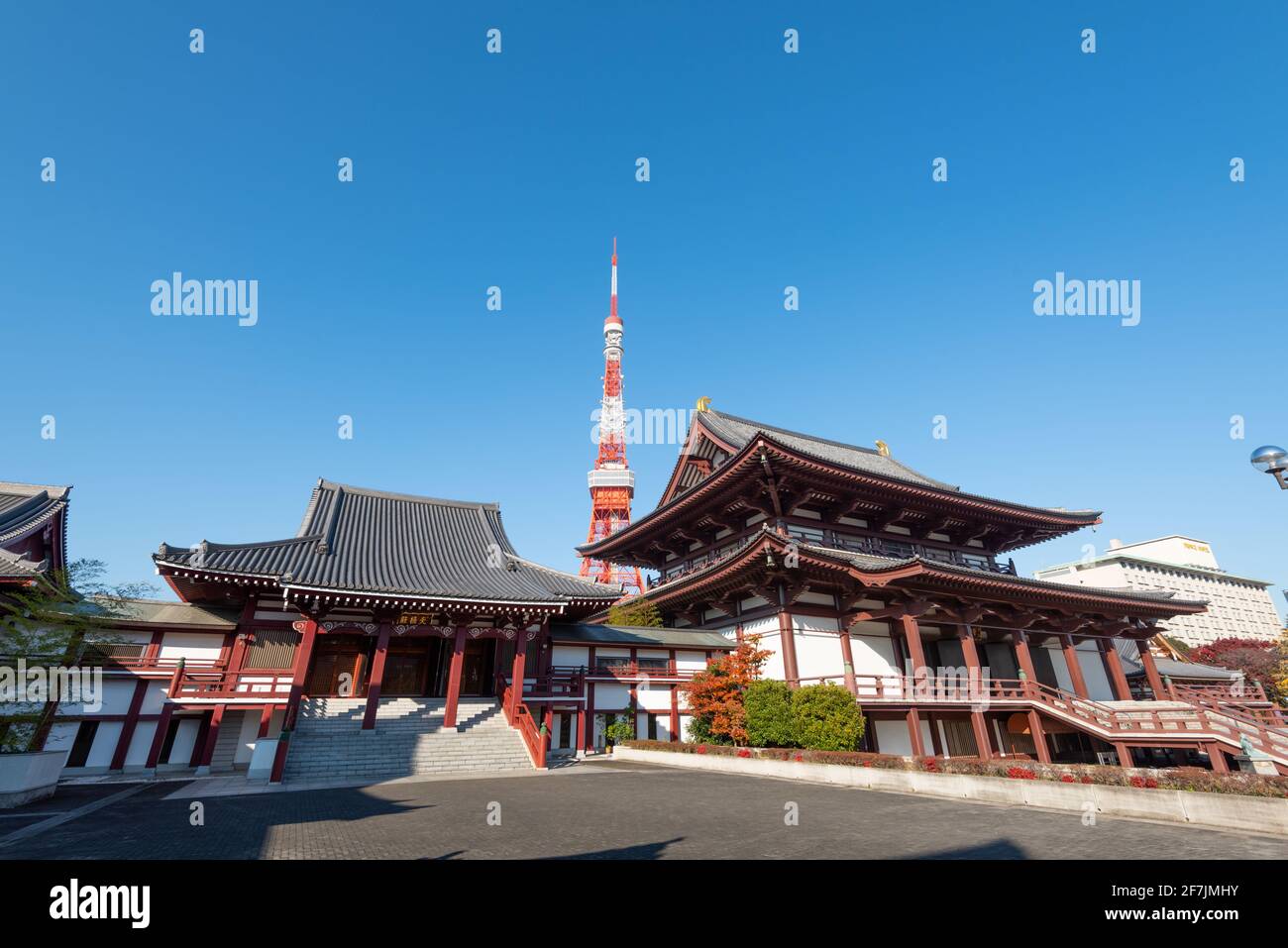 Tokyo, Japan - December 09, 2015: Japanese zojoji temple near the Tokyo tower . Zojo-ji is notable for its relationship with the Tokugawa clan, the ru Stock Photohttps://www.alamy.com/image-license-details/?v=1https://www.alamy.com/tokyo-japan-december-09-2015-japanese-zojoji-temple-near-the-tokyo-tower-zojo-ji-is-notable-for-its-relationship-with-the-tokugawa-clan-the-ru-image417762743.html
Tokyo, Japan - December 09, 2015: Japanese zojoji temple near the Tokyo tower . Zojo-ji is notable for its relationship with the Tokugawa clan, the ru Stock Photohttps://www.alamy.com/image-license-details/?v=1https://www.alamy.com/tokyo-japan-december-09-2015-japanese-zojoji-temple-near-the-tokyo-tower-zojo-ji-is-notable-for-its-relationship-with-the-tokugawa-clan-the-ru-image417762743.htmlRM2F7JMHY–Tokyo, Japan - December 09, 2015: Japanese zojoji temple near the Tokyo tower . Zojo-ji is notable for its relationship with the Tokugawa clan, the ru
 Roof tile of Tokiwagi-mon Gate, Odawara Castle Park, Odawara City, Kanagawa, Japan. Mitubaoi design (family crest of Tokugawa family) is seen. Stock Photohttps://www.alamy.com/image-license-details/?v=1https://www.alamy.com/roof-tile-of-tokiwagi-mon-gate-odawara-castle-park-odawara-city-kanagawa-japan-mitubaoi-design-family-crest-of-tokugawa-family-is-seen-image457102536.html
Roof tile of Tokiwagi-mon Gate, Odawara Castle Park, Odawara City, Kanagawa, Japan. Mitubaoi design (family crest of Tokugawa family) is seen. Stock Photohttps://www.alamy.com/image-license-details/?v=1https://www.alamy.com/roof-tile-of-tokiwagi-mon-gate-odawara-castle-park-odawara-city-kanagawa-japan-mitubaoi-design-family-crest-of-tokugawa-family-is-seen-image457102536.htmlRM2HFJPXG–Roof tile of Tokiwagi-mon Gate, Odawara Castle Park, Odawara City, Kanagawa, Japan. Mitubaoi design (family crest of Tokugawa family) is seen.
 Tokyo, Japan - December 09, 2015: Japanese zojoji temple near the Tokyo tower . Zojo-ji is notable for its relationship with the Tokugawa clan, the ru Stock Photohttps://www.alamy.com/image-license-details/?v=1https://www.alamy.com/tokyo-japan-december-09-2015-japanese-zojoji-temple-near-the-tokyo-tower-zojo-ji-is-notable-for-its-relationship-with-the-tokugawa-clan-the-ru-image417763775.html
Tokyo, Japan - December 09, 2015: Japanese zojoji temple near the Tokyo tower . Zojo-ji is notable for its relationship with the Tokugawa clan, the ru Stock Photohttps://www.alamy.com/image-license-details/?v=1https://www.alamy.com/tokyo-japan-december-09-2015-japanese-zojoji-temple-near-the-tokyo-tower-zojo-ji-is-notable-for-its-relationship-with-the-tokugawa-clan-the-ru-image417763775.htmlRM2F7JNXR–Tokyo, Japan - December 09, 2015: Japanese zojoji temple near the Tokyo tower . Zojo-ji is notable for its relationship with the Tokugawa clan, the ru
 haiden worship hall Stock Photohttps://www.alamy.com/image-license-details/?v=1https://www.alamy.com/haiden-worship-hall-image479769430.html
haiden worship hall Stock Photohttps://www.alamy.com/image-license-details/?v=1https://www.alamy.com/haiden-worship-hall-image479769430.htmlRM2JTFAPE–haiden worship hall
 Japan: Lady Ohatsu (1570 - 30 September 1633), wife of Kyogoku Takatsugu. Hanging scroll painting, 17th century. Ohatsu or Ohatsu-no-kata was a prominently placed figure in the late Sengoku period. In 1587 she married Kyōgoku Takatsugu, a daimyo in Omi province, holding Ōtsu castle for the Toyotomi clan. After her husband's death in 1609, Ohatsu remained abreast of the political intrigues of her day. Ohatsu's close family ties to both the Toyotomi clan and the Tokugawa clan uniquely positioned her to serve as an intermediary between the rivals until 1615, when the Toyotomi were wiped out. Stock Photohttps://www.alamy.com/image-license-details/?v=1https://www.alamy.com/japan-lady-ohatsu-1570-30-september-1633-wife-of-kyogoku-takatsugu-hanging-scroll-painting-17th-century-ohatsu-or-ohatsu-no-kata-was-a-prominently-placed-figure-in-the-late-sengoku-period-in-1587-she-married-kygoku-takatsugu-a-daimyo-in-omi-province-holding-tsu-castle-for-the-toyotomi-clan-after-her-husbands-death-in-1609-ohatsu-remained-abreast-of-the-political-intrigues-of-her-day-ohatsus-close-family-ties-to-both-the-toyotomi-clan-and-the-tokugawa-clan-uniquely-positioned-her-to-serve-as-an-intermediary-between-the-rivals-until-1615-when-the-toyotomi-were-wiped-out-image344234393.html
Japan: Lady Ohatsu (1570 - 30 September 1633), wife of Kyogoku Takatsugu. Hanging scroll painting, 17th century. Ohatsu or Ohatsu-no-kata was a prominently placed figure in the late Sengoku period. In 1587 she married Kyōgoku Takatsugu, a daimyo in Omi province, holding Ōtsu castle for the Toyotomi clan. After her husband's death in 1609, Ohatsu remained abreast of the political intrigues of her day. Ohatsu's close family ties to both the Toyotomi clan and the Tokugawa clan uniquely positioned her to serve as an intermediary between the rivals until 1615, when the Toyotomi were wiped out. Stock Photohttps://www.alamy.com/image-license-details/?v=1https://www.alamy.com/japan-lady-ohatsu-1570-30-september-1633-wife-of-kyogoku-takatsugu-hanging-scroll-painting-17th-century-ohatsu-or-ohatsu-no-kata-was-a-prominently-placed-figure-in-the-late-sengoku-period-in-1587-she-married-kygoku-takatsugu-a-daimyo-in-omi-province-holding-tsu-castle-for-the-toyotomi-clan-after-her-husbands-death-in-1609-ohatsu-remained-abreast-of-the-political-intrigues-of-her-day-ohatsus-close-family-ties-to-both-the-toyotomi-clan-and-the-tokugawa-clan-uniquely-positioned-her-to-serve-as-an-intermediary-between-the-rivals-until-1615-when-the-toyotomi-were-wiped-out-image344234393.htmlRM2B016DD–Japan: Lady Ohatsu (1570 - 30 September 1633), wife of Kyogoku Takatsugu. Hanging scroll painting, 17th century. Ohatsu or Ohatsu-no-kata was a prominently placed figure in the late Sengoku period. In 1587 she married Kyōgoku Takatsugu, a daimyo in Omi province, holding Ōtsu castle for the Toyotomi clan. After her husband's death in 1609, Ohatsu remained abreast of the political intrigues of her day. Ohatsu's close family ties to both the Toyotomi clan and the Tokugawa clan uniquely positioned her to serve as an intermediary between the rivals until 1615, when the Toyotomi were wiped out.
 Tokyo, Japan - Jizo Statues at Zojoji Temple in Tokyo, Japan. Zojoji Temple is notable for its relationship with the Tokugawa clan. Stock Photohttps://www.alamy.com/image-license-details/?v=1https://www.alamy.com/tokyo-japan-jizo-statues-at-zojoji-temple-in-tokyo-japan-zojoji-temple-is-notable-for-its-relationship-with-the-tokugawa-clan-image369151421.html
Tokyo, Japan - Jizo Statues at Zojoji Temple in Tokyo, Japan. Zojoji Temple is notable for its relationship with the Tokugawa clan. Stock Photohttps://www.alamy.com/image-license-details/?v=1https://www.alamy.com/tokyo-japan-jizo-statues-at-zojoji-temple-in-tokyo-japan-zojoji-temple-is-notable-for-its-relationship-with-the-tokugawa-clan-image369151421.htmlRF2CCG8B9–Tokyo, Japan - Jizo Statues at Zojoji Temple in Tokyo, Japan. Zojoji Temple is notable for its relationship with the Tokugawa clan.
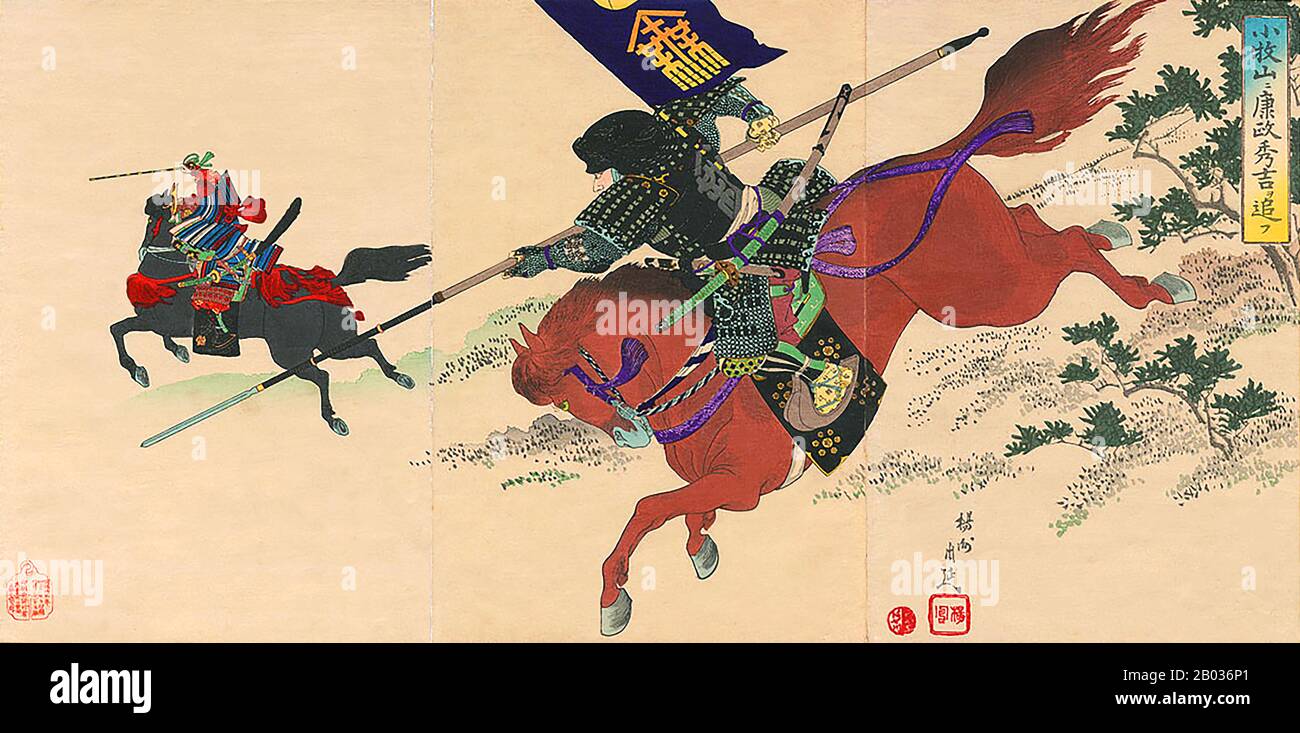 Sakakibara Yasumasa (1548-1606) was a daimyo of the late Sengoku and early Edo Period serving under the Tokugawa clan. Yasumasa was considered one of the Tokugawa clan's greatest military commanders, and was labeled as one of its 'Four Guardian Kings' (Tokugawa-shitenno), bearing the court title of 'Shikibu-Sho'. Toyotomi Hideyoshi (1536/1538-1598) was a preeminent daimyo of the same era, and regarded as Japan's second 'great unifier'. He brought about the end of the Warring States Period, and ruled during a preiod known as the Momoyama Period, named after Hideyoshi's castle. Japan went thro Stock Photohttps://www.alamy.com/image-license-details/?v=1https://www.alamy.com/sakakibara-yasumasa-1548-1606-was-a-daimyo-of-the-late-sengoku-and-early-edo-period-serving-under-the-tokugawa-clan-yasumasa-was-considered-one-of-the-tokugawa-clans-greatest-military-commanders-and-was-labeled-as-one-of-its-four-guardian-kings-tokugawa-shitenno-bearing-the-court-title-of-shikibu-sho-toyotomi-hideyoshi-15361538-1598-was-a-preeminent-daimyo-of-the-same-era-and-regarded-as-japans-second-great-unifier-he-brought-about-the-end-of-the-warring-states-period-and-ruled-during-a-preiod-known-as-the-momoyama-period-named-after-hideyoshis-castle-japan-went-thro-image344278537.html
Sakakibara Yasumasa (1548-1606) was a daimyo of the late Sengoku and early Edo Period serving under the Tokugawa clan. Yasumasa was considered one of the Tokugawa clan's greatest military commanders, and was labeled as one of its 'Four Guardian Kings' (Tokugawa-shitenno), bearing the court title of 'Shikibu-Sho'. Toyotomi Hideyoshi (1536/1538-1598) was a preeminent daimyo of the same era, and regarded as Japan's second 'great unifier'. He brought about the end of the Warring States Period, and ruled during a preiod known as the Momoyama Period, named after Hideyoshi's castle. Japan went thro Stock Photohttps://www.alamy.com/image-license-details/?v=1https://www.alamy.com/sakakibara-yasumasa-1548-1606-was-a-daimyo-of-the-late-sengoku-and-early-edo-period-serving-under-the-tokugawa-clan-yasumasa-was-considered-one-of-the-tokugawa-clans-greatest-military-commanders-and-was-labeled-as-one-of-its-four-guardian-kings-tokugawa-shitenno-bearing-the-court-title-of-shikibu-sho-toyotomi-hideyoshi-15361538-1598-was-a-preeminent-daimyo-of-the-same-era-and-regarded-as-japans-second-great-unifier-he-brought-about-the-end-of-the-warring-states-period-and-ruled-during-a-preiod-known-as-the-momoyama-period-named-after-hideyoshis-castle-japan-went-thro-image344278537.htmlRM2B036P1–Sakakibara Yasumasa (1548-1606) was a daimyo of the late Sengoku and early Edo Period serving under the Tokugawa clan. Yasumasa was considered one of the Tokugawa clan's greatest military commanders, and was labeled as one of its 'Four Guardian Kings' (Tokugawa-shitenno), bearing the court title of 'Shikibu-Sho'. Toyotomi Hideyoshi (1536/1538-1598) was a preeminent daimyo of the same era, and regarded as Japan's second 'great unifier'. He brought about the end of the Warring States Period, and ruled during a preiod known as the Momoyama Period, named after Hideyoshi's castle. Japan went thro
 The Drum Tower at Nishi Honganji Temple in Kyoto is where the Shinsengumi clan stayed during the final days of the Tokugawa Shogunate, Japan. Stock Photohttps://www.alamy.com/image-license-details/?v=1https://www.alamy.com/the-drum-tower-at-nishi-honganji-temple-in-kyoto-is-where-the-shinsengumi-clan-stayed-during-the-final-days-of-the-tokugawa-shogunate-japan-image632831705.html
The Drum Tower at Nishi Honganji Temple in Kyoto is where the Shinsengumi clan stayed during the final days of the Tokugawa Shogunate, Japan. Stock Photohttps://www.alamy.com/image-license-details/?v=1https://www.alamy.com/the-drum-tower-at-nishi-honganji-temple-in-kyoto-is-where-the-shinsengumi-clan-stayed-during-the-final-days-of-the-tokugawa-shogunate-japan-image632831705.htmlRM2YNFY89–The Drum Tower at Nishi Honganji Temple in Kyoto is where the Shinsengumi clan stayed during the final days of the Tokugawa Shogunate, Japan.
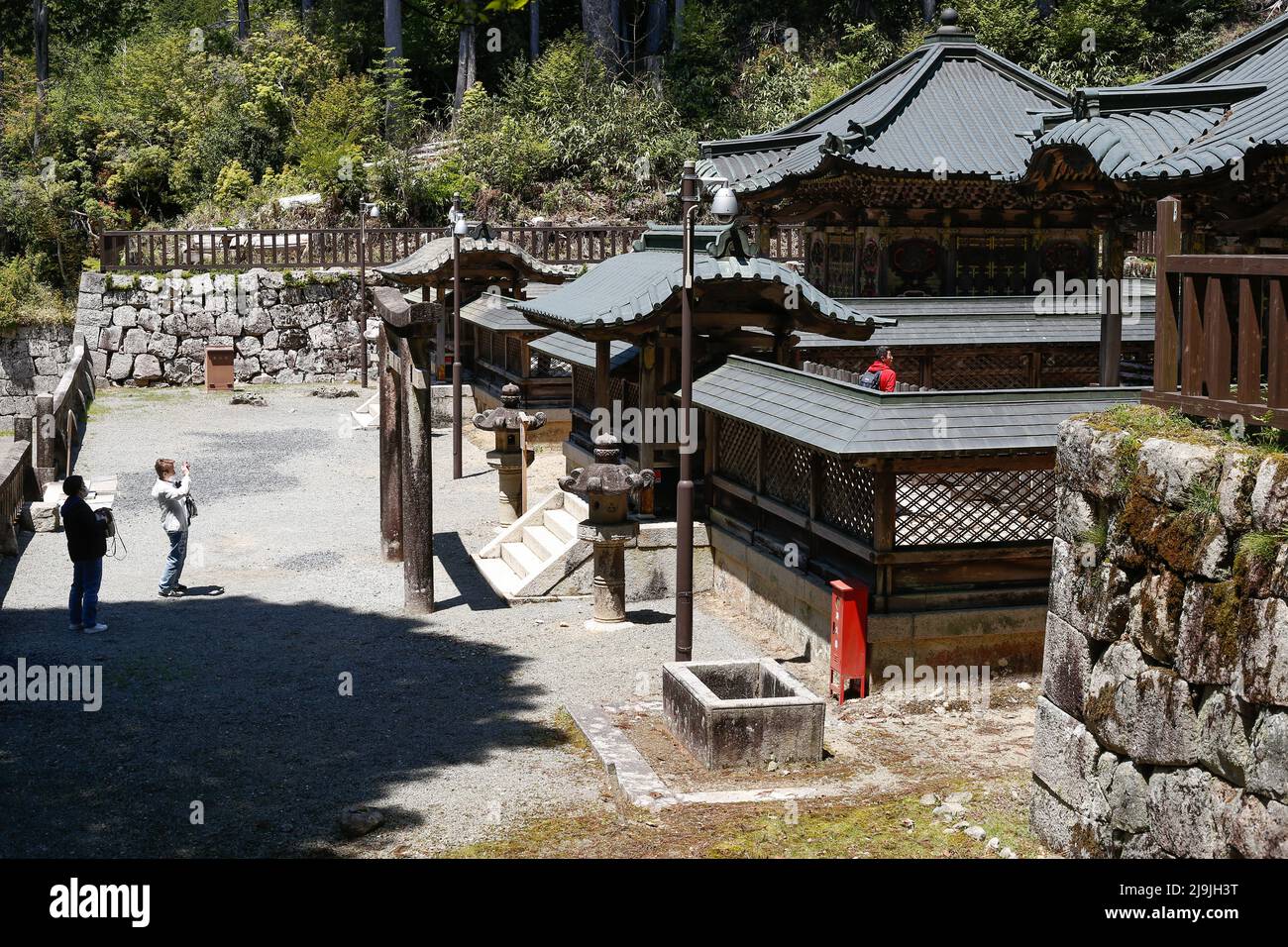 Koyasan, Koya, Ito District, Wakayama, Japan, 2022/03/05 , Tokugawa Clan Mausoleum. From grandfather to son. Set apart from the other religious sites Stock Photohttps://www.alamy.com/image-license-details/?v=1https://www.alamy.com/koyasan-koya-ito-district-wakayama-japan-20220305-tokugawa-clan-mausoleum-from-grandfather-to-son-set-apart-from-the-other-religious-sites-image470620412.html
Koyasan, Koya, Ito District, Wakayama, Japan, 2022/03/05 , Tokugawa Clan Mausoleum. From grandfather to son. Set apart from the other religious sites Stock Photohttps://www.alamy.com/image-license-details/?v=1https://www.alamy.com/koyasan-koya-ito-district-wakayama-japan-20220305-tokugawa-clan-mausoleum-from-grandfather-to-son-set-apart-from-the-other-religious-sites-image470620412.htmlRF2J9JH3T–Koyasan, Koya, Ito District, Wakayama, Japan, 2022/03/05 , Tokugawa Clan Mausoleum. From grandfather to son. Set apart from the other religious sites
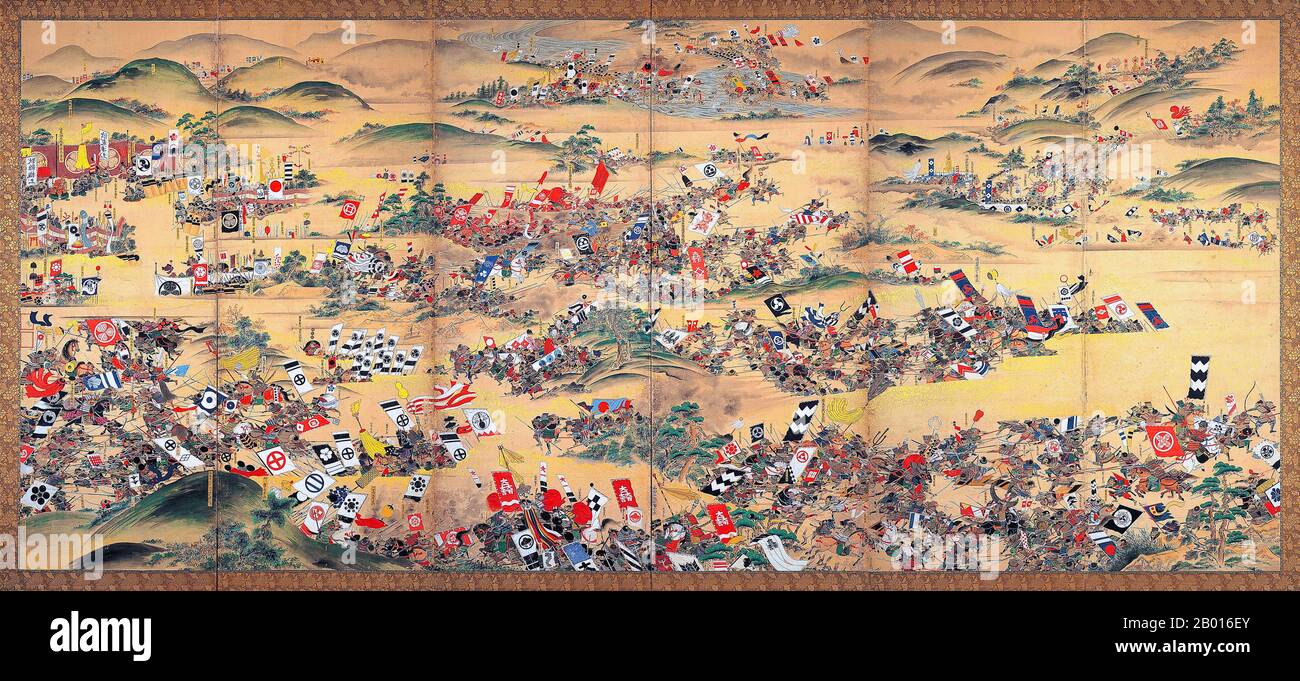 Japan: 'Sekigahara Kassen Byobu'. Folding screen painting, 19th century. The Battle of Sekigahara, popularly known as Tenka Wakeme no Tatakai or 'the Battle for the Sundered Realm', was a decisive battle on October 21, 1600, which cleared the path to the Shogunate for Tokugawa Ieyasu. Though it would take three more years for Ieyasu to consolidate his position of power over the Toyotomi clan and the daimyo, Sekigahara is widely considered to be the unofficial beginning of the Tokugawa bakufu, the last shogunate to control Japan. Stock Photohttps://www.alamy.com/image-license-details/?v=1https://www.alamy.com/japan-sekigahara-kassen-byobu-folding-screen-painting-19th-century-the-battle-of-sekigahara-popularly-known-as-tenka-wakeme-no-tatakai-or-the-battle-for-the-sundered-realm-was-a-decisive-battle-on-october-21-1600-which-cleared-the-path-to-the-shogunate-for-tokugawa-ieyasu-though-it-would-take-three-more-years-for-ieyasu-to-consolidate-his-position-of-power-over-the-toyotomi-clan-and-the-daimyo-sekigahara-is-widely-considered-to-be-the-unofficial-beginning-of-the-tokugawa-bakufu-the-last-shogunate-to-control-japan-image344234435.html
Japan: 'Sekigahara Kassen Byobu'. Folding screen painting, 19th century. The Battle of Sekigahara, popularly known as Tenka Wakeme no Tatakai or 'the Battle for the Sundered Realm', was a decisive battle on October 21, 1600, which cleared the path to the Shogunate for Tokugawa Ieyasu. Though it would take three more years for Ieyasu to consolidate his position of power over the Toyotomi clan and the daimyo, Sekigahara is widely considered to be the unofficial beginning of the Tokugawa bakufu, the last shogunate to control Japan. Stock Photohttps://www.alamy.com/image-license-details/?v=1https://www.alamy.com/japan-sekigahara-kassen-byobu-folding-screen-painting-19th-century-the-battle-of-sekigahara-popularly-known-as-tenka-wakeme-no-tatakai-or-the-battle-for-the-sundered-realm-was-a-decisive-battle-on-october-21-1600-which-cleared-the-path-to-the-shogunate-for-tokugawa-ieyasu-though-it-would-take-three-more-years-for-ieyasu-to-consolidate-his-position-of-power-over-the-toyotomi-clan-and-the-daimyo-sekigahara-is-widely-considered-to-be-the-unofficial-beginning-of-the-tokugawa-bakufu-the-last-shogunate-to-control-japan-image344234435.htmlRM2B016EY–Japan: 'Sekigahara Kassen Byobu'. Folding screen painting, 19th century. The Battle of Sekigahara, popularly known as Tenka Wakeme no Tatakai or 'the Battle for the Sundered Realm', was a decisive battle on October 21, 1600, which cleared the path to the Shogunate for Tokugawa Ieyasu. Though it would take three more years for Ieyasu to consolidate his position of power over the Toyotomi clan and the daimyo, Sekigahara is widely considered to be the unofficial beginning of the Tokugawa bakufu, the last shogunate to control Japan.
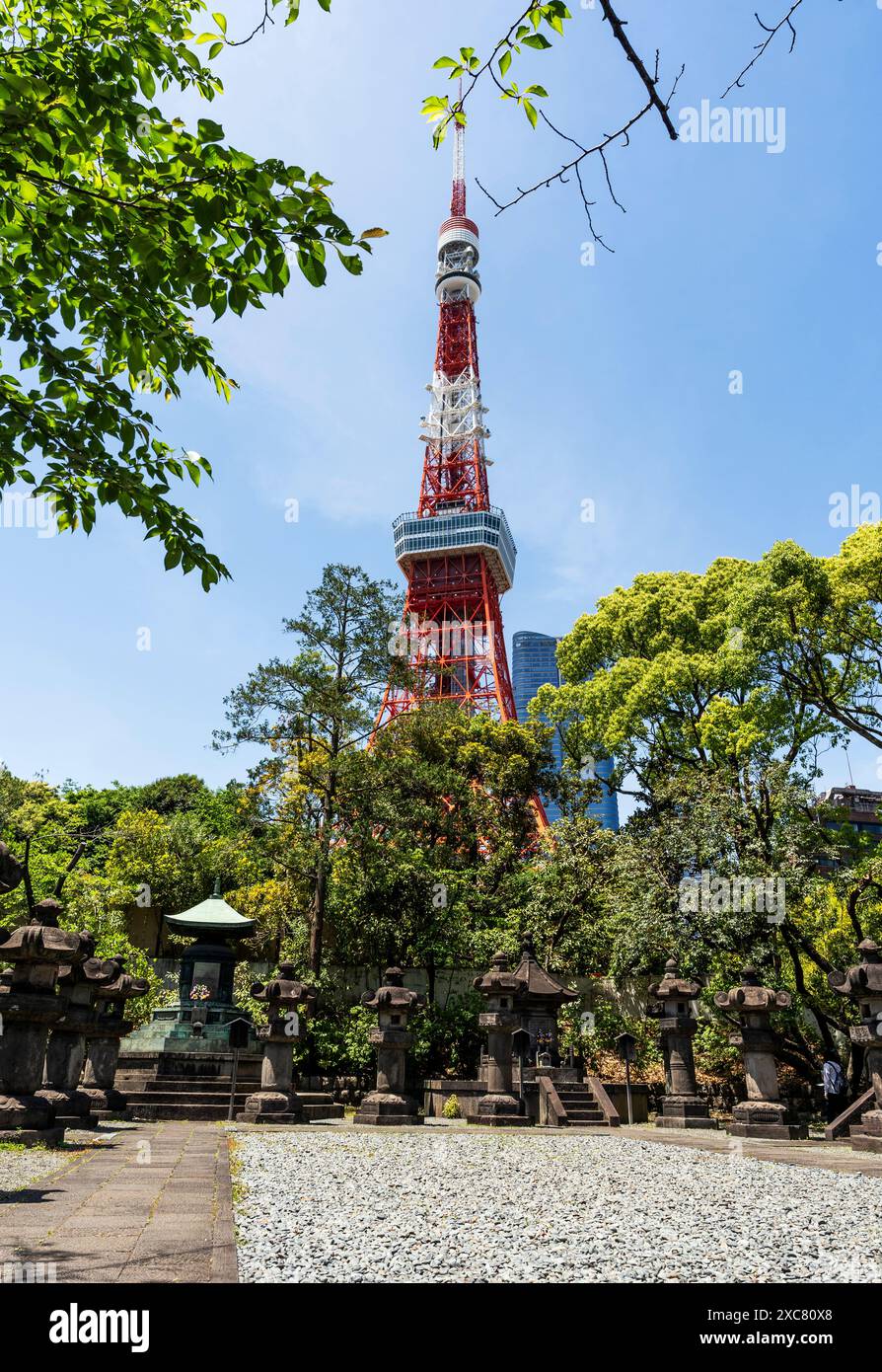 The cemetery behind the Great Hall in Zojoji, where Tokugawa shoguns were buried. Tokyo Tower in the background, Tokyo, Japan. Stock Photohttps://www.alamy.com/image-license-details/?v=1https://www.alamy.com/the-cemetery-behind-the-great-hall-in-zojoji-where-tokugawa-shoguns-were-buried-tokyo-tower-in-the-background-tokyo-japan-image609915104.html
The cemetery behind the Great Hall in Zojoji, where Tokugawa shoguns were buried. Tokyo Tower in the background, Tokyo, Japan. Stock Photohttps://www.alamy.com/image-license-details/?v=1https://www.alamy.com/the-cemetery-behind-the-great-hall-in-zojoji-where-tokugawa-shoguns-were-buried-tokyo-tower-in-the-background-tokyo-japan-image609915104.htmlRF2XC80X8–The cemetery behind the Great Hall in Zojoji, where Tokugawa shoguns were buried. Tokyo Tower in the background, Tokyo, Japan.
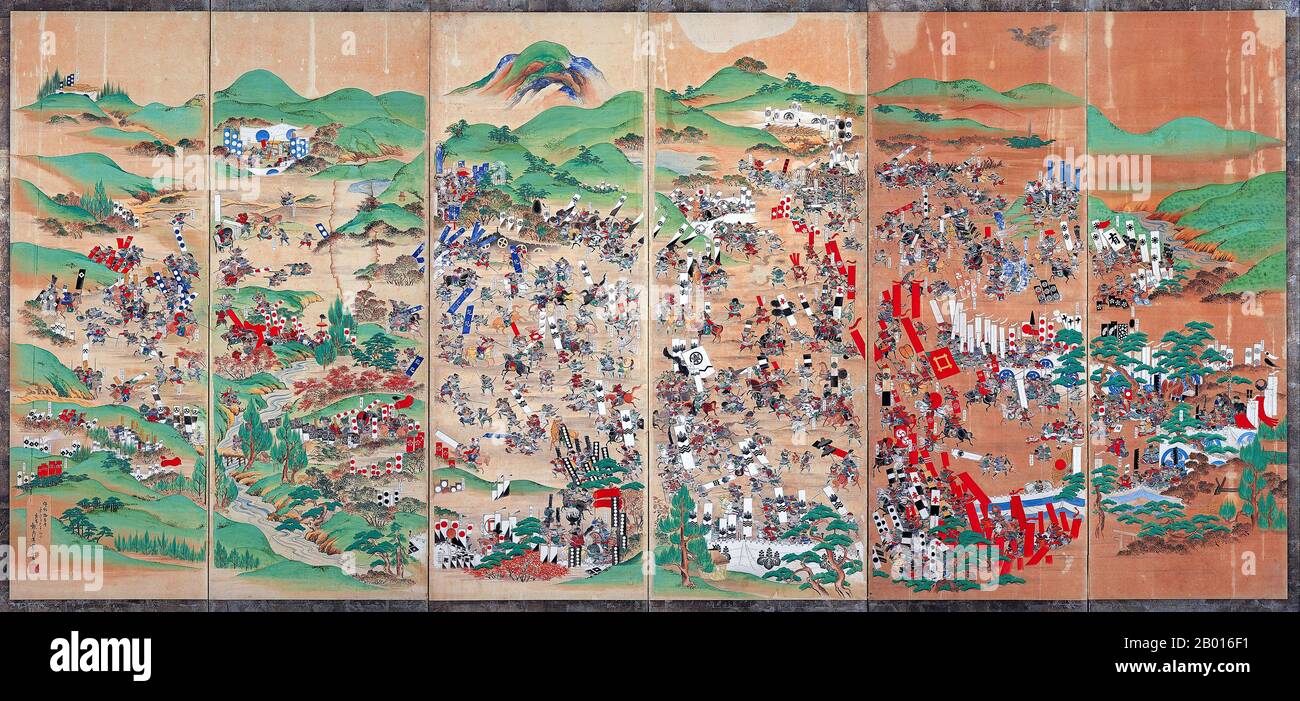 Japan: 'Sekigahara Kassen Byobu'. Replica of a folding screen painting by Sadanobu Kano (22 May 1597 - 12 November 1623), 1854. The Battle of Sekigahara, popularly known as Tenka Wakeme no Tatakai or 'the Battle for the Sundered Realm', was a decisive battle on October 21, 1600, which cleared the path to the Shogunate for Tokugawa Ieyasu. Though it would take three more years for Ieyasu to consolidate his position of power over the Toyotomi clan and the daimyo, Sekigahara is widely considered to be the unofficial beginning of the Tokugawa bakufu, the last shogunate to control Japan. Stock Photohttps://www.alamy.com/image-license-details/?v=1https://www.alamy.com/japan-sekigahara-kassen-byobu-replica-of-a-folding-screen-painting-by-sadanobu-kano-22-may-1597-12-november-1623-1854-the-battle-of-sekigahara-popularly-known-as-tenka-wakeme-no-tatakai-or-the-battle-for-the-sundered-realm-was-a-decisive-battle-on-october-21-1600-which-cleared-the-path-to-the-shogunate-for-tokugawa-ieyasu-though-it-would-take-three-more-years-for-ieyasu-to-consolidate-his-position-of-power-over-the-toyotomi-clan-and-the-daimyo-sekigahara-is-widely-considered-to-be-the-unofficial-beginning-of-the-tokugawa-bakufu-the-last-shogunate-to-control-japan-image344234437.html
Japan: 'Sekigahara Kassen Byobu'. Replica of a folding screen painting by Sadanobu Kano (22 May 1597 - 12 November 1623), 1854. The Battle of Sekigahara, popularly known as Tenka Wakeme no Tatakai or 'the Battle for the Sundered Realm', was a decisive battle on October 21, 1600, which cleared the path to the Shogunate for Tokugawa Ieyasu. Though it would take three more years for Ieyasu to consolidate his position of power over the Toyotomi clan and the daimyo, Sekigahara is widely considered to be the unofficial beginning of the Tokugawa bakufu, the last shogunate to control Japan. Stock Photohttps://www.alamy.com/image-license-details/?v=1https://www.alamy.com/japan-sekigahara-kassen-byobu-replica-of-a-folding-screen-painting-by-sadanobu-kano-22-may-1597-12-november-1623-1854-the-battle-of-sekigahara-popularly-known-as-tenka-wakeme-no-tatakai-or-the-battle-for-the-sundered-realm-was-a-decisive-battle-on-october-21-1600-which-cleared-the-path-to-the-shogunate-for-tokugawa-ieyasu-though-it-would-take-three-more-years-for-ieyasu-to-consolidate-his-position-of-power-over-the-toyotomi-clan-and-the-daimyo-sekigahara-is-widely-considered-to-be-the-unofficial-beginning-of-the-tokugawa-bakufu-the-last-shogunate-to-control-japan-image344234437.htmlRM2B016F1–Japan: 'Sekigahara Kassen Byobu'. Replica of a folding screen painting by Sadanobu Kano (22 May 1597 - 12 November 1623), 1854. The Battle of Sekigahara, popularly known as Tenka Wakeme no Tatakai or 'the Battle for the Sundered Realm', was a decisive battle on October 21, 1600, which cleared the path to the Shogunate for Tokugawa Ieyasu. Though it would take three more years for Ieyasu to consolidate his position of power over the Toyotomi clan and the daimyo, Sekigahara is widely considered to be the unofficial beginning of the Tokugawa bakufu, the last shogunate to control Japan.
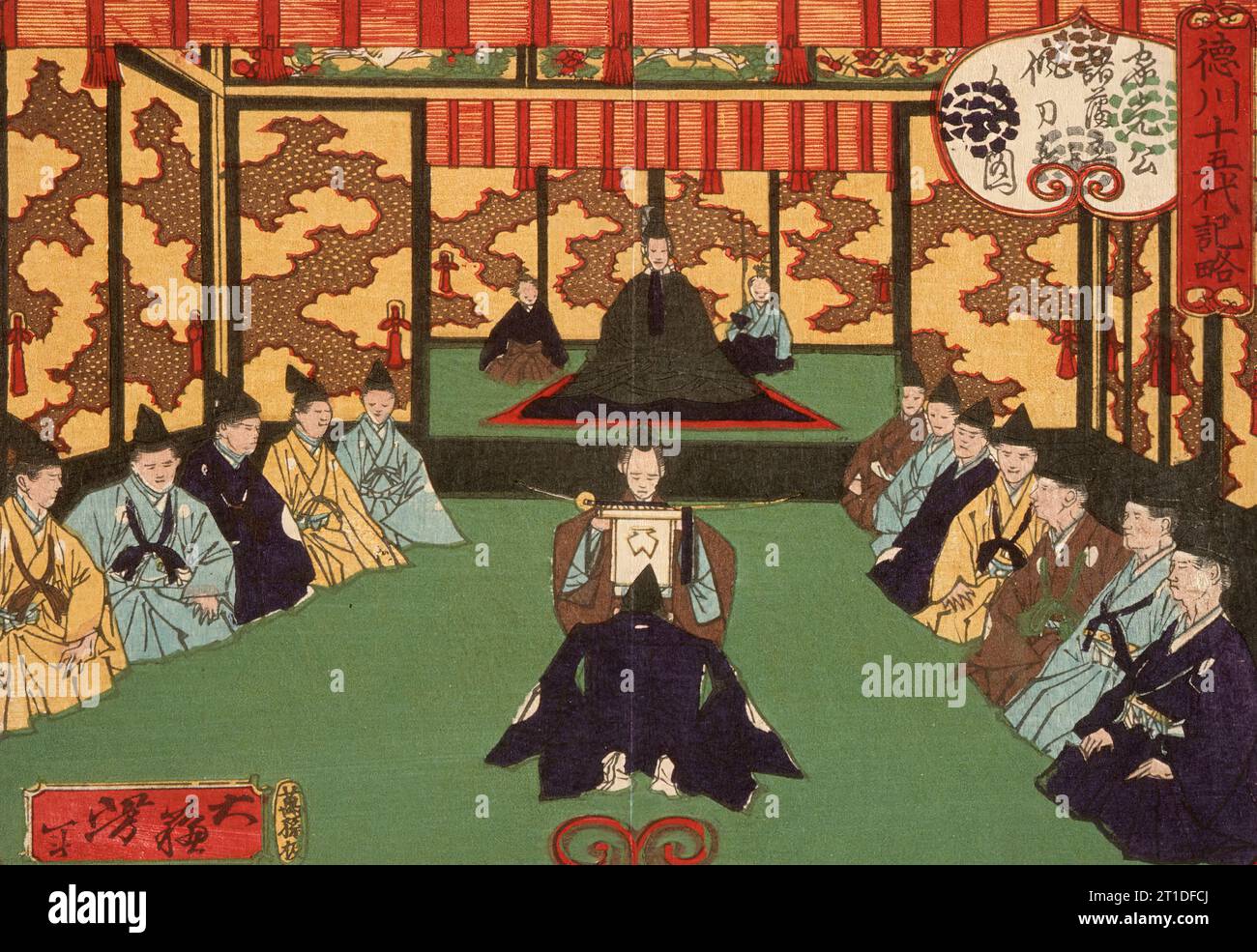 Tokugawa Iemitsu Receiving Lords in Audience, 1875. From Brief Account of the Rulers of the Tokugawa Clan. Stock Photohttps://www.alamy.com/image-license-details/?v=1https://www.alamy.com/tokugawa-iemitsu-receiving-lords-in-audience-1875-from-brief-account-of-the-rulers-of-the-tokugawa-clan-image568854290.html
Tokugawa Iemitsu Receiving Lords in Audience, 1875. From Brief Account of the Rulers of the Tokugawa Clan. Stock Photohttps://www.alamy.com/image-license-details/?v=1https://www.alamy.com/tokugawa-iemitsu-receiving-lords-in-audience-1875-from-brief-account-of-the-rulers-of-the-tokugawa-clan-image568854290.htmlRM2T1DFCJ–Tokugawa Iemitsu Receiving Lords in Audience, 1875. From Brief Account of the Rulers of the Tokugawa Clan.
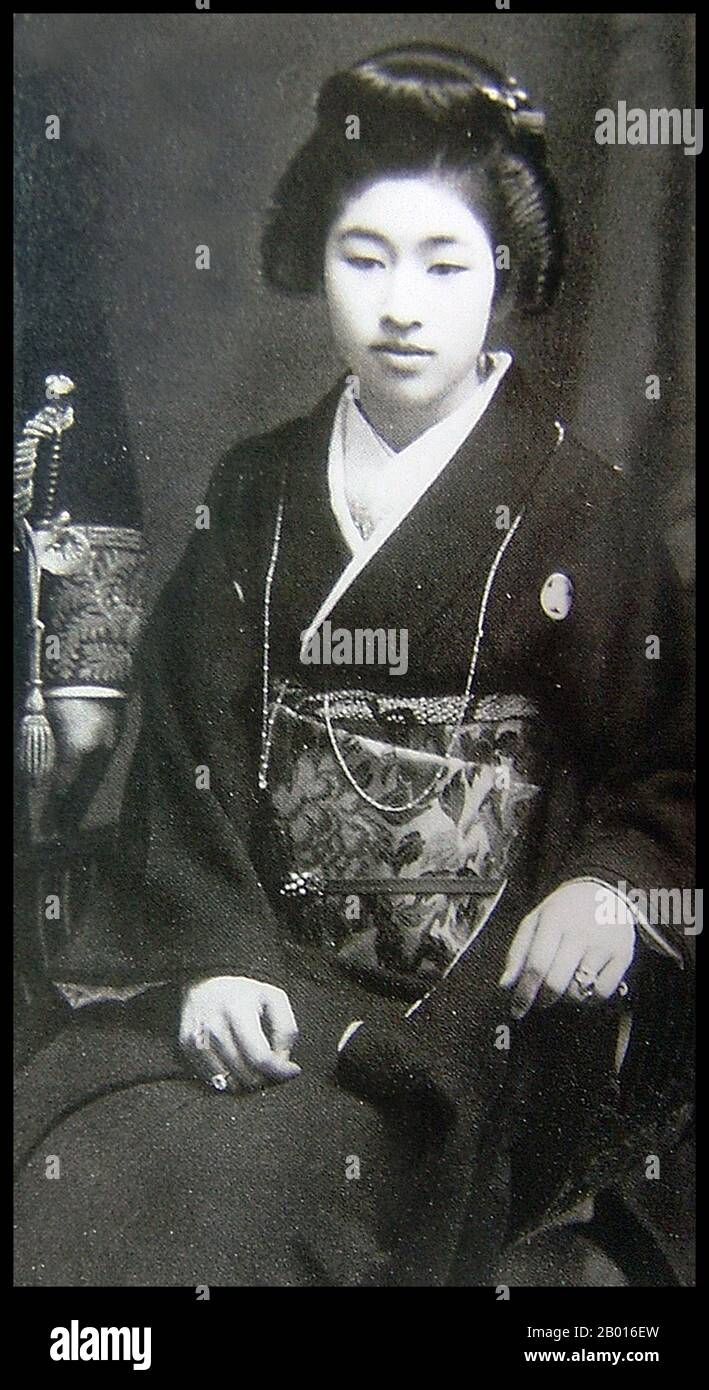 Japan: Tokugawa Mieko (1891-1944), wife of Prince of Tokugawa Yoshihisa. Photographic portrait, c. 1922. Tokugawa Mieko, born Arisugawa Mieko, was the wife of Prince Tokugawa Yoshihisa and the second daughter of Prince Arisugawa Takehito, tenth head of a cadet branch of the imperial family. Her daughter, Tokugawa Kikuko, would become the wife of Nobuhito, Prince Takamatsu, the third son of Emperor Taisho and younger brother of Emperor Showa. Stock Photohttps://www.alamy.com/image-license-details/?v=1https://www.alamy.com/japan-tokugawa-mieko-1891-1944-wife-of-prince-of-tokugawa-yoshihisa-photographic-portrait-c-1922-tokugawa-mieko-born-arisugawa-mieko-was-the-wife-of-prince-tokugawa-yoshihisa-and-the-second-daughter-of-prince-arisugawa-takehito-tenth-head-of-a-cadet-branch-of-the-imperial-family-her-daughter-tokugawa-kikuko-would-become-the-wife-of-nobuhito-prince-takamatsu-the-third-son-of-emperor-taisho-and-younger-brother-of-emperor-showa-image344234433.html
Japan: Tokugawa Mieko (1891-1944), wife of Prince of Tokugawa Yoshihisa. Photographic portrait, c. 1922. Tokugawa Mieko, born Arisugawa Mieko, was the wife of Prince Tokugawa Yoshihisa and the second daughter of Prince Arisugawa Takehito, tenth head of a cadet branch of the imperial family. Her daughter, Tokugawa Kikuko, would become the wife of Nobuhito, Prince Takamatsu, the third son of Emperor Taisho and younger brother of Emperor Showa. Stock Photohttps://www.alamy.com/image-license-details/?v=1https://www.alamy.com/japan-tokugawa-mieko-1891-1944-wife-of-prince-of-tokugawa-yoshihisa-photographic-portrait-c-1922-tokugawa-mieko-born-arisugawa-mieko-was-the-wife-of-prince-tokugawa-yoshihisa-and-the-second-daughter-of-prince-arisugawa-takehito-tenth-head-of-a-cadet-branch-of-the-imperial-family-her-daughter-tokugawa-kikuko-would-become-the-wife-of-nobuhito-prince-takamatsu-the-third-son-of-emperor-taisho-and-younger-brother-of-emperor-showa-image344234433.htmlRM2B016EW–Japan: Tokugawa Mieko (1891-1944), wife of Prince of Tokugawa Yoshihisa. Photographic portrait, c. 1922. Tokugawa Mieko, born Arisugawa Mieko, was the wife of Prince Tokugawa Yoshihisa and the second daughter of Prince Arisugawa Takehito, tenth head of a cadet branch of the imperial family. Her daughter, Tokugawa Kikuko, would become the wife of Nobuhito, Prince Takamatsu, the third son of Emperor Taisho and younger brother of Emperor Showa.
 Samurai armor with white lacing and helmet decorated with curls, owned by the Owari Tokugawa clan, Edo period, 17th century Stock Photohttps://www.alamy.com/image-license-details/?v=1https://www.alamy.com/samurai-armor-with-white-lacing-and-helmet-decorated-with-curls-owned-by-the-owari-tokugawa-clan-edo-period-17th-century-image327645334.html
Samurai armor with white lacing and helmet decorated with curls, owned by the Owari Tokugawa clan, Edo period, 17th century Stock Photohttps://www.alamy.com/image-license-details/?v=1https://www.alamy.com/samurai-armor-with-white-lacing-and-helmet-decorated-with-curls-owned-by-the-owari-tokugawa-clan-edo-period-17th-century-image327645334.htmlRF2A11EY2–Samurai armor with white lacing and helmet decorated with curls, owned by the Owari Tokugawa clan, Edo period, 17th century
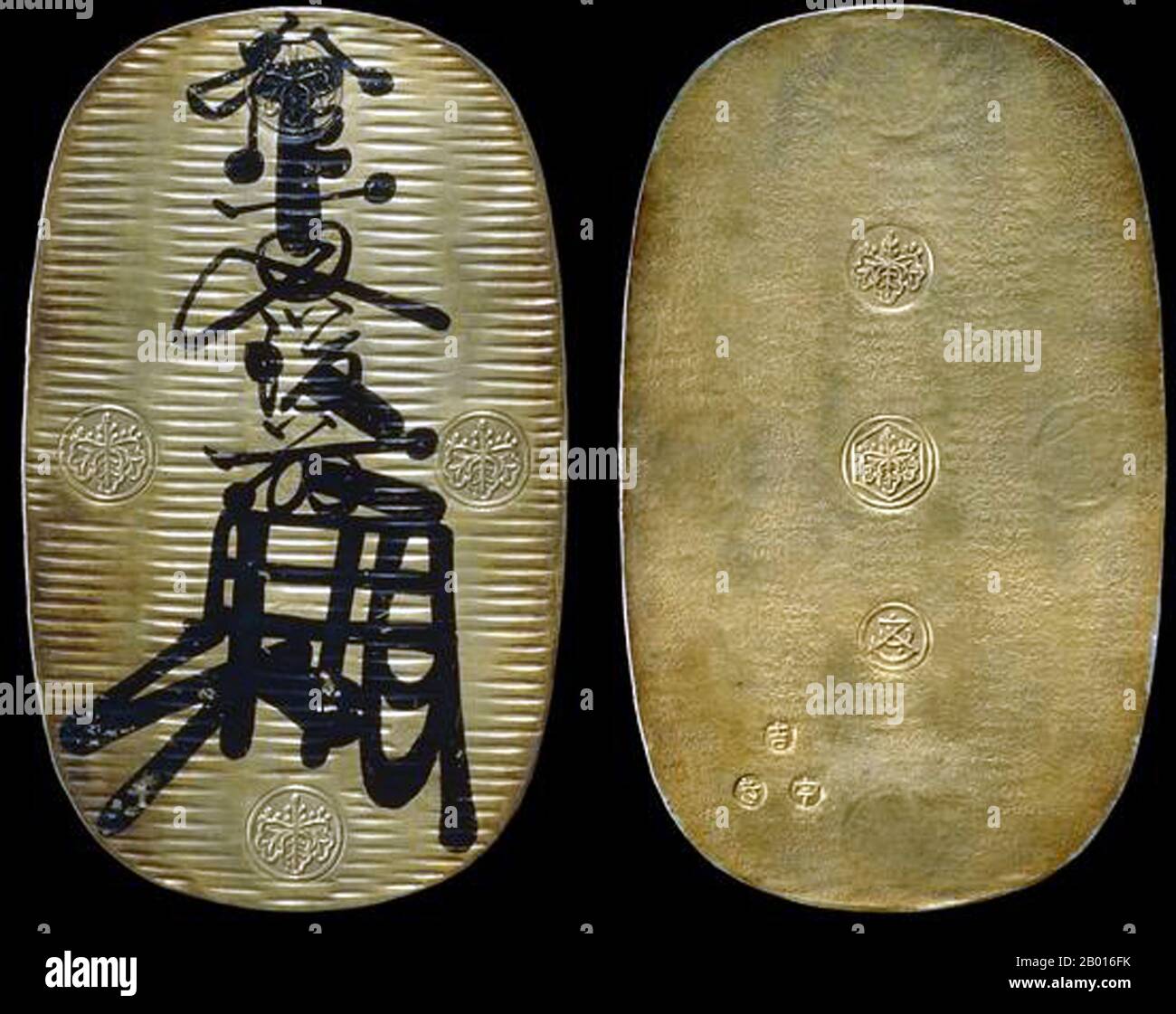 Japan: Gold koban of the Tokugawa Shogunate (1601-1695). The Tokugawa shogunate, also known as the Tokugawa bakufu and the Edo bakufu, was a feudal regime of Japan established by Tokugawa Ieyasu and ruled by the shoguns of the Tokugawa family. This period is known as the Edo period and gets its name from the capital city, Edo, which is now called Tokyo, after the name was changed in 1864. The Tokugawa shogunate ruled from Edo Castle from 1603 until 1868, when it was finally abolished during the Meiji Restoration. Stock Photohttps://www.alamy.com/image-license-details/?v=1https://www.alamy.com/japan-gold-koban-of-the-tokugawa-shogunate-1601-1695-the-tokugawa-shogunate-also-known-as-the-tokugawa-bakufu-and-the-edo-bakufu-was-a-feudal-regime-of-japan-established-by-tokugawa-ieyasu-and-ruled-by-the-shoguns-of-the-tokugawa-family-this-period-is-known-as-the-edo-period-and-gets-its-name-from-the-capital-city-edo-which-is-now-called-tokyo-after-the-name-was-changed-in-1864-the-tokugawa-shogunate-ruled-from-edo-castle-from-1603-until-1868-when-it-was-finally-abolished-during-the-meiji-restoration-image344234455.html
Japan: Gold koban of the Tokugawa Shogunate (1601-1695). The Tokugawa shogunate, also known as the Tokugawa bakufu and the Edo bakufu, was a feudal regime of Japan established by Tokugawa Ieyasu and ruled by the shoguns of the Tokugawa family. This period is known as the Edo period and gets its name from the capital city, Edo, which is now called Tokyo, after the name was changed in 1864. The Tokugawa shogunate ruled from Edo Castle from 1603 until 1868, when it was finally abolished during the Meiji Restoration. Stock Photohttps://www.alamy.com/image-license-details/?v=1https://www.alamy.com/japan-gold-koban-of-the-tokugawa-shogunate-1601-1695-the-tokugawa-shogunate-also-known-as-the-tokugawa-bakufu-and-the-edo-bakufu-was-a-feudal-regime-of-japan-established-by-tokugawa-ieyasu-and-ruled-by-the-shoguns-of-the-tokugawa-family-this-period-is-known-as-the-edo-period-and-gets-its-name-from-the-capital-city-edo-which-is-now-called-tokyo-after-the-name-was-changed-in-1864-the-tokugawa-shogunate-ruled-from-edo-castle-from-1603-until-1868-when-it-was-finally-abolished-during-the-meiji-restoration-image344234455.htmlRM2B016FK–Japan: Gold koban of the Tokugawa Shogunate (1601-1695). The Tokugawa shogunate, also known as the Tokugawa bakufu and the Edo bakufu, was a feudal regime of Japan established by Tokugawa Ieyasu and ruled by the shoguns of the Tokugawa family. This period is known as the Edo period and gets its name from the capital city, Edo, which is now called Tokyo, after the name was changed in 1864. The Tokugawa shogunate ruled from Edo Castle from 1603 until 1868, when it was finally abolished during the Meiji Restoration.
 The cemetery behind the Great Hall in Zojoji, where Tokugawa shoguns were buried. Tokyo Tower in the background, Tokyo, Japan. Stock Photohttps://www.alamy.com/image-license-details/?v=1https://www.alamy.com/the-cemetery-behind-the-great-hall-in-zojoji-where-tokugawa-shoguns-were-buried-tokyo-tower-in-the-background-tokyo-japan-image610151884.html
The cemetery behind the Great Hall in Zojoji, where Tokugawa shoguns were buried. Tokyo Tower in the background, Tokyo, Japan. Stock Photohttps://www.alamy.com/image-license-details/?v=1https://www.alamy.com/the-cemetery-behind-the-great-hall-in-zojoji-where-tokugawa-shoguns-were-buried-tokyo-tower-in-the-background-tokyo-japan-image610151884.htmlRF2XCJPXM–The cemetery behind the Great Hall in Zojoji, where Tokugawa shoguns were buried. Tokyo Tower in the background, Tokyo, Japan.
 Japan: Tomb of Tokugawa Ieshige (28 January 1712 – 13 July 1761), 14th Tokugawa Shogun, Shiba Park, Tokyo, c. 1895. Tokugawa Ieshige was the ninth shogun of the Tokugawa shogunate of Japan. Ieshige's posthumous title was Junshin-in, and his grave was at the Tokugawa family mausoleum at Zōjō-ji in Shiba. His remains were disinterred and underwent scientific investigation from 1958-1960. It was discovered that his teeth were crooked and badly deformed, confirming historical references to his speech defect. Stock Photohttps://www.alamy.com/image-license-details/?v=1https://www.alamy.com/japan-tomb-of-tokugawa-ieshige-28-january-1712-13-july-1761-14th-tokugawa-shogun-shiba-park-tokyo-c-1895-tokugawa-ieshige-was-the-ninth-shogun-of-the-tokugawa-shogunate-of-japan-ieshiges-posthumous-title-was-junshin-in-and-his-grave-was-at-the-tokugawa-family-mausoleum-at-zj-ji-in-shiba-his-remains-were-disinterred-and-underwent-scientific-investigation-from-1958-1960-it-was-discovered-that-his-teeth-were-crooked-and-badly-deformed-confirming-historical-references-to-his-speech-defect-image344234880.html
Japan: Tomb of Tokugawa Ieshige (28 January 1712 – 13 July 1761), 14th Tokugawa Shogun, Shiba Park, Tokyo, c. 1895. Tokugawa Ieshige was the ninth shogun of the Tokugawa shogunate of Japan. Ieshige's posthumous title was Junshin-in, and his grave was at the Tokugawa family mausoleum at Zōjō-ji in Shiba. His remains were disinterred and underwent scientific investigation from 1958-1960. It was discovered that his teeth were crooked and badly deformed, confirming historical references to his speech defect. Stock Photohttps://www.alamy.com/image-license-details/?v=1https://www.alamy.com/japan-tomb-of-tokugawa-ieshige-28-january-1712-13-july-1761-14th-tokugawa-shogun-shiba-park-tokyo-c-1895-tokugawa-ieshige-was-the-ninth-shogun-of-the-tokugawa-shogunate-of-japan-ieshiges-posthumous-title-was-junshin-in-and-his-grave-was-at-the-tokugawa-family-mausoleum-at-zj-ji-in-shiba-his-remains-were-disinterred-and-underwent-scientific-investigation-from-1958-1960-it-was-discovered-that-his-teeth-were-crooked-and-badly-deformed-confirming-historical-references-to-his-speech-defect-image344234880.htmlRM2B0172T–Japan: Tomb of Tokugawa Ieshige (28 January 1712 – 13 July 1761), 14th Tokugawa Shogun, Shiba Park, Tokyo, c. 1895. Tokugawa Ieshige was the ninth shogun of the Tokugawa shogunate of Japan. Ieshige's posthumous title was Junshin-in, and his grave was at the Tokugawa family mausoleum at Zōjō-ji in Shiba. His remains were disinterred and underwent scientific investigation from 1958-1960. It was discovered that his teeth were crooked and badly deformed, confirming historical references to his speech defect.
 Tokugawa Family Mausoleum on Koyasan (Mt. Koya), dedicated to the first Tokugawa shogun Ieyasu, Wakayama prefecture, Japan Stock Photohttps://www.alamy.com/image-license-details/?v=1https://www.alamy.com/tokugawa-family-mausoleum-on-koyasan-mt-koya-dedicated-to-the-first-tokugawa-shogun-ieyasu-wakayama-prefecture-japan-image369202810.html
Tokugawa Family Mausoleum on Koyasan (Mt. Koya), dedicated to the first Tokugawa shogun Ieyasu, Wakayama prefecture, Japan Stock Photohttps://www.alamy.com/image-license-details/?v=1https://www.alamy.com/tokugawa-family-mausoleum-on-koyasan-mt-koya-dedicated-to-the-first-tokugawa-shogun-ieyasu-wakayama-prefecture-japan-image369202810.htmlRF2CCJHXJ–Tokugawa Family Mausoleum on Koyasan (Mt. Koya), dedicated to the first Tokugawa shogun Ieyasu, Wakayama prefecture, Japan
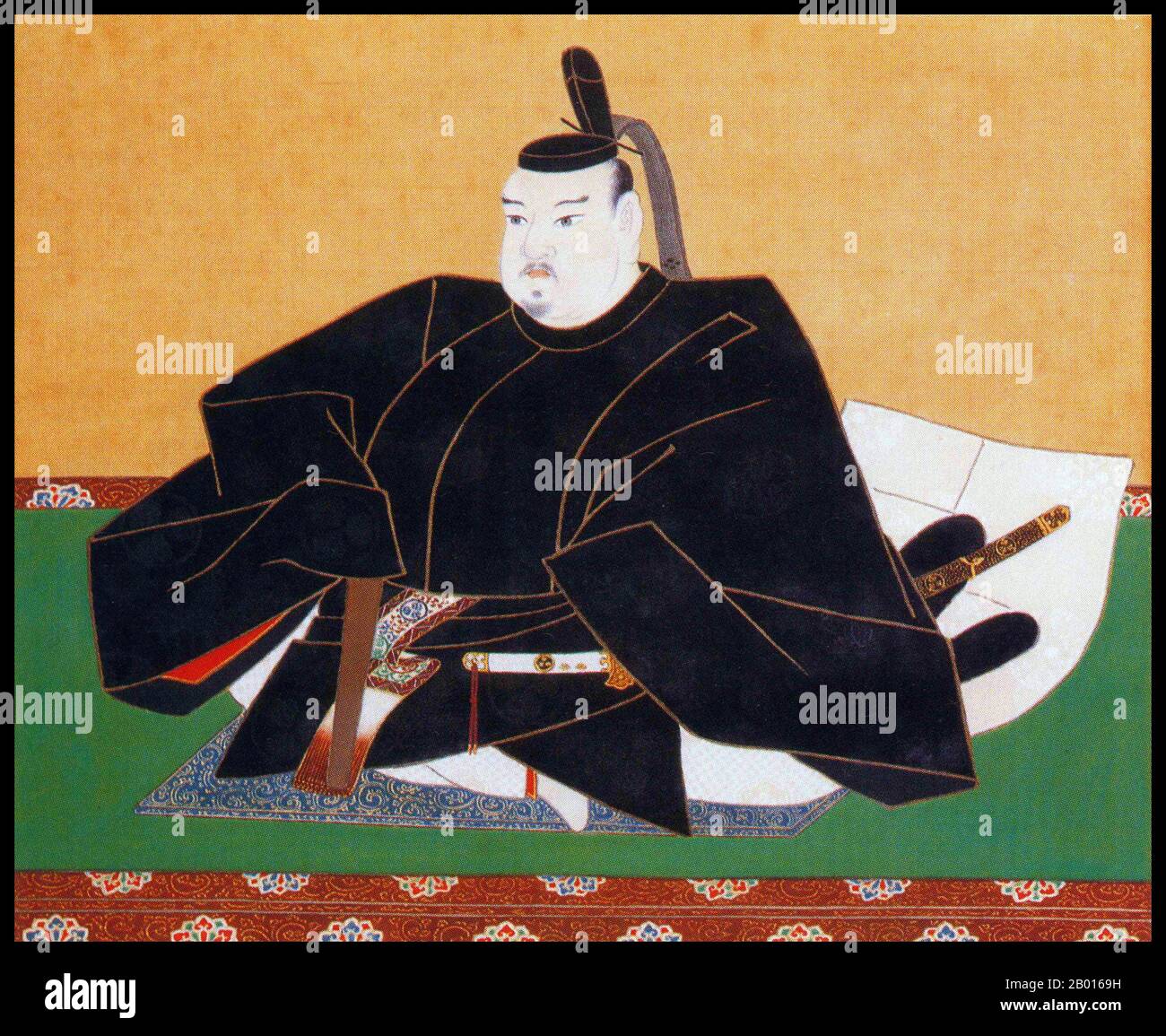 Japan: Tokugawa Iemitsu (1604-1651), third ruler of the Tokugawa Shogunate (r. 1623-1651). Hanging scroll painting, 17th century. Tokugawa Iemitsu, born Takechiyo, was the third shogun of the Tokugawa dynasty and the eldest son of Tokugawa Hidetada. His wet nurse, Lady Kasuga, also served as his political advisor and was central to shogunate negotiations with the Imperial court. His rule was marked by his intense xenophobia, with the borders closed and all Europeans expelled, as well as Christians brutally crucified. This xenophobic attitude would persist in Japan for over 200 years. Stock Photohttps://www.alamy.com/image-license-details/?v=1https://www.alamy.com/japan-tokugawa-iemitsu-1604-1651-third-ruler-of-the-tokugawa-shogunate-r-1623-1651-hanging-scroll-painting-17th-century-tokugawa-iemitsu-born-takechiyo-was-the-third-shogun-of-the-tokugawa-dynasty-and-the-eldest-son-of-tokugawa-hidetada-his-wet-nurse-lady-kasuga-also-served-as-his-political-advisor-and-was-central-to-shogunate-negotiations-with-the-imperial-court-his-rule-was-marked-by-his-intense-xenophobia-with-the-borders-closed-and-all-europeans-expelled-as-well-as-christians-brutally-crucified-this-xenophobic-attitude-would-persist-in-japan-for-over-200-years-image344234285.html
Japan: Tokugawa Iemitsu (1604-1651), third ruler of the Tokugawa Shogunate (r. 1623-1651). Hanging scroll painting, 17th century. Tokugawa Iemitsu, born Takechiyo, was the third shogun of the Tokugawa dynasty and the eldest son of Tokugawa Hidetada. His wet nurse, Lady Kasuga, also served as his political advisor and was central to shogunate negotiations with the Imperial court. His rule was marked by his intense xenophobia, with the borders closed and all Europeans expelled, as well as Christians brutally crucified. This xenophobic attitude would persist in Japan for over 200 years. Stock Photohttps://www.alamy.com/image-license-details/?v=1https://www.alamy.com/japan-tokugawa-iemitsu-1604-1651-third-ruler-of-the-tokugawa-shogunate-r-1623-1651-hanging-scroll-painting-17th-century-tokugawa-iemitsu-born-takechiyo-was-the-third-shogun-of-the-tokugawa-dynasty-and-the-eldest-son-of-tokugawa-hidetada-his-wet-nurse-lady-kasuga-also-served-as-his-political-advisor-and-was-central-to-shogunate-negotiations-with-the-imperial-court-his-rule-was-marked-by-his-intense-xenophobia-with-the-borders-closed-and-all-europeans-expelled-as-well-as-christians-brutally-crucified-this-xenophobic-attitude-would-persist-in-japan-for-over-200-years-image344234285.htmlRM2B0169H–Japan: Tokugawa Iemitsu (1604-1651), third ruler of the Tokugawa Shogunate (r. 1623-1651). Hanging scroll painting, 17th century. Tokugawa Iemitsu, born Takechiyo, was the third shogun of the Tokugawa dynasty and the eldest son of Tokugawa Hidetada. His wet nurse, Lady Kasuga, also served as his political advisor and was central to shogunate negotiations with the Imperial court. His rule was marked by his intense xenophobia, with the borders closed and all Europeans expelled, as well as Christians brutally crucified. This xenophobic attitude would persist in Japan for over 200 years.
 Detail of elite samurai from Shinsengumi clan in Kyoto wearing unique blue and white kimono carrying sword Stock Photohttps://www.alamy.com/image-license-details/?v=1https://www.alamy.com/stock-photo-detail-of-elite-samurai-from-shinsengumi-clan-in-kyoto-wearing-unique-18793797.html
Detail of elite samurai from Shinsengumi clan in Kyoto wearing unique blue and white kimono carrying sword Stock Photohttps://www.alamy.com/image-license-details/?v=1https://www.alamy.com/stock-photo-detail-of-elite-samurai-from-shinsengumi-clan-in-kyoto-wearing-unique-18793797.htmlRMB2G3K1–Detail of elite samurai from Shinsengumi clan in Kyoto wearing unique blue and white kimono carrying sword
 Tokyo, Japan - December 09, 2015: Japanese zojoji temple near the Tokyo tower . Zojo-ji is notable for its relationship with the Tokugawa clan, the ru Stock Photohttps://www.alamy.com/image-license-details/?v=1https://www.alamy.com/tokyo-japan-december-09-2015-japanese-zojoji-temple-near-the-tokyo-tower-zojo-ji-is-notable-for-its-relationship-with-the-tokugawa-clan-the-ru-image417763475.html
Tokyo, Japan - December 09, 2015: Japanese zojoji temple near the Tokyo tower . Zojo-ji is notable for its relationship with the Tokugawa clan, the ru Stock Photohttps://www.alamy.com/image-license-details/?v=1https://www.alamy.com/tokyo-japan-december-09-2015-japanese-zojoji-temple-near-the-tokyo-tower-zojo-ji-is-notable-for-its-relationship-with-the-tokugawa-clan-the-ru-image417763475.htmlRM2F7JNG3–Tokyo, Japan - December 09, 2015: Japanese zojoji temple near the Tokyo tower . Zojo-ji is notable for its relationship with the Tokugawa clan, the ru
 Detail of elite samurai from Shinsengumi clan in Kyoto wearing unique blue and white kimono carrying sword Stock Photohttps://www.alamy.com/image-license-details/?v=1https://www.alamy.com/stock-photo-detail-of-elite-samurai-from-shinsengumi-clan-in-kyoto-wearing-unique-18599644.html
Detail of elite samurai from Shinsengumi clan in Kyoto wearing unique blue and white kimono carrying sword Stock Photohttps://www.alamy.com/image-license-details/?v=1https://www.alamy.com/stock-photo-detail-of-elite-samurai-from-shinsengumi-clan-in-kyoto-wearing-unique-18599644.htmlRMB27810–Detail of elite samurai from Shinsengumi clan in Kyoto wearing unique blue and white kimono carrying sword
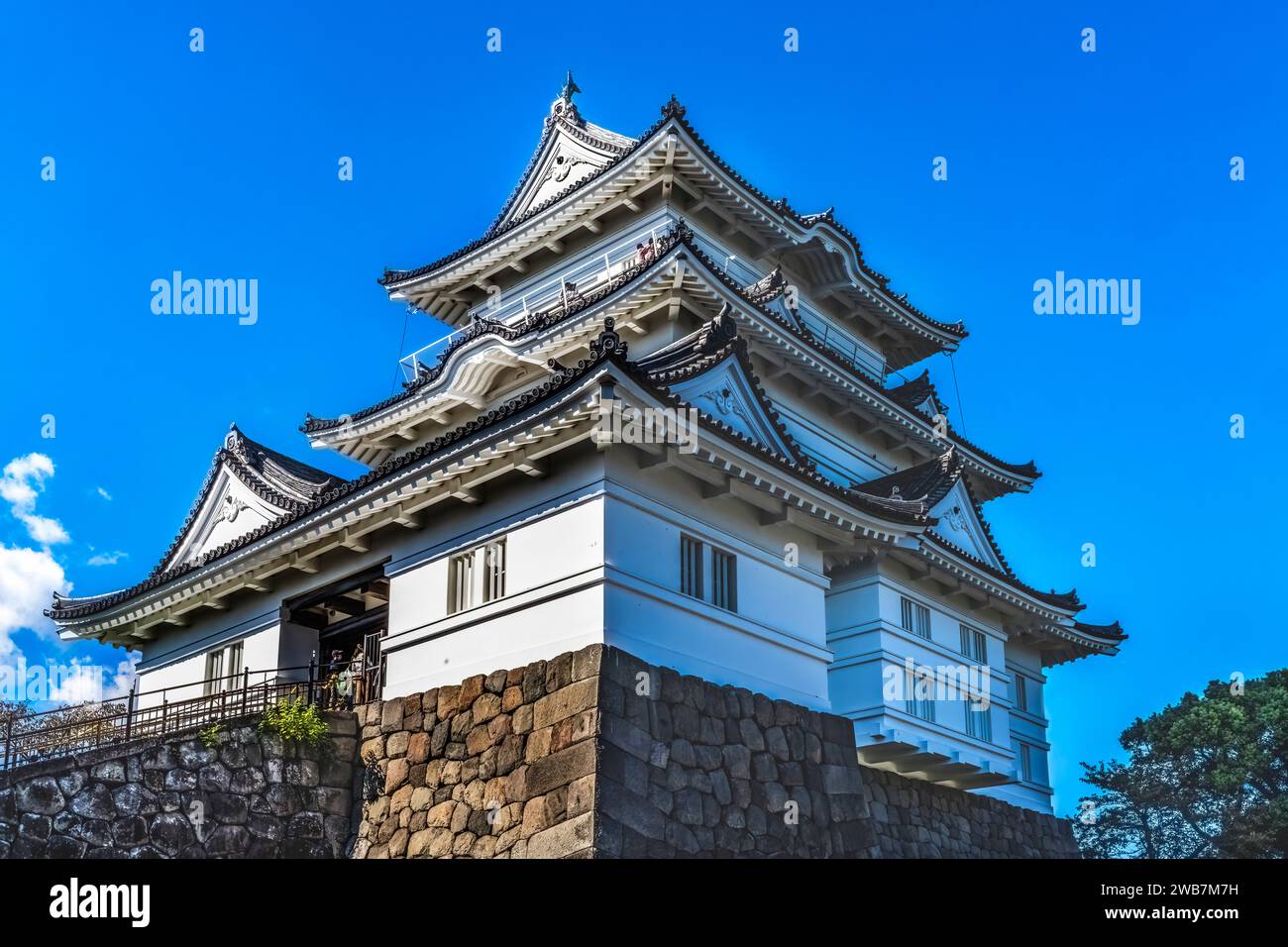 Hojo Castle Odawara Kanagawa Japan. Hojo Clan controlled castle to 1590, when Heideyoshi defeated the Hojo. Castle was given to Tokugawa Ieyasu. Cast Stock Photohttps://www.alamy.com/image-license-details/?v=1https://www.alamy.com/hojo-castle-odawara-kanagawa-japan-hojo-clan-controlled-castle-to-1590-when-heideyoshi-defeated-the-hojo-castle-was-given-to-tokugawa-ieyasu-cast-image592083285.html
Hojo Castle Odawara Kanagawa Japan. Hojo Clan controlled castle to 1590, when Heideyoshi defeated the Hojo. Castle was given to Tokugawa Ieyasu. Cast Stock Photohttps://www.alamy.com/image-license-details/?v=1https://www.alamy.com/hojo-castle-odawara-kanagawa-japan-hojo-clan-controlled-castle-to-1590-when-heideyoshi-defeated-the-hojo-castle-was-given-to-tokugawa-ieyasu-cast-image592083285.htmlRF2WB7M7H–Hojo Castle Odawara Kanagawa Japan. Hojo Clan controlled castle to 1590, when Heideyoshi defeated the Hojo. Castle was given to Tokugawa Ieyasu. Cast
 Tokyo, Japan - Jizo Statues at Zojoji Temple in Tokyo, Japan. Zojoji Temple is notable for its relationship with the Tokugawa clan. Stock Photohttps://www.alamy.com/image-license-details/?v=1https://www.alamy.com/tokyo-japan-jizo-statues-at-zojoji-temple-in-tokyo-japan-zojoji-temple-is-notable-for-its-relationship-with-the-tokugawa-clan-image369151416.html
Tokyo, Japan - Jizo Statues at Zojoji Temple in Tokyo, Japan. Zojoji Temple is notable for its relationship with the Tokugawa clan. Stock Photohttps://www.alamy.com/image-license-details/?v=1https://www.alamy.com/tokyo-japan-jizo-statues-at-zojoji-temple-in-tokyo-japan-zojoji-temple-is-notable-for-its-relationship-with-the-tokugawa-clan-image369151416.htmlRF2CCG8B4–Tokyo, Japan - Jizo Statues at Zojoji Temple in Tokyo, Japan. Zojoji Temple is notable for its relationship with the Tokugawa clan.
 Samurai warrior from elite Shinsengumi clan in Kyoto wearing unique blue and white kimono demonstrating swordsmanship techniques Stock Photohttps://www.alamy.com/image-license-details/?v=1https://www.alamy.com/stock-photo-samurai-warrior-from-elite-shinsengumi-clan-in-kyoto-wearing-unique-18793772.html
Samurai warrior from elite Shinsengumi clan in Kyoto wearing unique blue and white kimono demonstrating swordsmanship techniques Stock Photohttps://www.alamy.com/image-license-details/?v=1https://www.alamy.com/stock-photo-samurai-warrior-from-elite-shinsengumi-clan-in-kyoto-wearing-unique-18793772.htmlRMB2G3J4–Samurai warrior from elite Shinsengumi clan in Kyoto wearing unique blue and white kimono demonstrating swordsmanship techniques
 Roof tile of Tokiwagi-mon Gate, Odawara Castle Park, Odawara City, Kanagawa, Japan. Mitubaoi design (family crest of Tokugawa family) is seen. Stock Photohttps://www.alamy.com/image-license-details/?v=1https://www.alamy.com/roof-tile-of-tokiwagi-mon-gate-odawara-castle-park-odawara-city-kanagawa-japan-mitubaoi-design-family-crest-of-tokugawa-family-is-seen-image457101858.html
Roof tile of Tokiwagi-mon Gate, Odawara Castle Park, Odawara City, Kanagawa, Japan. Mitubaoi design (family crest of Tokugawa family) is seen. Stock Photohttps://www.alamy.com/image-license-details/?v=1https://www.alamy.com/roof-tile-of-tokiwagi-mon-gate-odawara-castle-park-odawara-city-kanagawa-japan-mitubaoi-design-family-crest-of-tokugawa-family-is-seen-image457101858.htmlRM2HFJP2A–Roof tile of Tokiwagi-mon Gate, Odawara Castle Park, Odawara City, Kanagawa, Japan. Mitubaoi design (family crest of Tokugawa family) is seen.
 Koyasan, Koya, Ito District, Wakayama, Japan, 2022/03/05 , Tokugawa Clan Mausoleum. From grandfather to son. Set apart from the other religious sites Stock Photohttps://www.alamy.com/image-license-details/?v=1https://www.alamy.com/koyasan-koya-ito-district-wakayama-japan-20220305-tokugawa-clan-mausoleum-from-grandfather-to-son-set-apart-from-the-other-religious-sites-image470620514.html
Koyasan, Koya, Ito District, Wakayama, Japan, 2022/03/05 , Tokugawa Clan Mausoleum. From grandfather to son. Set apart from the other religious sites Stock Photohttps://www.alamy.com/image-license-details/?v=1https://www.alamy.com/koyasan-koya-ito-district-wakayama-japan-20220305-tokugawa-clan-mausoleum-from-grandfather-to-son-set-apart-from-the-other-religious-sites-image470620514.htmlRF2J9JH7E–Koyasan, Koya, Ito District, Wakayama, Japan, 2022/03/05 , Tokugawa Clan Mausoleum. From grandfather to son. Set apart from the other religious sites
 haiden worship hall Stock Photohttps://www.alamy.com/image-license-details/?v=1https://www.alamy.com/haiden-worship-hall-image479769539.html
haiden worship hall Stock Photohttps://www.alamy.com/image-license-details/?v=1https://www.alamy.com/haiden-worship-hall-image479769539.htmlRM2JTFAXB–haiden worship hall
 Golden coat of arms of the Shogun clan Tokugawa of ancient capital Edo which symbolizes three leaves of hollyhocks. Stock Photohttps://www.alamy.com/image-license-details/?v=1https://www.alamy.com/golden-coat-of-arms-of-the-shogun-clan-tokugawa-of-ancient-capital-edo-which-symbolizes-three-leaves-of-hollyhocks-image332290782.html
Golden coat of arms of the Shogun clan Tokugawa of ancient capital Edo which symbolizes three leaves of hollyhocks. Stock Photohttps://www.alamy.com/image-license-details/?v=1https://www.alamy.com/golden-coat-of-arms-of-the-shogun-clan-tokugawa-of-ancient-capital-edo-which-symbolizes-three-leaves-of-hollyhocks-image332290782.htmlRF2A8H47X–Golden coat of arms of the Shogun clan Tokugawa of ancient capital Edo which symbolizes three leaves of hollyhocks.
 Nanzenji Temple (南禅寺) Hojo Rock Garden. Kyoto Stock Photohttps://www.alamy.com/image-license-details/?v=1https://www.alamy.com/nanzenji-temple-hojo-rock-garden-kyoto-image366883891.html
Nanzenji Temple (南禅寺) Hojo Rock Garden. Kyoto Stock Photohttps://www.alamy.com/image-license-details/?v=1https://www.alamy.com/nanzenji-temple-hojo-rock-garden-kyoto-image366883891.htmlRF2C8W043–Nanzenji Temple (南禅寺) Hojo Rock Garden. Kyoto
 Tokugawa Ieyasu Examining the Head of Kimura Shigenari at the Battle of Osaka Castle, 1875. From Brief Account of the Rulers of the Tokugawa Clan. Stock Photohttps://www.alamy.com/image-license-details/?v=1https://www.alamy.com/tokugawa-ieyasu-examining-the-head-of-kimura-shigenari-at-the-battle-of-osaka-castle-1875-from-brief-account-of-the-rulers-of-the-tokugawa-clan-image568854373.html
Tokugawa Ieyasu Examining the Head of Kimura Shigenari at the Battle of Osaka Castle, 1875. From Brief Account of the Rulers of the Tokugawa Clan. Stock Photohttps://www.alamy.com/image-license-details/?v=1https://www.alamy.com/tokugawa-ieyasu-examining-the-head-of-kimura-shigenari-at-the-battle-of-osaka-castle-1875-from-brief-account-of-the-rulers-of-the-tokugawa-clan-image568854373.htmlRM2T1DFFH–Tokugawa Ieyasu Examining the Head of Kimura Shigenari at the Battle of Osaka Castle, 1875. From Brief Account of the Rulers of the Tokugawa Clan.
 Matsue castle Honshu Japan Stock Photohttps://www.alamy.com/image-license-details/?v=1https://www.alamy.com/matsue-castle-honshu-japan-image1392976.html
Matsue castle Honshu Japan Stock Photohttps://www.alamy.com/image-license-details/?v=1https://www.alamy.com/matsue-castle-honshu-japan-image1392976.htmlRMAN4151–Matsue castle Honshu Japan
 Samurai armor with white lacing and helmet decorated with curls, owned by the Owari Tokugawa clan, Edo period, 17th century Stock Photohttps://www.alamy.com/image-license-details/?v=1https://www.alamy.com/samurai-armor-with-white-lacing-and-helmet-decorated-with-curls-owned-by-the-owari-tokugawa-clan-edo-period-17th-century-image327645237.html
Samurai armor with white lacing and helmet decorated with curls, owned by the Owari Tokugawa clan, Edo period, 17th century Stock Photohttps://www.alamy.com/image-license-details/?v=1https://www.alamy.com/samurai-armor-with-white-lacing-and-helmet-decorated-with-curls-owned-by-the-owari-tokugawa-clan-edo-period-17th-century-image327645237.htmlRF2A11ERH–Samurai armor with white lacing and helmet decorated with curls, owned by the Owari Tokugawa clan, Edo period, 17th century
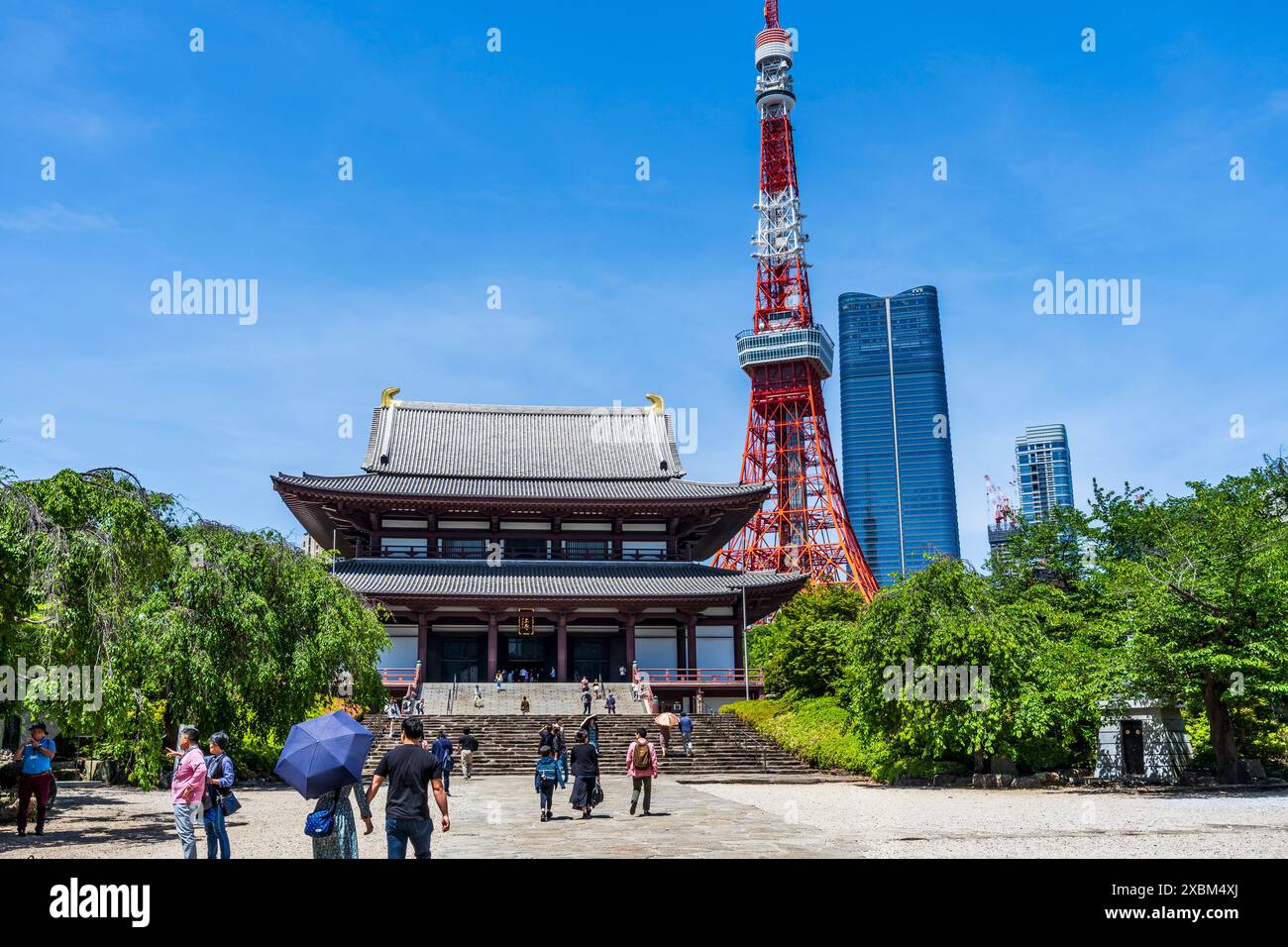 Tokyo, Japan - May 10th, 2024: The 'Daiden' (great hall) of Zojo-ji temple with the Tokyo Tower in the background, with tourists, Tokyo Stock Photohttps://www.alamy.com/image-license-details/?v=1https://www.alamy.com/tokyo-japan-may-10th-2024-the-daiden-great-hall-of-zojo-ji-temple-with-the-tokyo-tower-in-the-background-with-tourists-tokyo-image609567018.html
Tokyo, Japan - May 10th, 2024: The 'Daiden' (great hall) of Zojo-ji temple with the Tokyo Tower in the background, with tourists, Tokyo Stock Photohttps://www.alamy.com/image-license-details/?v=1https://www.alamy.com/tokyo-japan-may-10th-2024-the-daiden-great-hall-of-zojo-ji-temple-with-the-tokyo-tower-in-the-background-with-tourists-tokyo-image609567018.htmlRF2XBM4XJ–Tokyo, Japan - May 10th, 2024: The 'Daiden' (great hall) of Zojo-ji temple with the Tokyo Tower in the background, with tourists, Tokyo
 Koishikawa Kōrakuen Garden Stock Photohttps://www.alamy.com/image-license-details/?v=1https://www.alamy.com/stock-photo-koishikawa-krakuen-garden-140482267.html
Koishikawa Kōrakuen Garden Stock Photohttps://www.alamy.com/image-license-details/?v=1https://www.alamy.com/stock-photo-koishikawa-krakuen-garden-140482267.htmlRFJ4FEFR–Koishikawa Kōrakuen Garden
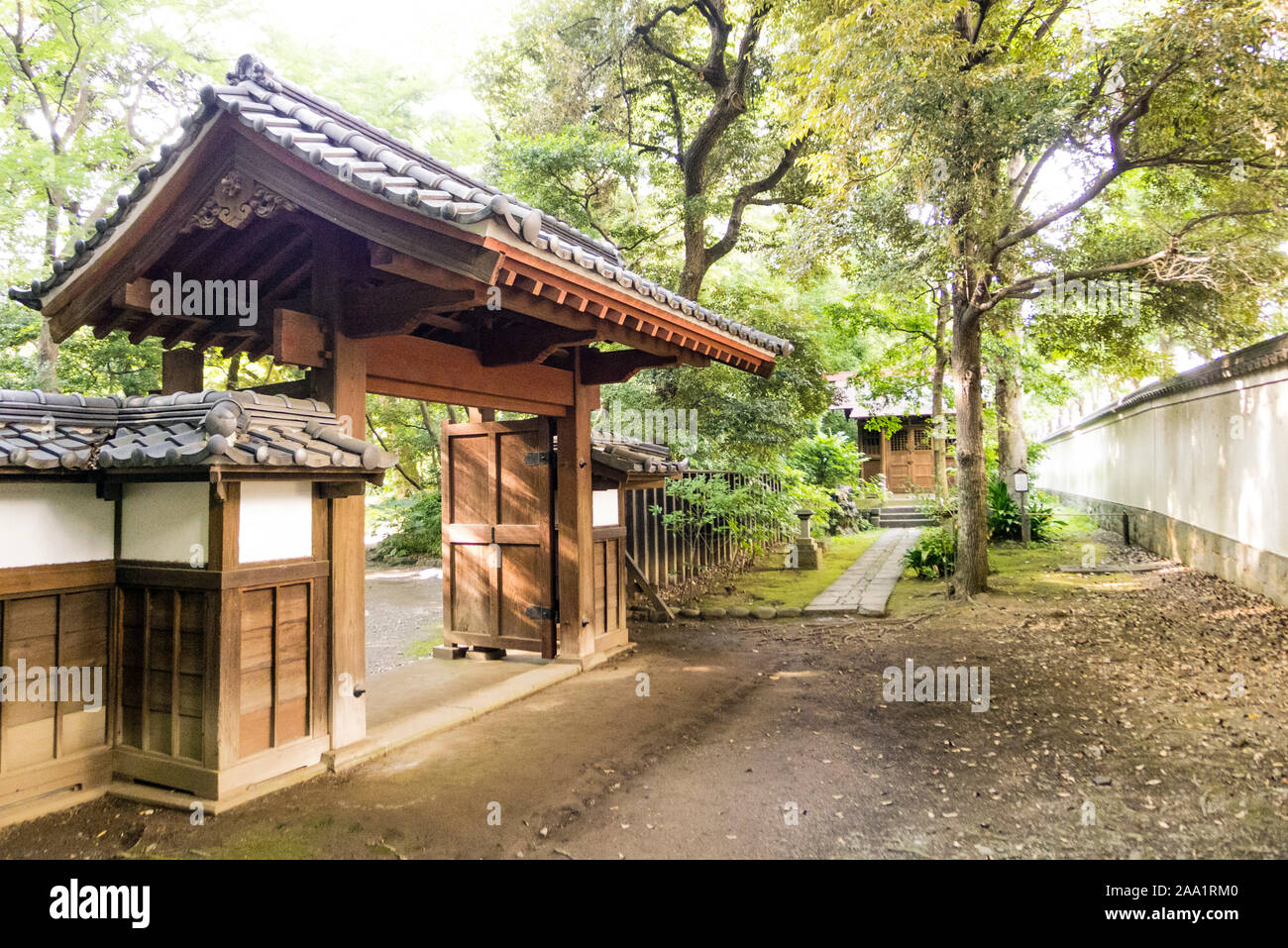 Traditional Japanese House Gate on Tiny Alley of Tokyo Stock Photohttps://www.alamy.com/image-license-details/?v=1https://www.alamy.com/traditional-japanese-house-gate-on-tiny-alley-of-tokyo-image333184096.html
Traditional Japanese House Gate on Tiny Alley of Tokyo Stock Photohttps://www.alamy.com/image-license-details/?v=1https://www.alamy.com/traditional-japanese-house-gate-on-tiny-alley-of-tokyo-image333184096.htmlRF2AA1RM0–Traditional Japanese House Gate on Tiny Alley of Tokyo
 Roof decorations on Tokugawa Family Mausoleum on Koyasan (Mt. Koya), dedicated to the first Tokugawa shogun Ieyasu, Wakayama prefecture, Japan Stock Photohttps://www.alamy.com/image-license-details/?v=1https://www.alamy.com/roof-decorations-on-tokugawa-family-mausoleum-on-koyasan-mt-koya-dedicated-to-the-first-tokugawa-shogun-ieyasu-wakayama-prefecture-japan-image369202782.html
Roof decorations on Tokugawa Family Mausoleum on Koyasan (Mt. Koya), dedicated to the first Tokugawa shogun Ieyasu, Wakayama prefecture, Japan Stock Photohttps://www.alamy.com/image-license-details/?v=1https://www.alamy.com/roof-decorations-on-tokugawa-family-mausoleum-on-koyasan-mt-koya-dedicated-to-the-first-tokugawa-shogun-ieyasu-wakayama-prefecture-japan-image369202782.htmlRF2CCJHWJ–Roof decorations on Tokugawa Family Mausoleum on Koyasan (Mt. Koya), dedicated to the first Tokugawa shogun Ieyasu, Wakayama prefecture, Japan
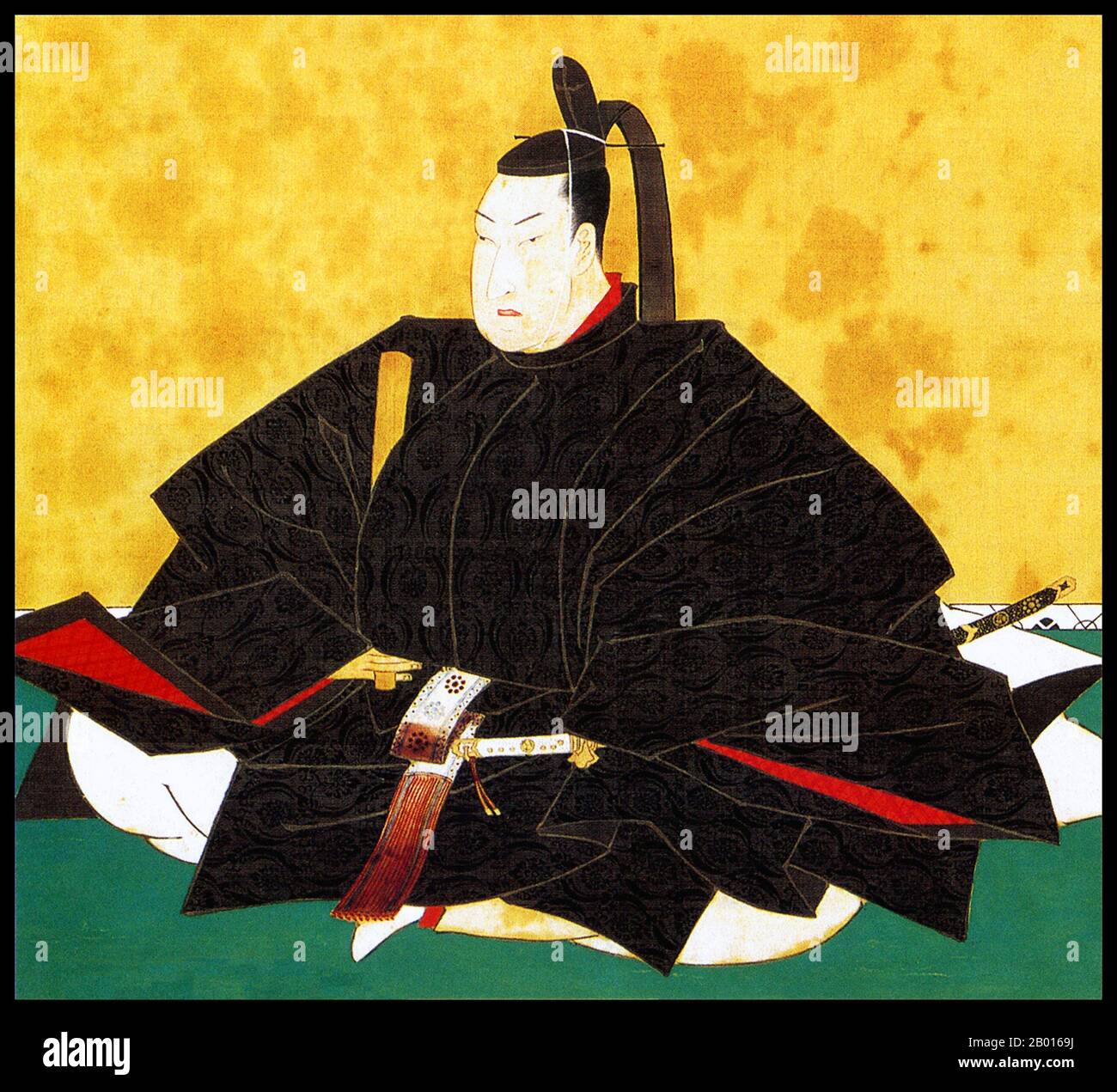 Japan: Tokugawa Tsunayoshi (23 February 1646 - 19 February 1709), fifth ruler of the Tokugawa Shogunate (r. 1680-1709). Hanging scroll painting by Tosa Mitsuoki (1617-1691), 17th century. Tokugawa Tsunayoshi, born Tokumatsu, was the fifth shogun of the Tokugawa dynasty and the son of Tokugawa Iemitsu. When his older brother, the shogun Tokugawa Ieyasu, died without leaving an heir, Tsunayoshi was chosen to succeed him. He was puritanical, banning prostitution and waitresses, and instituted animal protection laws, earning him the pejorative nickname of 'the dog shogun'. Stock Photohttps://www.alamy.com/image-license-details/?v=1https://www.alamy.com/japan-tokugawa-tsunayoshi-23-february-1646-19-february-1709-fifth-ruler-of-the-tokugawa-shogunate-r-1680-1709-hanging-scroll-painting-by-tosa-mitsuoki-1617-1691-17th-century-tokugawa-tsunayoshi-born-tokumatsu-was-the-fifth-shogun-of-the-tokugawa-dynasty-and-the-son-of-tokugawa-iemitsu-when-his-older-brother-the-shogun-tokugawa-ieyasu-died-without-leaving-an-heir-tsunayoshi-was-chosen-to-succeed-him-he-was-puritanical-banning-prostitution-and-waitresses-and-instituted-animal-protection-laws-earning-him-the-pejorative-nickname-of-the-dog-shogun-image344234286.html
Japan: Tokugawa Tsunayoshi (23 February 1646 - 19 February 1709), fifth ruler of the Tokugawa Shogunate (r. 1680-1709). Hanging scroll painting by Tosa Mitsuoki (1617-1691), 17th century. Tokugawa Tsunayoshi, born Tokumatsu, was the fifth shogun of the Tokugawa dynasty and the son of Tokugawa Iemitsu. When his older brother, the shogun Tokugawa Ieyasu, died without leaving an heir, Tsunayoshi was chosen to succeed him. He was puritanical, banning prostitution and waitresses, and instituted animal protection laws, earning him the pejorative nickname of 'the dog shogun'. Stock Photohttps://www.alamy.com/image-license-details/?v=1https://www.alamy.com/japan-tokugawa-tsunayoshi-23-february-1646-19-february-1709-fifth-ruler-of-the-tokugawa-shogunate-r-1680-1709-hanging-scroll-painting-by-tosa-mitsuoki-1617-1691-17th-century-tokugawa-tsunayoshi-born-tokumatsu-was-the-fifth-shogun-of-the-tokugawa-dynasty-and-the-son-of-tokugawa-iemitsu-when-his-older-brother-the-shogun-tokugawa-ieyasu-died-without-leaving-an-heir-tsunayoshi-was-chosen-to-succeed-him-he-was-puritanical-banning-prostitution-and-waitresses-and-instituted-animal-protection-laws-earning-him-the-pejorative-nickname-of-the-dog-shogun-image344234286.htmlRM2B0169J–Japan: Tokugawa Tsunayoshi (23 February 1646 - 19 February 1709), fifth ruler of the Tokugawa Shogunate (r. 1680-1709). Hanging scroll painting by Tosa Mitsuoki (1617-1691), 17th century. Tokugawa Tsunayoshi, born Tokumatsu, was the fifth shogun of the Tokugawa dynasty and the son of Tokugawa Iemitsu. When his older brother, the shogun Tokugawa Ieyasu, died without leaving an heir, Tsunayoshi was chosen to succeed him. He was puritanical, banning prostitution and waitresses, and instituted animal protection laws, earning him the pejorative nickname of 'the dog shogun'.
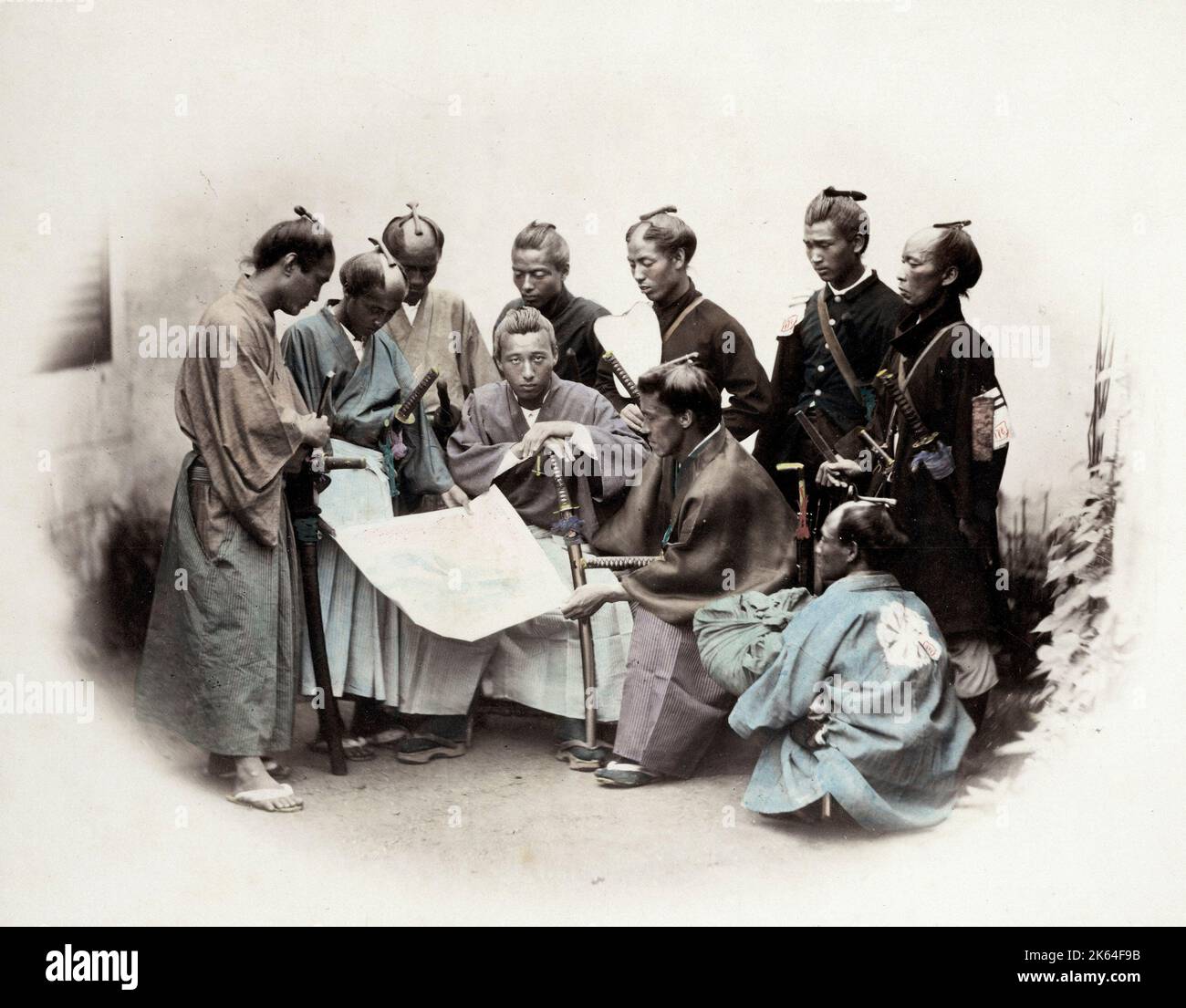 1860's Japan - portrait of a group of southern officers Felice or Felix Beato (1832 - 29 January 1909), Italian-British photographer working mostly in India, Japan, China Stock Photohttps://www.alamy.com/image-license-details/?v=1https://www.alamy.com/1860s-japan-portrait-of-a-group-of-southern-officers-felice-or-felix-beato-1832-29-january-1909-italian-british-photographer-working-mostly-in-india-japan-china-image485678071.html
1860's Japan - portrait of a group of southern officers Felice or Felix Beato (1832 - 29 January 1909), Italian-British photographer working mostly in India, Japan, China Stock Photohttps://www.alamy.com/image-license-details/?v=1https://www.alamy.com/1860s-japan-portrait-of-a-group-of-southern-officers-felice-or-felix-beato-1832-29-january-1909-italian-british-photographer-working-mostly-in-india-japan-china-image485678071.htmlRM2K64F9B–1860's Japan - portrait of a group of southern officers Felice or Felix Beato (1832 - 29 January 1909), Italian-British photographer working mostly in India, Japan, China
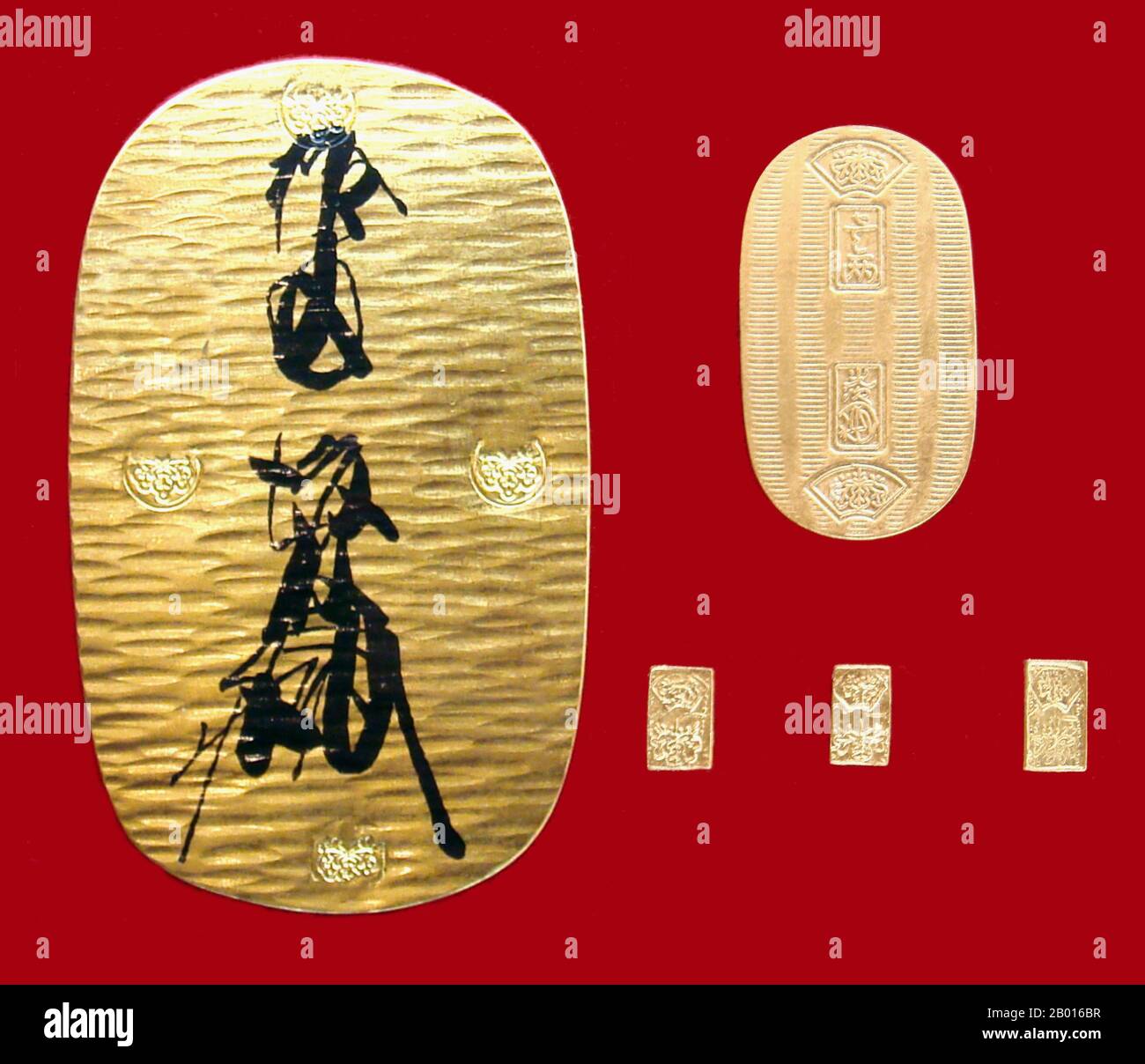 Japan: Tokugawa coinage: Oban, Koban, Ichibuban (1601-1695). Photo by PHGCOM (CC BY-SA 3.0 License). The Tokugawa shogunate, also known as the Tokugawa bakufu and the Edo bakufu, was a feudal regime of Japan established by Tokugawa Ieyasu and ruled by the shoguns of the Tokugawa family. This period is known as the Edo period and gets its name from the capital city, Edo, which is now called Tokyo, after the name was changed in 1864. The Tokugawa shogunate ruled from Edo Castle from 1603 until 1868, when it was finally abolished during the Meiji Restoration. Stock Photohttps://www.alamy.com/image-license-details/?v=1https://www.alamy.com/japan-tokugawa-coinage-oban-koban-ichibuban-1601-1695-photo-by-phgcom-cc-by-sa-30-license-the-tokugawa-shogunate-also-known-as-the-tokugawa-bakufu-and-the-edo-bakufu-was-a-feudal-regime-of-japan-established-by-tokugawa-ieyasu-and-ruled-by-the-shoguns-of-the-tokugawa-family-this-period-is-known-as-the-edo-period-and-gets-its-name-from-the-capital-city-edo-which-is-now-called-tokyo-after-the-name-was-changed-in-1864-the-tokugawa-shogunate-ruled-from-edo-castle-from-1603-until-1868-when-it-was-finally-abolished-during-the-meiji-restoration-image344234347.html
Japan: Tokugawa coinage: Oban, Koban, Ichibuban (1601-1695). Photo by PHGCOM (CC BY-SA 3.0 License). The Tokugawa shogunate, also known as the Tokugawa bakufu and the Edo bakufu, was a feudal regime of Japan established by Tokugawa Ieyasu and ruled by the shoguns of the Tokugawa family. This period is known as the Edo period and gets its name from the capital city, Edo, which is now called Tokyo, after the name was changed in 1864. The Tokugawa shogunate ruled from Edo Castle from 1603 until 1868, when it was finally abolished during the Meiji Restoration. Stock Photohttps://www.alamy.com/image-license-details/?v=1https://www.alamy.com/japan-tokugawa-coinage-oban-koban-ichibuban-1601-1695-photo-by-phgcom-cc-by-sa-30-license-the-tokugawa-shogunate-also-known-as-the-tokugawa-bakufu-and-the-edo-bakufu-was-a-feudal-regime-of-japan-established-by-tokugawa-ieyasu-and-ruled-by-the-shoguns-of-the-tokugawa-family-this-period-is-known-as-the-edo-period-and-gets-its-name-from-the-capital-city-edo-which-is-now-called-tokyo-after-the-name-was-changed-in-1864-the-tokugawa-shogunate-ruled-from-edo-castle-from-1603-until-1868-when-it-was-finally-abolished-during-the-meiji-restoration-image344234347.htmlRM2B016BR–Japan: Tokugawa coinage: Oban, Koban, Ichibuban (1601-1695). Photo by PHGCOM (CC BY-SA 3.0 License). The Tokugawa shogunate, also known as the Tokugawa bakufu and the Edo bakufu, was a feudal regime of Japan established by Tokugawa Ieyasu and ruled by the shoguns of the Tokugawa family. This period is known as the Edo period and gets its name from the capital city, Edo, which is now called Tokyo, after the name was changed in 1864. The Tokugawa shogunate ruled from Edo Castle from 1603 until 1868, when it was finally abolished during the Meiji Restoration.
 1860's Japan - portrait of a group of southern officers Stock Photohttps://www.alamy.com/image-license-details/?v=1https://www.alamy.com/stock-photo-1860s-japan-portrait-of-a-group-of-southern-officers-174088943.html
1860's Japan - portrait of a group of southern officers Stock Photohttps://www.alamy.com/image-license-details/?v=1https://www.alamy.com/stock-photo-1860s-japan-portrait-of-a-group-of-southern-officers-174088943.htmlRMM36C67–1860's Japan - portrait of a group of southern officers
 Japan: Tokugawa coinage: Oban, Koban, Ichibuban (1601-1695). Photo by PHGCOM (CC BY-SA 3.0 License). The Tokugawa shogunate, also known as the Tokugawa bakufu and the Edo bakufu, was a feudal regime of Japan established by Tokugawa Ieyasu and ruled by the shoguns of the Tokugawa family. This period is known as the Edo period and gets its name from the capital city, Edo, which is now called Tokyo, after the name was changed in 1864. The Tokugawa shogunate ruled from Edo Castle from 1603 until 1868, when it was finally abolished during the Meiji Restoration. Stock Photohttps://www.alamy.com/image-license-details/?v=1https://www.alamy.com/japan-tokugawa-coinage-oban-koban-ichibuban-1601-1695-photo-by-phgcom-cc-by-sa-30-license-the-tokugawa-shogunate-also-known-as-the-tokugawa-bakufu-and-the-edo-bakufu-was-a-feudal-regime-of-japan-established-by-tokugawa-ieyasu-and-ruled-by-the-shoguns-of-the-tokugawa-family-this-period-is-known-as-the-edo-period-and-gets-its-name-from-the-capital-city-edo-which-is-now-called-tokyo-after-the-name-was-changed-in-1864-the-tokugawa-shogunate-ruled-from-edo-castle-from-1603-until-1868-when-it-was-finally-abolished-during-the-meiji-restoration-image344234361.html
Japan: Tokugawa coinage: Oban, Koban, Ichibuban (1601-1695). Photo by PHGCOM (CC BY-SA 3.0 License). The Tokugawa shogunate, also known as the Tokugawa bakufu and the Edo bakufu, was a feudal regime of Japan established by Tokugawa Ieyasu and ruled by the shoguns of the Tokugawa family. This period is known as the Edo period and gets its name from the capital city, Edo, which is now called Tokyo, after the name was changed in 1864. The Tokugawa shogunate ruled from Edo Castle from 1603 until 1868, when it was finally abolished during the Meiji Restoration. Stock Photohttps://www.alamy.com/image-license-details/?v=1https://www.alamy.com/japan-tokugawa-coinage-oban-koban-ichibuban-1601-1695-photo-by-phgcom-cc-by-sa-30-license-the-tokugawa-shogunate-also-known-as-the-tokugawa-bakufu-and-the-edo-bakufu-was-a-feudal-regime-of-japan-established-by-tokugawa-ieyasu-and-ruled-by-the-shoguns-of-the-tokugawa-family-this-period-is-known-as-the-edo-period-and-gets-its-name-from-the-capital-city-edo-which-is-now-called-tokyo-after-the-name-was-changed-in-1864-the-tokugawa-shogunate-ruled-from-edo-castle-from-1603-until-1868-when-it-was-finally-abolished-during-the-meiji-restoration-image344234361.htmlRM2B016C9–Japan: Tokugawa coinage: Oban, Koban, Ichibuban (1601-1695). Photo by PHGCOM (CC BY-SA 3.0 License). The Tokugawa shogunate, also known as the Tokugawa bakufu and the Edo bakufu, was a feudal regime of Japan established by Tokugawa Ieyasu and ruled by the shoguns of the Tokugawa family. This period is known as the Edo period and gets its name from the capital city, Edo, which is now called Tokyo, after the name was changed in 1864. The Tokugawa shogunate ruled from Edo Castle from 1603 until 1868, when it was finally abolished during the Meiji Restoration.
 Tokyo, Japan - Jizo Statues at Zojoji Temple in Tokyo, Japan. Zojoji Temple is notable for its relationship with the Tokugawa clan. Stock Photohttps://www.alamy.com/image-license-details/?v=1https://www.alamy.com/tokyo-japan-jizo-statues-at-zojoji-temple-in-tokyo-japan-zojoji-temple-is-notable-for-its-relationship-with-the-tokugawa-clan-image369151371.html
Tokyo, Japan - Jizo Statues at Zojoji Temple in Tokyo, Japan. Zojoji Temple is notable for its relationship with the Tokugawa clan. Stock Photohttps://www.alamy.com/image-license-details/?v=1https://www.alamy.com/tokyo-japan-jizo-statues-at-zojoji-temple-in-tokyo-japan-zojoji-temple-is-notable-for-its-relationship-with-the-tokugawa-clan-image369151371.htmlRF2CCG89F–Tokyo, Japan - Jizo Statues at Zojoji Temple in Tokyo, Japan. Zojoji Temple is notable for its relationship with the Tokugawa clan.
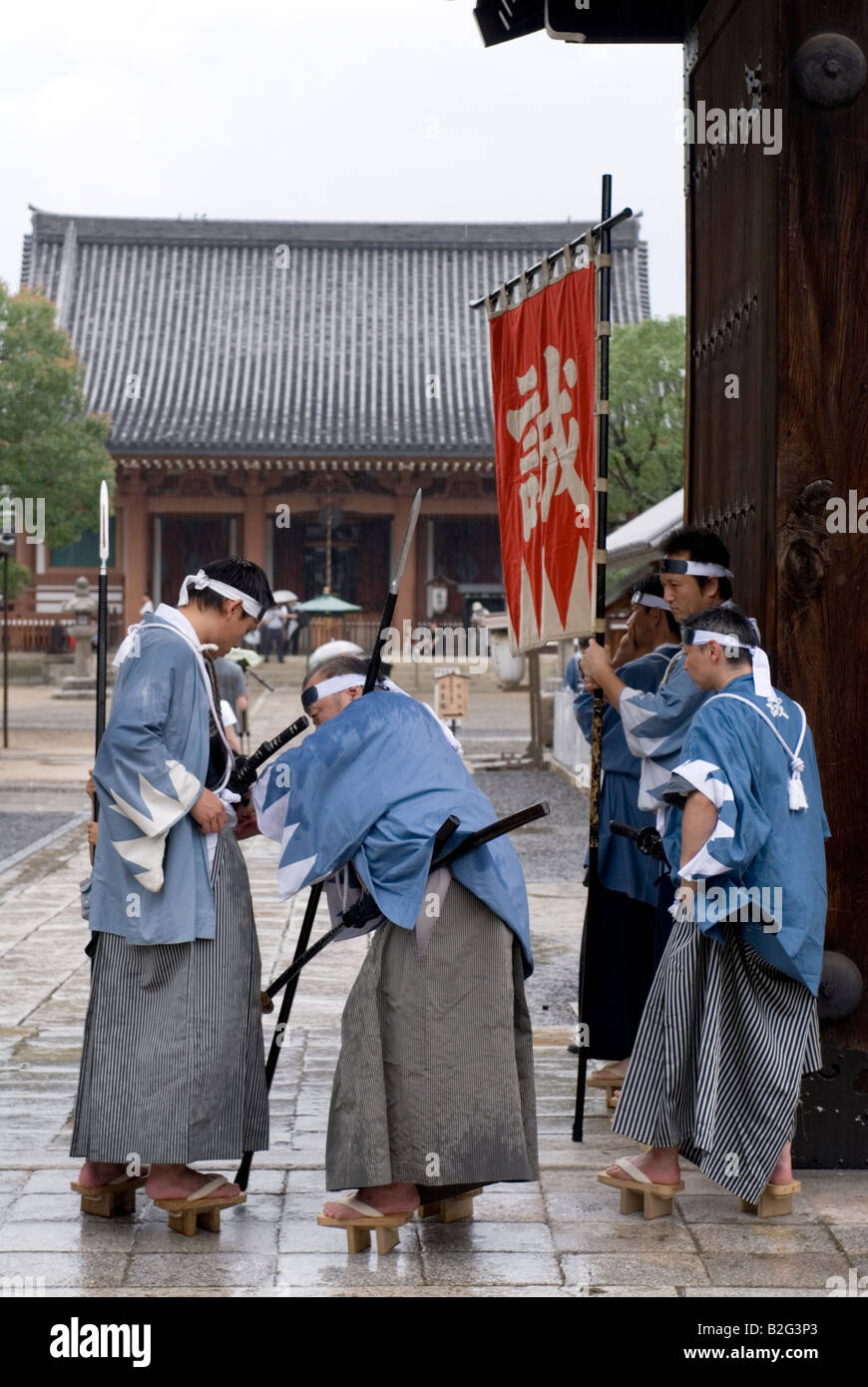 Samurai warriors from elite Shinsengumi clan in Kyoto wearing unique blue and white kimono standing at gate of Mibu Temple Stock Photohttps://www.alamy.com/image-license-details/?v=1https://www.alamy.com/stock-photo-samurai-warriors-from-elite-shinsengumi-clan-in-kyoto-wearing-unique-18793883.html
Samurai warriors from elite Shinsengumi clan in Kyoto wearing unique blue and white kimono standing at gate of Mibu Temple Stock Photohttps://www.alamy.com/image-license-details/?v=1https://www.alamy.com/stock-photo-samurai-warriors-from-elite-shinsengumi-clan-in-kyoto-wearing-unique-18793883.htmlRMB2G3P3–Samurai warriors from elite Shinsengumi clan in Kyoto wearing unique blue and white kimono standing at gate of Mibu Temple
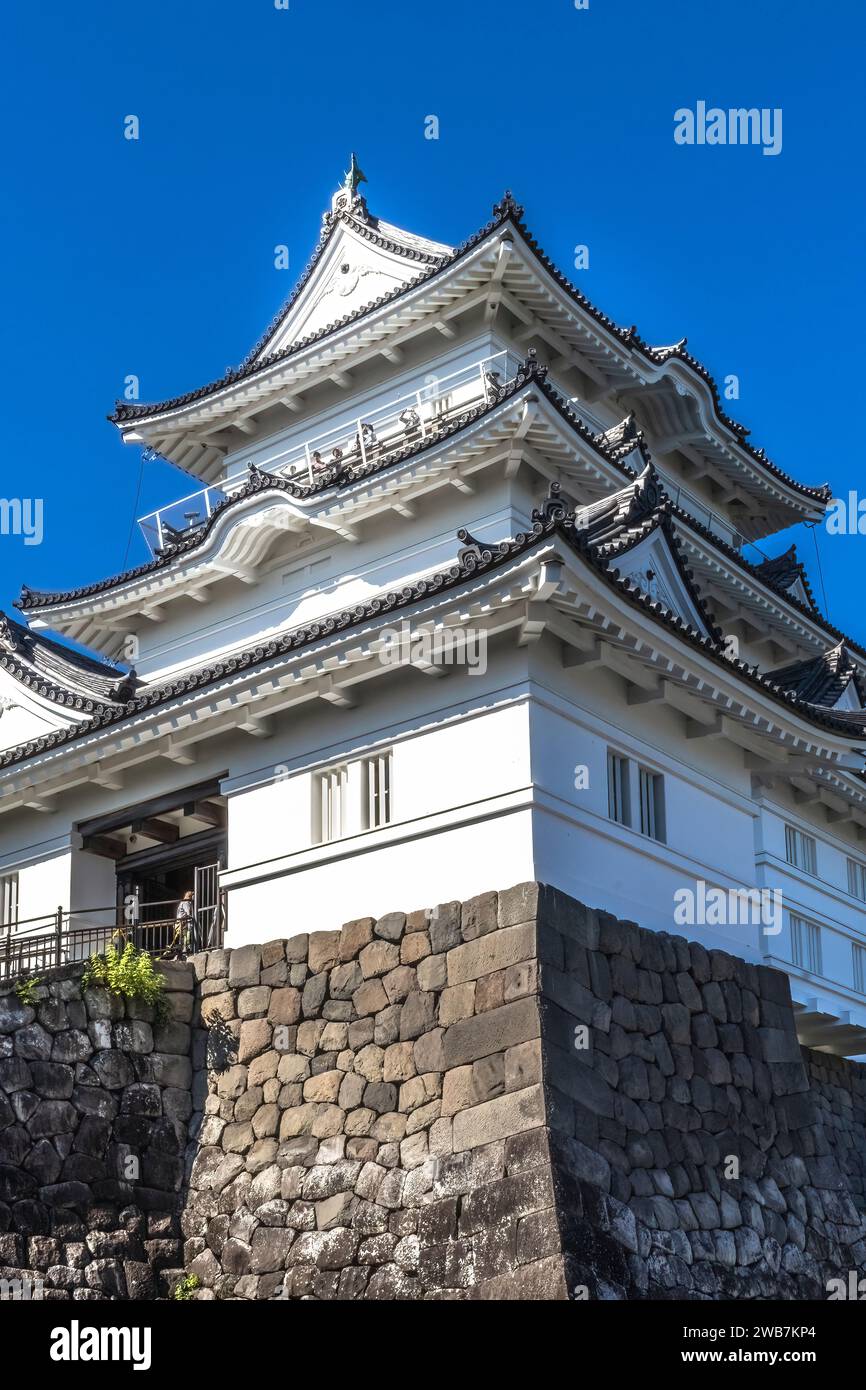 Hojo Castle Odawara Kanagawa Japan. Hojo Clan controlled castle to 1590, when Heideyoshi defeated the Hojo. Castle was given to Tokugawa Ieyasu. Cast Stock Photohttps://www.alamy.com/image-license-details/?v=1https://www.alamy.com/hojo-castle-odawara-kanagawa-japan-hojo-clan-controlled-castle-to-1590-when-heideyoshi-defeated-the-hojo-castle-was-given-to-tokugawa-ieyasu-cast-image592082908.html
Hojo Castle Odawara Kanagawa Japan. Hojo Clan controlled castle to 1590, when Heideyoshi defeated the Hojo. Castle was given to Tokugawa Ieyasu. Cast Stock Photohttps://www.alamy.com/image-license-details/?v=1https://www.alamy.com/hojo-castle-odawara-kanagawa-japan-hojo-clan-controlled-castle-to-1590-when-heideyoshi-defeated-the-hojo-castle-was-given-to-tokugawa-ieyasu-cast-image592082908.htmlRF2WB7KP4–Hojo Castle Odawara Kanagawa Japan. Hojo Clan controlled castle to 1590, when Heideyoshi defeated the Hojo. Castle was given to Tokugawa Ieyasu. Cast
 Koyasan, Koya, Ito District, Wakayama, Japan, 2022/03/05 , Tokugawa Clan Mausoleum. From grandfather to son. Set apart from the other religious sites Stock Photohttps://www.alamy.com/image-license-details/?v=1https://www.alamy.com/koyasan-koya-ito-district-wakayama-japan-20220305-tokugawa-clan-mausoleum-from-grandfather-to-son-set-apart-from-the-other-religious-sites-image470620504.html
Koyasan, Koya, Ito District, Wakayama, Japan, 2022/03/05 , Tokugawa Clan Mausoleum. From grandfather to son. Set apart from the other religious sites Stock Photohttps://www.alamy.com/image-license-details/?v=1https://www.alamy.com/koyasan-koya-ito-district-wakayama-japan-20220305-tokugawa-clan-mausoleum-from-grandfather-to-son-set-apart-from-the-other-religious-sites-image470620504.htmlRF2J9JH74–Koyasan, Koya, Ito District, Wakayama, Japan, 2022/03/05 , Tokugawa Clan Mausoleum. From grandfather to son. Set apart from the other religious sites
 Roof tile of Tokiwagi-mon Gate, Odawara Castle Park, Odawara City, Kanagawa, Japan. Mitubaoi design (family crest of Tokugawa family) is seen. Stock Photohttps://www.alamy.com/image-license-details/?v=1https://www.alamy.com/roof-tile-of-tokiwagi-mon-gate-odawara-castle-park-odawara-city-kanagawa-japan-mitubaoi-design-family-crest-of-tokugawa-family-is-seen-image457101962.html
Roof tile of Tokiwagi-mon Gate, Odawara Castle Park, Odawara City, Kanagawa, Japan. Mitubaoi design (family crest of Tokugawa family) is seen. Stock Photohttps://www.alamy.com/image-license-details/?v=1https://www.alamy.com/roof-tile-of-tokiwagi-mon-gate-odawara-castle-park-odawara-city-kanagawa-japan-mitubaoi-design-family-crest-of-tokugawa-family-is-seen-image457101962.htmlRM2HFJP62–Roof tile of Tokiwagi-mon Gate, Odawara Castle Park, Odawara City, Kanagawa, Japan. Mitubaoi design (family crest of Tokugawa family) is seen.
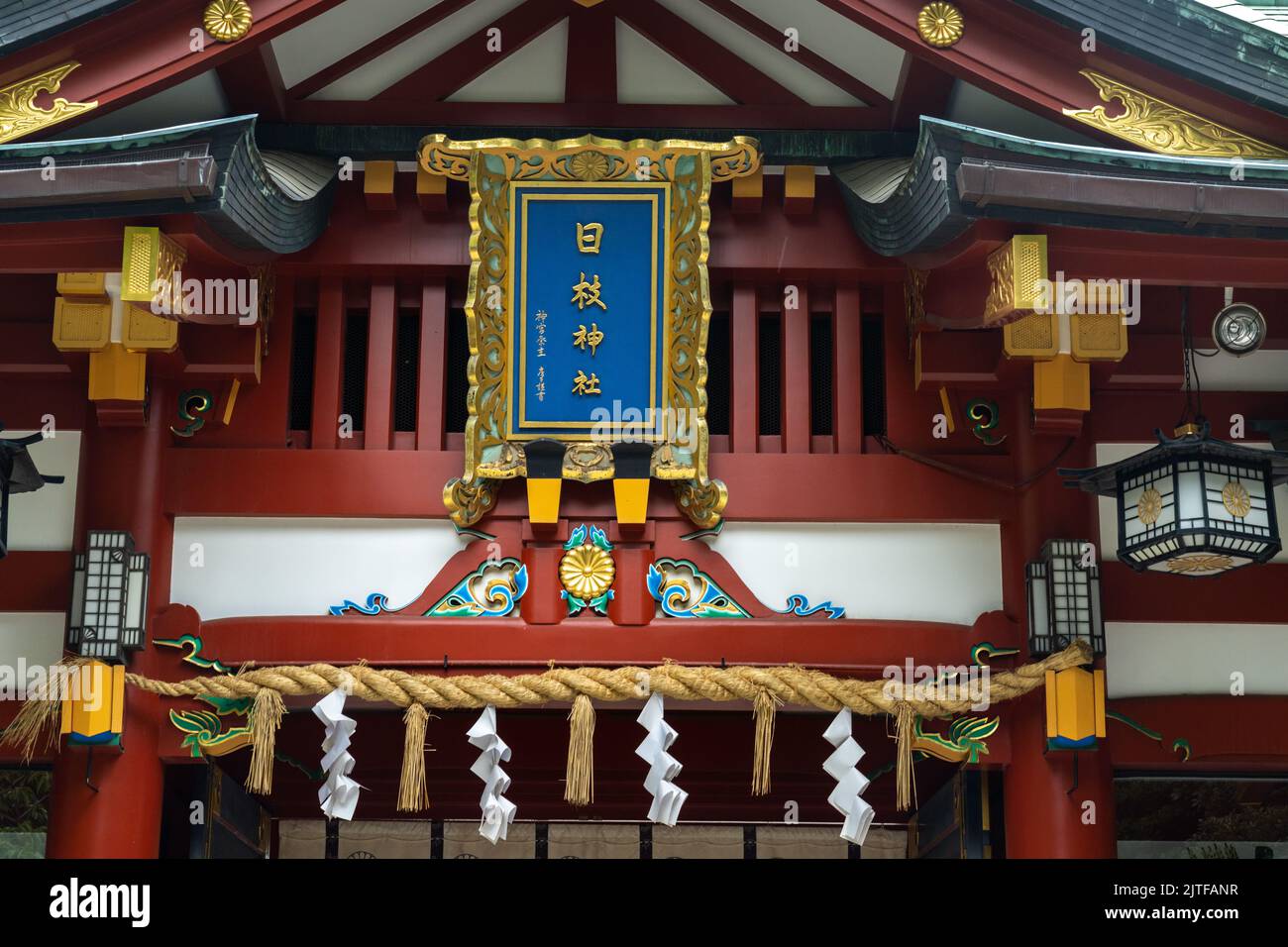 haiden worship hall Stock Photohttps://www.alamy.com/image-license-details/?v=1https://www.alamy.com/haiden-worship-hall-image479769411.html
haiden worship hall Stock Photohttps://www.alamy.com/image-license-details/?v=1https://www.alamy.com/haiden-worship-hall-image479769411.htmlRM2JTFANR–haiden worship hall
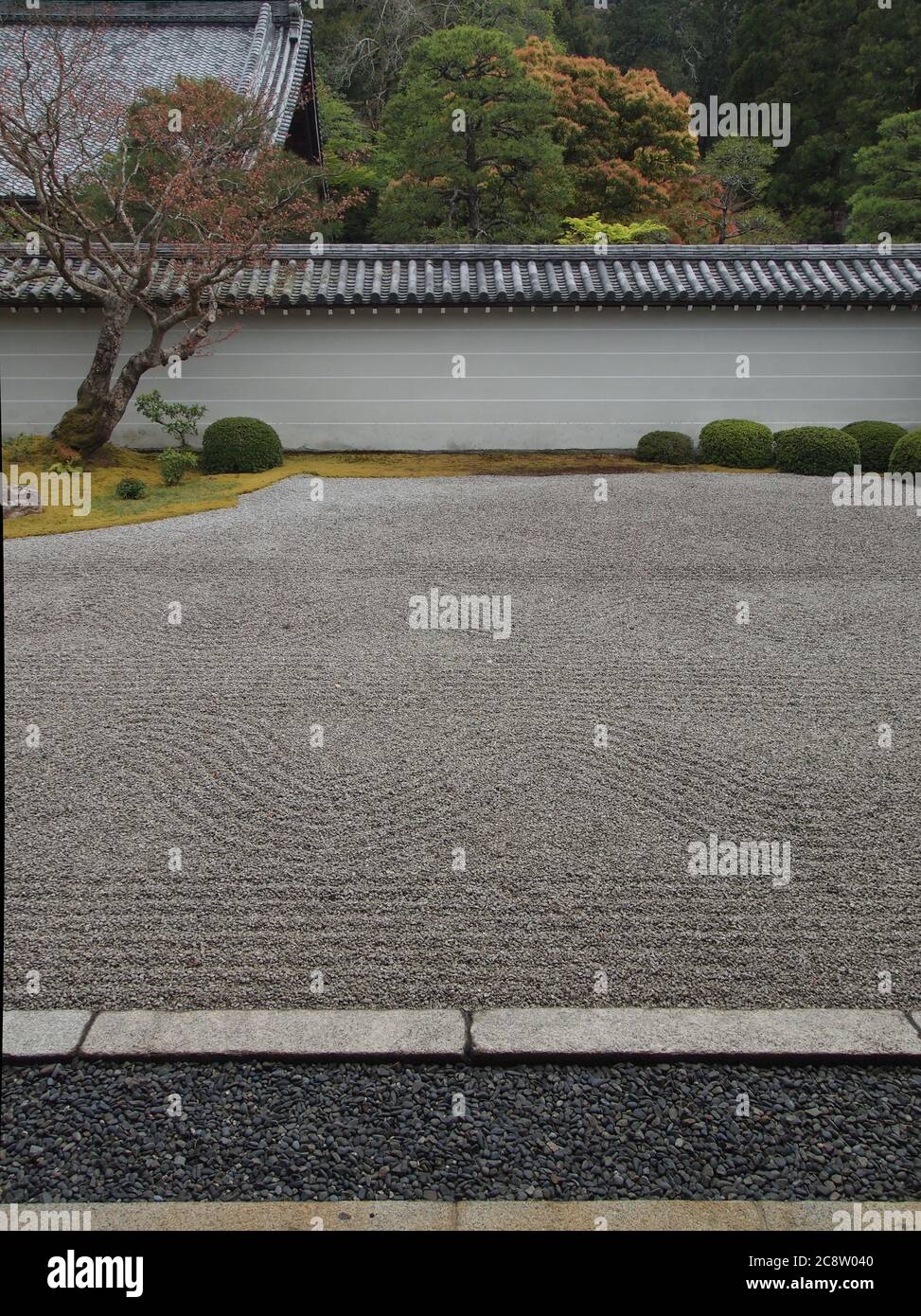 Nanzenji Temple (南禅寺) Hojo Rock Garden. Kyoto Stock Photohttps://www.alamy.com/image-license-details/?v=1https://www.alamy.com/nanzenji-temple-hojo-rock-garden-kyoto-image366883888.html
Nanzenji Temple (南禅寺) Hojo Rock Garden. Kyoto Stock Photohttps://www.alamy.com/image-license-details/?v=1https://www.alamy.com/nanzenji-temple-hojo-rock-garden-kyoto-image366883888.htmlRF2C8W040–Nanzenji Temple (南禅寺) Hojo Rock Garden. Kyoto
 Tokugawa Ietsuga Playing at Archery, 1875. From Brief Account of the Rulers of the Tokugawa Clan. Stock Photohttps://www.alamy.com/image-license-details/?v=1https://www.alamy.com/tokugawa-ietsuga-playing-at-archery-1875-from-brief-account-of-the-rulers-of-the-tokugawa-clan-image568854385.html
Tokugawa Ietsuga Playing at Archery, 1875. From Brief Account of the Rulers of the Tokugawa Clan. Stock Photohttps://www.alamy.com/image-license-details/?v=1https://www.alamy.com/tokugawa-ietsuga-playing-at-archery-1875-from-brief-account-of-the-rulers-of-the-tokugawa-clan-image568854385.htmlRM2T1DFG1–Tokugawa Ietsuga Playing at Archery, 1875. From Brief Account of the Rulers of the Tokugawa Clan.
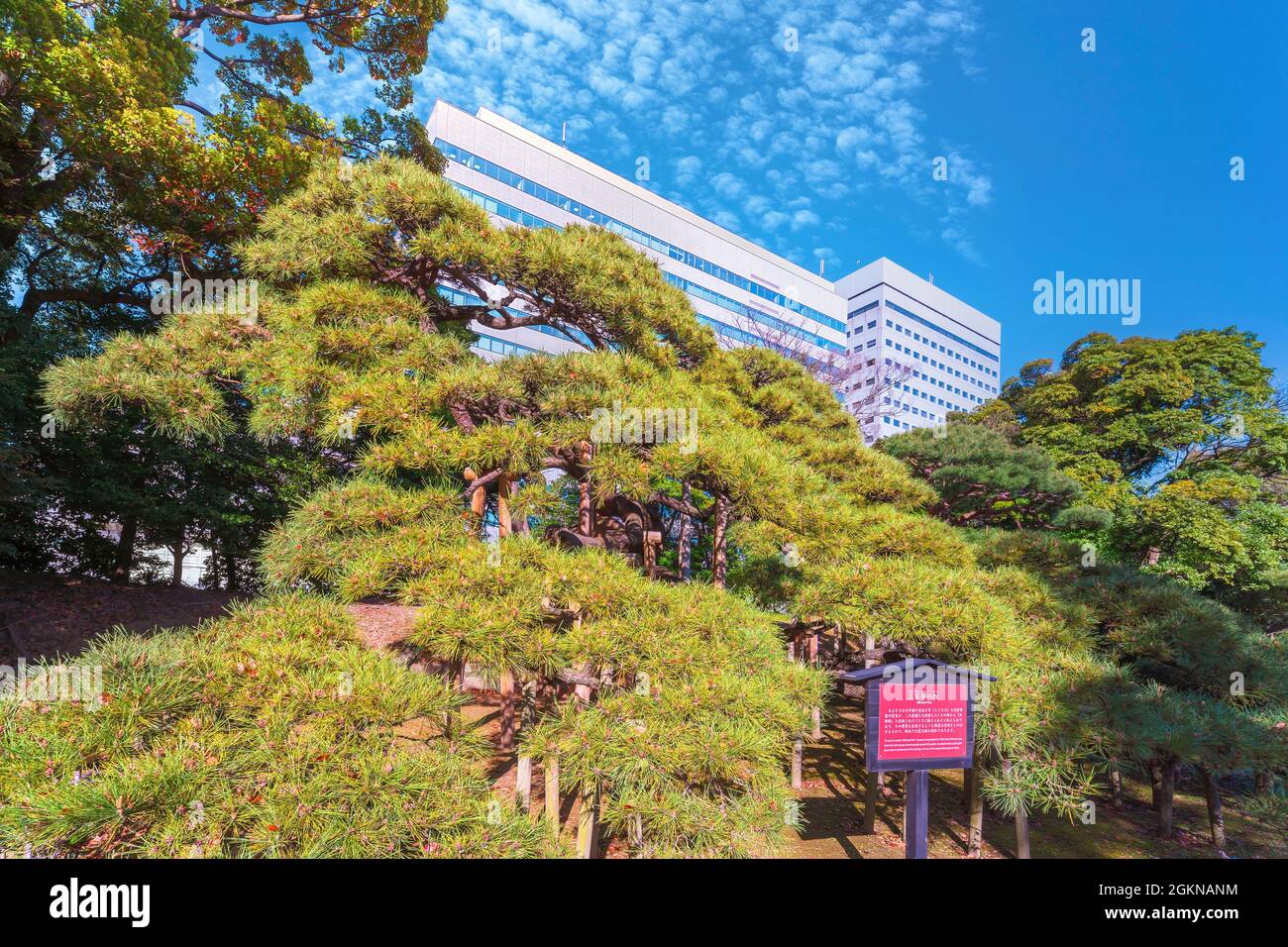 tokyo, japan - april 09 2021: Side view of the giant black pine called 300-year pine offered by the sixth Shogun Tokugawa to the Japanese Hama-Rikyu g Stock Photohttps://www.alamy.com/image-license-details/?v=1https://www.alamy.com/tokyo-japan-april-09-2021-side-view-of-the-giant-black-pine-called-300-year-pine-offered-by-the-sixth-shogun-tokugawa-to-the-japanese-hama-rikyu-g-image442407104.html
tokyo, japan - april 09 2021: Side view of the giant black pine called 300-year pine offered by the sixth Shogun Tokugawa to the Japanese Hama-Rikyu g Stock Photohttps://www.alamy.com/image-license-details/?v=1https://www.alamy.com/tokyo-japan-april-09-2021-side-view-of-the-giant-black-pine-called-300-year-pine-offered-by-the-sixth-shogun-tokugawa-to-the-japanese-hama-rikyu-g-image442407104.htmlRF2GKNANM–tokyo, japan - april 09 2021: Side view of the giant black pine called 300-year pine offered by the sixth Shogun Tokugawa to the Japanese Hama-Rikyu g
 Samurai armor with white lacing and helmet decorated with curls, owned by the Owari Tokugawa clan, Edo period, 17th century Stock Photohttps://www.alamy.com/image-license-details/?v=1https://www.alamy.com/samurai-armor-with-white-lacing-and-helmet-decorated-with-curls-owned-by-the-owari-tokugawa-clan-edo-period-17th-century-image327645398.html
Samurai armor with white lacing and helmet decorated with curls, owned by the Owari Tokugawa clan, Edo period, 17th century Stock Photohttps://www.alamy.com/image-license-details/?v=1https://www.alamy.com/samurai-armor-with-white-lacing-and-helmet-decorated-with-curls-owned-by-the-owari-tokugawa-clan-edo-period-17th-century-image327645398.htmlRF2A11F1A–Samurai armor with white lacing and helmet decorated with curls, owned by the Owari Tokugawa clan, Edo period, 17th century
 Feudal castle of the proud Shoguns, Osaka, Japan, 1904. Artist: Underwood & Underwood Stock Photohttps://www.alamy.com/image-license-details/?v=1https://www.alamy.com/stock-photo-feudal-castle-of-the-proud-shoguns-osaka-japan-1904-artist-underwood-24613141.html
Feudal castle of the proud Shoguns, Osaka, Japan, 1904. Artist: Underwood & Underwood Stock Photohttps://www.alamy.com/image-license-details/?v=1https://www.alamy.com/stock-photo-feudal-castle-of-the-proud-shoguns-osaka-japan-1904-artist-underwood-24613141.htmlRMBC168N–Feudal castle of the proud Shoguns, Osaka, Japan, 1904. Artist: Underwood & Underwood
 Koishikawa Kōrakuen Garden Stock Photohttps://www.alamy.com/image-license-details/?v=1https://www.alamy.com/stock-photo-koishikawa-krakuen-garden-140482266.html
Koishikawa Kōrakuen Garden Stock Photohttps://www.alamy.com/image-license-details/?v=1https://www.alamy.com/stock-photo-koishikawa-krakuen-garden-140482266.htmlRFJ4FEFP–Koishikawa Kōrakuen Garden
 Osaka, Japan - 28 Dec 2019: Historic reconstruction of ancient japanese warriors on a battlefield in Osaka castle. Stock Photohttps://www.alamy.com/image-license-details/?v=1https://www.alamy.com/osaka-japan-28-dec-2019-historic-reconstruction-of-ancient-japanese-warriors-on-a-battlefield-in-osaka-castle-image352896653.html
Osaka, Japan - 28 Dec 2019: Historic reconstruction of ancient japanese warriors on a battlefield in Osaka castle. Stock Photohttps://www.alamy.com/image-license-details/?v=1https://www.alamy.com/osaka-japan-28-dec-2019-historic-reconstruction-of-ancient-japanese-warriors-on-a-battlefield-in-osaka-castle-image352896653.htmlRF2BE3R7W–Osaka, Japan - 28 Dec 2019: Historic reconstruction of ancient japanese warriors on a battlefield in Osaka castle.
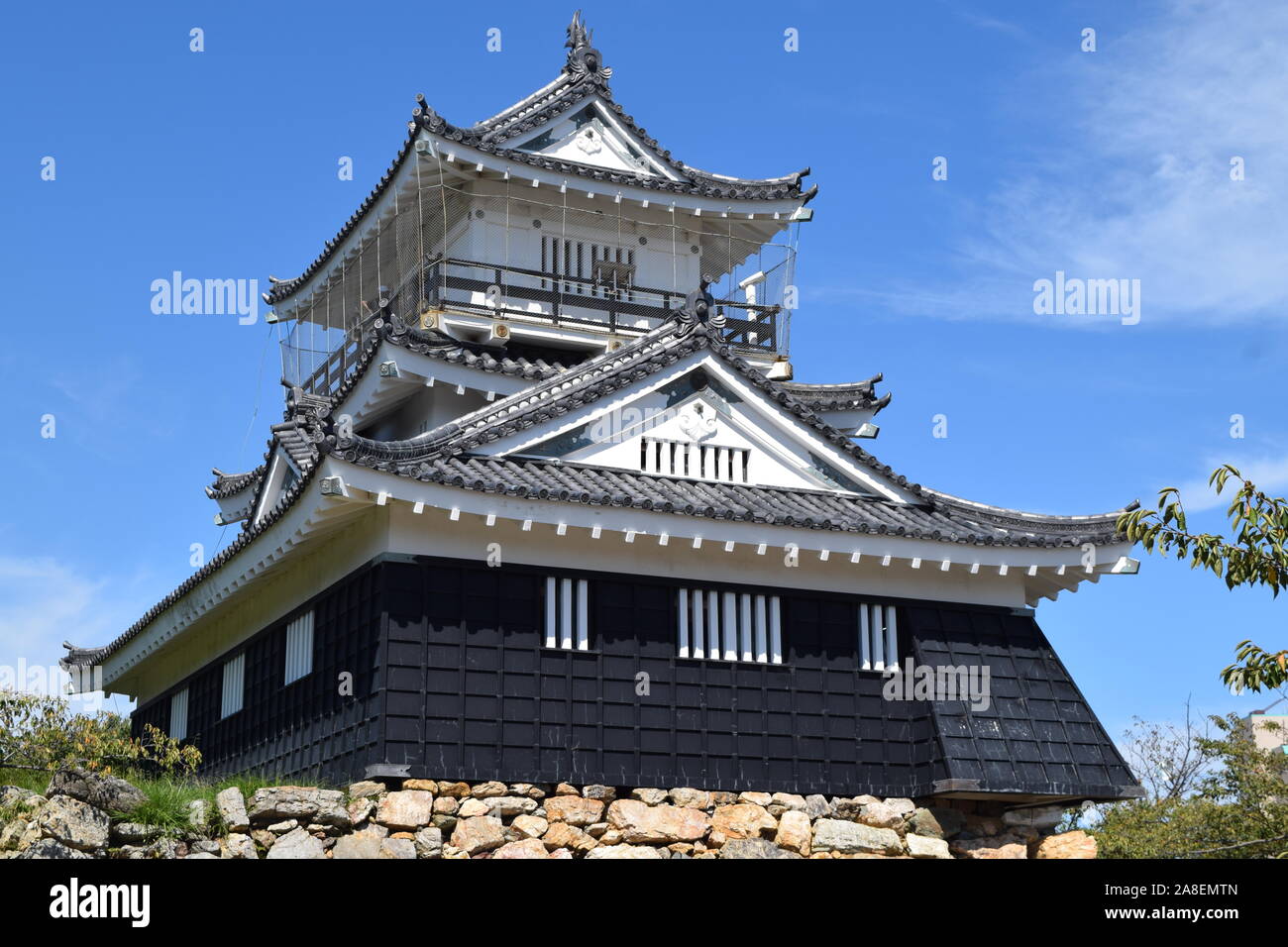 Hamamatsu Castle in the Shizuoka Prefecture in Japan Stock Photohttps://www.alamy.com/image-license-details/?v=1https://www.alamy.com/hamamatsu-castle-in-the-shizuoka-prefecture-in-japan-image332237941.html
Hamamatsu Castle in the Shizuoka Prefecture in Japan Stock Photohttps://www.alamy.com/image-license-details/?v=1https://www.alamy.com/hamamatsu-castle-in-the-shizuoka-prefecture-in-japan-image332237941.htmlRF2A8EMTN–Hamamatsu Castle in the Shizuoka Prefecture in Japan
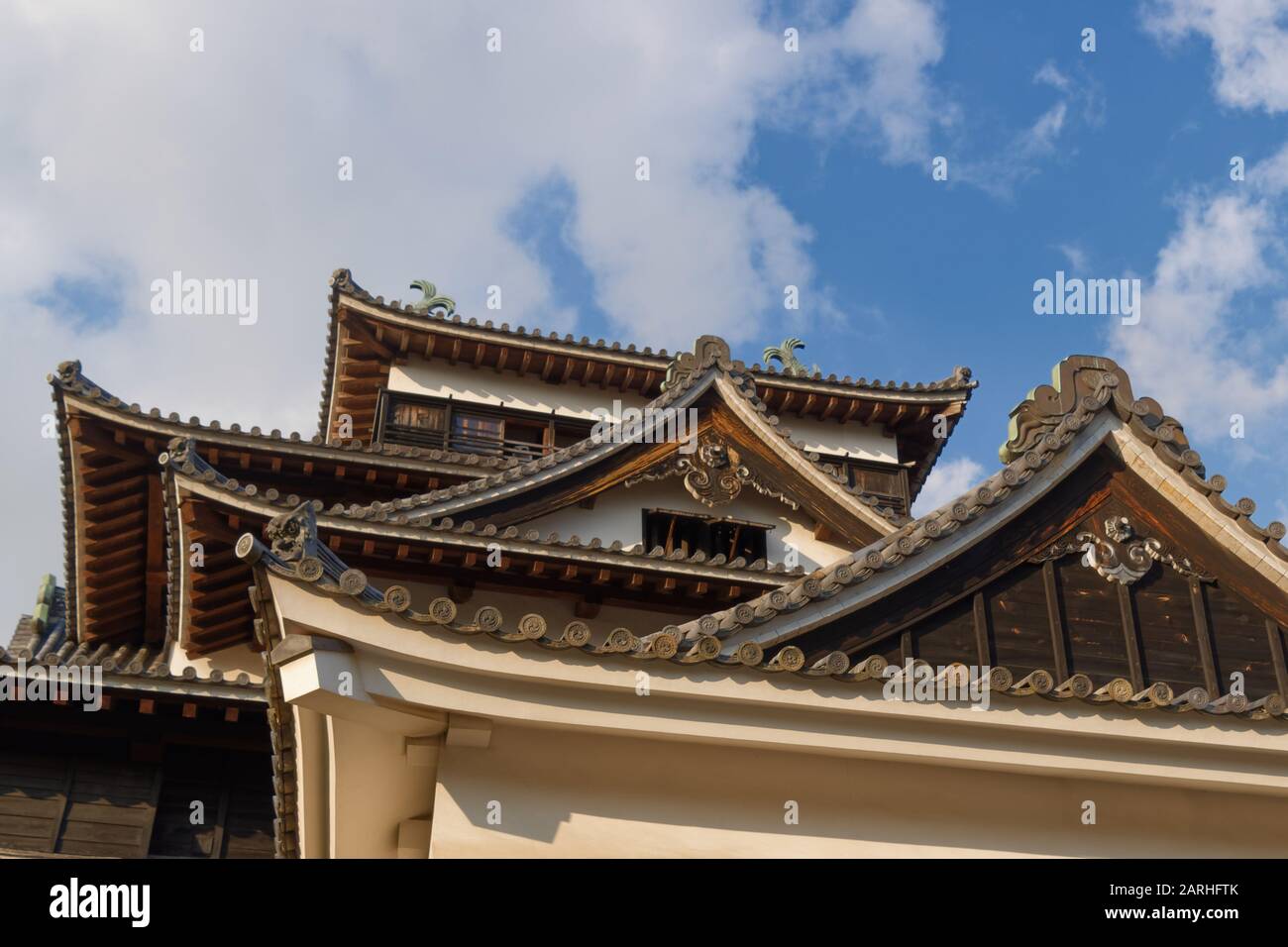 Matsue Castle, also called the black castle, at sunset. Matsue Castle is one of only a very few original castles in Japan. Stock Photohttps://www.alamy.com/image-license-details/?v=1https://www.alamy.com/matsue-castle-also-called-the-black-castle-at-sunset-matsue-castle-is-one-of-only-a-very-few-original-castles-in-japan-image341519715.html
Matsue Castle, also called the black castle, at sunset. Matsue Castle is one of only a very few original castles in Japan. Stock Photohttps://www.alamy.com/image-license-details/?v=1https://www.alamy.com/matsue-castle-also-called-the-black-castle-at-sunset-matsue-castle-is-one-of-only-a-very-few-original-castles-in-japan-image341519715.htmlRF2ARHFTK–Matsue Castle, also called the black castle, at sunset. Matsue Castle is one of only a very few original castles in Japan.
 Street scene with snow, Hakodate, Hokkaido, Japan 18 Feb 2019 Stock Photohttps://www.alamy.com/image-license-details/?v=1https://www.alamy.com/street-scene-with-snow-hakodate-hokkaido-japan-18-feb-2019-image370695789.html
Street scene with snow, Hakodate, Hokkaido, Japan 18 Feb 2019 Stock Photohttps://www.alamy.com/image-license-details/?v=1https://www.alamy.com/street-scene-with-snow-hakodate-hokkaido-japan-18-feb-2019-image370695789.htmlRM2CF2J79–Street scene with snow, Hakodate, Hokkaido, Japan 18 Feb 2019
 Japan, Nagoya, Nagoya Castle travel landmark vector illustration Stock Vectorhttps://www.alamy.com/image-license-details/?v=1https://www.alamy.com/japan-nagoya-nagoya-castle-travel-landmark-vector-illustration-image544513205.html
Japan, Nagoya, Nagoya Castle travel landmark vector illustration Stock Vectorhttps://www.alamy.com/image-license-details/?v=1https://www.alamy.com/japan-nagoya-nagoya-castle-travel-landmark-vector-illustration-image544513205.htmlRF2PHTM45–Japan, Nagoya, Nagoya Castle travel landmark vector illustration
